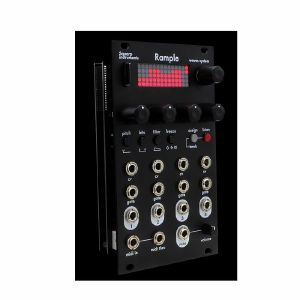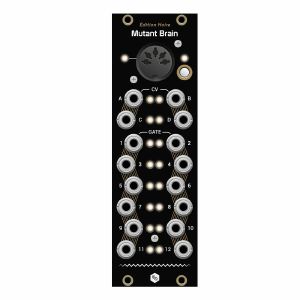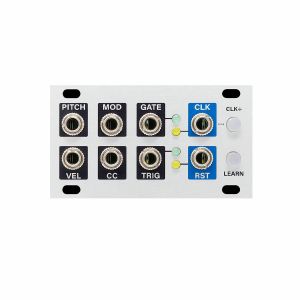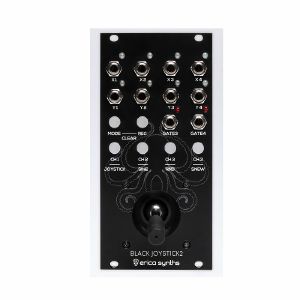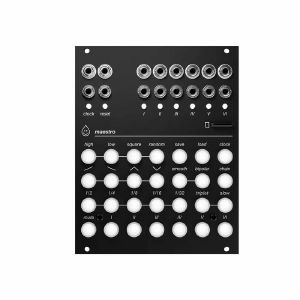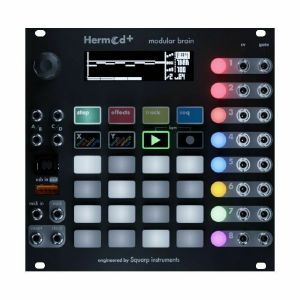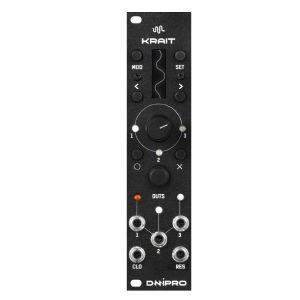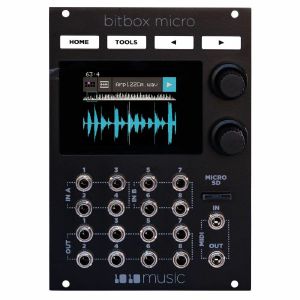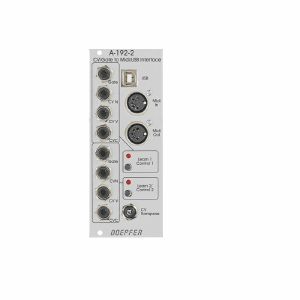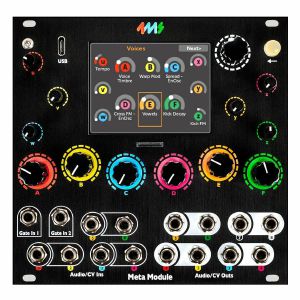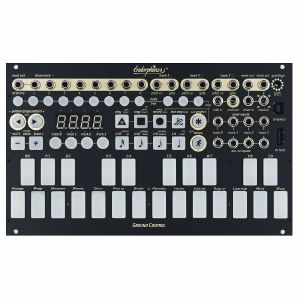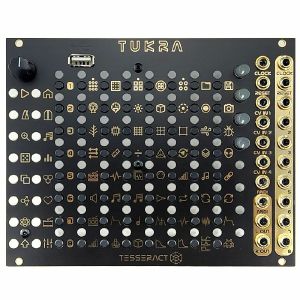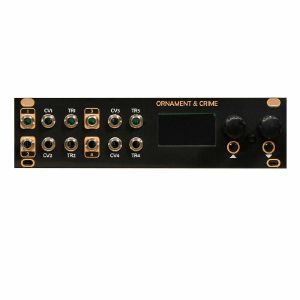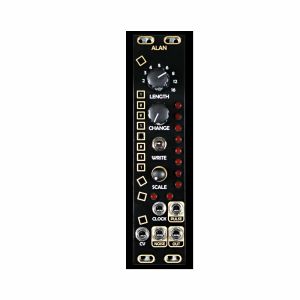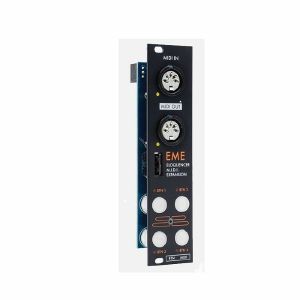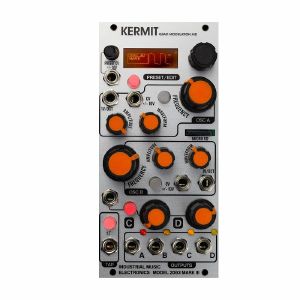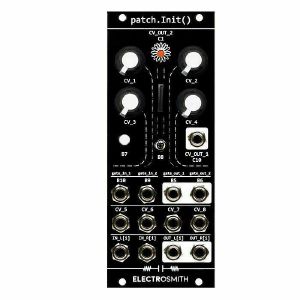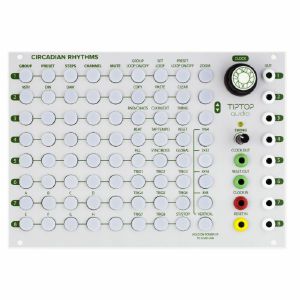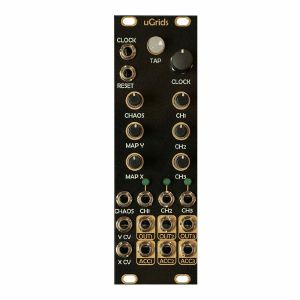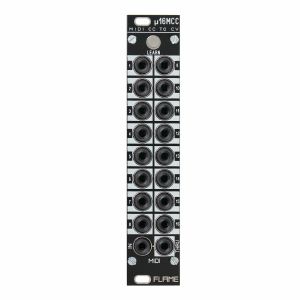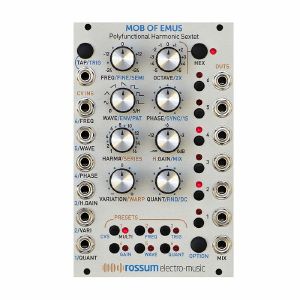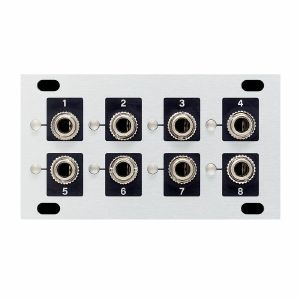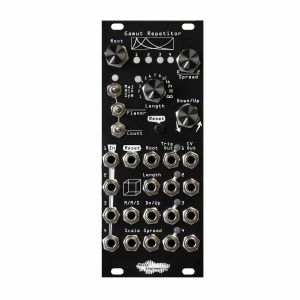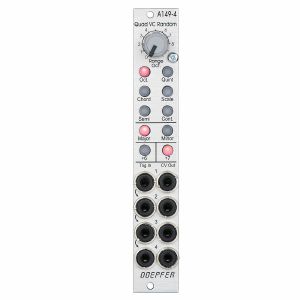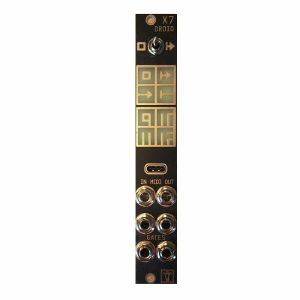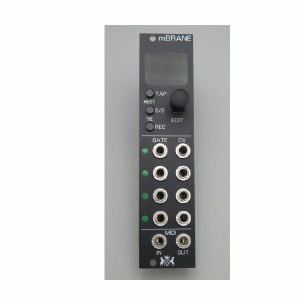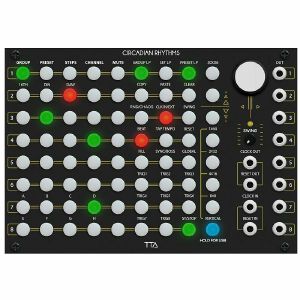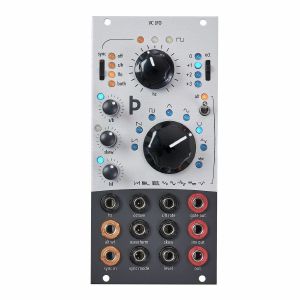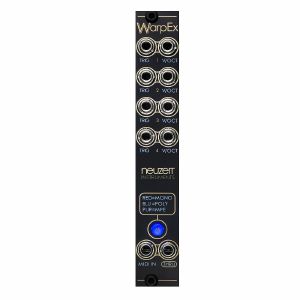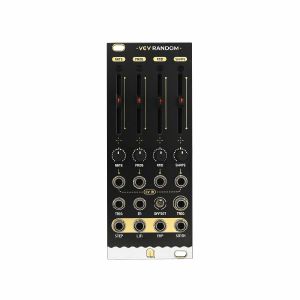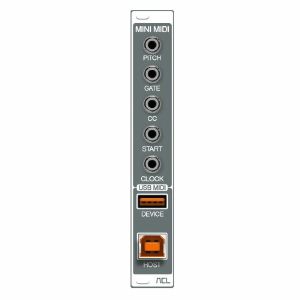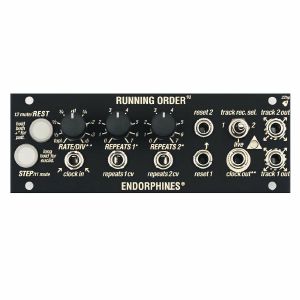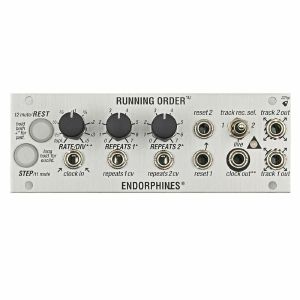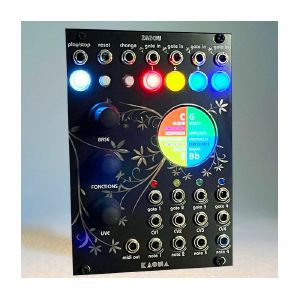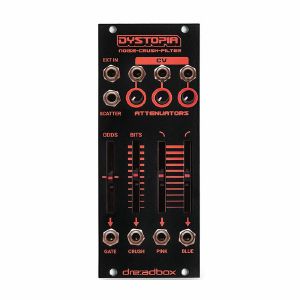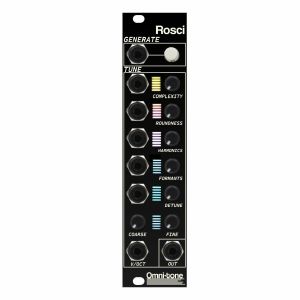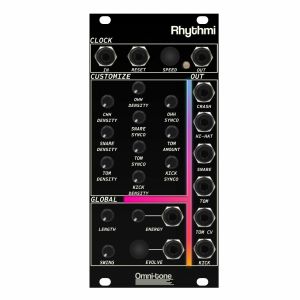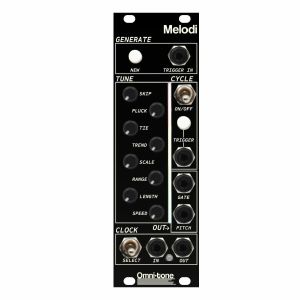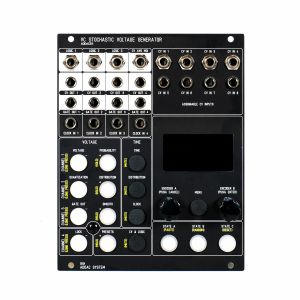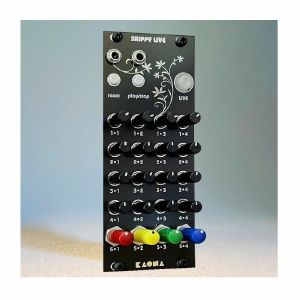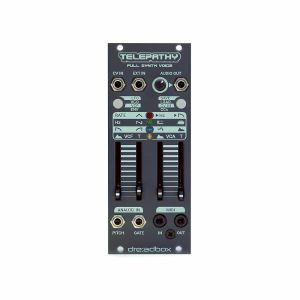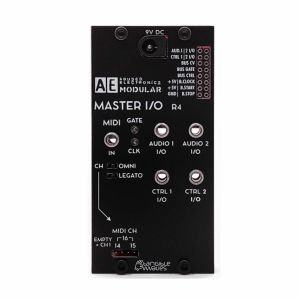Filter
Featured
Price
Tags
33
Random module
26
MIDI interface module
24
Sequencer module
17
Clock generator module
12
CV modulation module
10
LFO module
7
Quantizer module
7
Utility module
6
Controller module
6
Expander module
6
Oscillator module
5
Clock modulator module
5
Noise module
5
Sample & hold module
4
Drum module
4
Filter module
3
Effects module
3
Envelope generator module
3
Function generator module
3
Sampling module
3
Synth voice module
2
Distortion module
2
Interface module
1
Equaliser module
1
Logic module
1
Looper module
1
Power module
1
Ring modulator module
1
Slew limiter module
1
VCA module
Synth modules
The Eurorack modular synth format is one of the most exciting areas of music technology. Pioneered by Doepfer, there are now hundreds of brands offering compatible modules of all varieties. You can combine your choice of the best oscillators, filters and much more in order to create a unique, bespoke synth setup which perfectly suits your needs.
Eurorack modules offer the biggest range of options you can imagine, from basic analogue modules which replicate the sound of classic vintage synths, through to digital modules which allow you to explore completely new approaches to making music.
Whether you’re a beginner or a more experienced modular head, you can take your pick of the best modules from leading brands including Mutable Instruments and ALM Busy Circuits.
Our range also includes accessories, cases, patch cables and much more, allowing you to build and customise your perfect modular synth setup.

Squarp Instruments Rample Wave System 4-Voice Sample Player & Audio Processor Module (sampling/drum synth module)
Cat: 783294 Rel: 09 Sep 20
Sample player & audio processor module
Notes: Nicely thought out four-voice sample playback module from Parisian innovators Squarp. Load up a microSD card with samples (up to 2600 kits), then trigger and process. Neat.
** Firmware update- February 2024 ***
Thanks to a major rework of the OS, this upgrade includes an overall better sound quality and an improved latency.
Moreover, the effects Freeze and Bitcrusher have been redesigned, and the parameters Start and Sample Length are now exponential to facilitate the fine-editing of your samples.
Supplier's Notes:
Rample waves system
Eurorack 4-voice sample player & audio processor
Versatile sample machine
From percussive drum-machine kits to synth samples, breakbeats to sound FX, backing tracks to hour-long audio music, Rample can play up to 4 .wav files on independent audio outputs :
These samples are stored inside the provided SD card, and organized as kits, from A00 to Z99... allowing up to 2600 banks of 4 voices, with on-the-fly loading! The SD card is preloaded with tons of samples, and we made it very easy to import your own kits.
Thanks to the DC coupled audio outputs, it's also possible to play CV waveforms.
Effects rack
Each voice has its own "rack" of effects, and all audio effects can be enabled at the same time, allowing you to manipulate your samples in real time, from a gentle lowpass to massive destruction!
pitch - a great sounding pitch engine, based on a 6-pole interpolator, which ranges from -1 octave to +1 octave.
bits - two different bitcrushing algorithms, based on sample rate and resolution reduction. It produces distortion and warms the audio signal.
filter - a low resonance filter, DJ-style, cutting off the high frequencies or the low frequencies.
freeze - sample and loop a fraction of the played waveform, creating a glitching effect.
levels - decrease the gain or drive the signal.
It's also possible to edit 'advanced parameters' like the start point, sample length, attack/decay and run mode, and create mute groups without breaking a sweat.
Finally, thanks to the 4 CV inputs, any of the effects (or advanced parameters) can be assigned to create amazing modulations!
Multi-layer sampling
One of the key feature is the ability to "multi-sample" your kits, multiplying Rample's potential. Each voice supports up to 12 samples, can be played randomly or in a controlled fashion. It's a great way to add complexity and variations, to create organic/acoustic sounding drums, or simply to increase the number of samples per kit (up to 48).
As an example, Squarp are providing a multi-layered drum kit, with 12 different recordings of a kick, 12 different recordings of a snare, etc. Sequencing them randomly leads to a more natural drum playing.
Another kind of multi-layered acoustic drum kit is also provided, where each drum is recorded with 12 levels of velocity. Controlling the layer to be played leads to intricate, convoluted drums programming.
Of course, it's very easy to create your own multi-layered kit, and you can use this method to perform multiple synth chords, sound glitches, voices, breakbeats, ...
CV/Gate and Midi interface
Rample is designed to be the perfect rhythmic companion of your eurorack system thanks to its Gate (trig samples) and CV (modulate samples) connectivity.
You can also use it as a standalone midi machine, without using the CV/Gate connectivity: the midi in port allows you to trig & control all samples parameters + effects values at the same time. Each Rample comes with a 'stereo jack to midi DIN' and 'stereo jack to jack' adapters, easing the chaining of multiple modules in order to create an 8-voice, 12-voice, 16-voice (or more) midi drum machine!
SD card preloaded with 200+ kits from artists and sound designers, covering a large range of audio samples
… Read more** Firmware update- February 2024 ***
Thanks to a major rework of the OS, this upgrade includes an overall better sound quality and an improved latency.
Moreover, the effects Freeze and Bitcrusher have been redesigned, and the parameters Start and Sample Length are now exponential to facilitate the fine-editing of your samples.
Supplier's Notes:
Rample waves system
Eurorack 4-voice sample player & audio processor
Versatile sample machine
From percussive drum-machine kits to synth samples, breakbeats to sound FX, backing tracks to hour-long audio music, Rample can play up to 4 .wav files on independent audio outputs :
These samples are stored inside the provided SD card, and organized as kits, from A00 to Z99... allowing up to 2600 banks of 4 voices, with on-the-fly loading! The SD card is preloaded with tons of samples, and we made it very easy to import your own kits.
Thanks to the DC coupled audio outputs, it's also possible to play CV waveforms.
Effects rack
Each voice has its own "rack" of effects, and all audio effects can be enabled at the same time, allowing you to manipulate your samples in real time, from a gentle lowpass to massive destruction!
pitch - a great sounding pitch engine, based on a 6-pole interpolator, which ranges from -1 octave to +1 octave.
bits - two different bitcrushing algorithms, based on sample rate and resolution reduction. It produces distortion and warms the audio signal.
filter - a low resonance filter, DJ-style, cutting off the high frequencies or the low frequencies.
freeze - sample and loop a fraction of the played waveform, creating a glitching effect.
levels - decrease the gain or drive the signal.
It's also possible to edit 'advanced parameters' like the start point, sample length, attack/decay and run mode, and create mute groups without breaking a sweat.
Finally, thanks to the 4 CV inputs, any of the effects (or advanced parameters) can be assigned to create amazing modulations!
Multi-layer sampling
One of the key feature is the ability to "multi-sample" your kits, multiplying Rample's potential. Each voice supports up to 12 samples, can be played randomly or in a controlled fashion. It's a great way to add complexity and variations, to create organic/acoustic sounding drums, or simply to increase the number of samples per kit (up to 48).
As an example, Squarp are providing a multi-layered drum kit, with 12 different recordings of a kick, 12 different recordings of a snare, etc. Sequencing them randomly leads to a more natural drum playing.
Another kind of multi-layered acoustic drum kit is also provided, where each drum is recorded with 12 levels of velocity. Controlling the layer to be played leads to intricate, convoluted drums programming.
Of course, it's very easy to create your own multi-layered kit, and you can use this method to perform multiple synth chords, sound glitches, voices, breakbeats, ...
CV/Gate and Midi interface
Rample is designed to be the perfect rhythmic companion of your eurorack system thanks to its Gate (trig samples) and CV (modulate samples) connectivity.
You can also use it as a standalone midi machine, without using the CV/Gate connectivity: the midi in port allows you to trig & control all samples parameters + effects values at the same time. Each Rample comes with a 'stereo jack to midi DIN' and 'stereo jack to jack' adapters, easing the chaining of multiple modules in order to create an 8-voice, 12-voice, 16-voice (or more) midi drum machine!
SD card preloaded with 200+ kits from artists and sound designers, covering a large range of audio samples
1 in stock $354.37
Click for better price!
or call +44 20 7424 1960
quote 783294
quote 783294
Hexinverter Mutant Brain MIDI To Trigger/CV/Gate Module (clock generator/CV modulation/MIDI/utility module)
Cat: 690914 Rel: 26 Jul 18
16-output MIDI to trigger, sync, polyphonic CV & gate module - 8HP
Notes: The Mutant Brain is the central nervous system connecting your modular analogue eurorack system to MIDI gear, especially for percussion, polyphonic notes and sync duties! It packs 16 eurorack compatible outputs into a tiny, super affordable 8HP package.
The 4 CV outputs and 12 Gate/Trig outputs are all universally reconfigurable. Triggers, gates, clock divisions and sync signals, polyphonic keyboard playing, velocity, sequencer transport, LFOs - you name it!
Configuring your patch is easy - just assign each output as you like in the Mutant Brain Surgery configuration utility, then send the MIDI SysEx file to the module and forget about it - the Mutant Brain remembers it all for you.
Hexinverter supply a convenient download pack of pre-configured, ready to use Mutant Brain patches for some select sequencing and drum machine devices on the market today, easily turning those sequencers and drum machines into a modular control powerhouse!
Designed with live and studio performance in mind, the Mutant Brain does away with wasted panel space and complex menu-diving interfaces, while freeing you from the limited "auto-learn" type MIDI interface. An auto-learn interface sometimes doesn't play well with the limitless combinations of different gear setups which today's modular performers play live with.
4 CV Outputs (0V to 8V) can be
Notes (Mono or Polyphonic, V/Oct or V/Hz)
Pitch Bend, Velocity or Aftertouch
MIDI CC values (LFOs, modulation, etc.)
Fixed Voltage Values
12 GATE Outputs (0 to 5V) can be
Note Gates and Triggers
Drum Triggers, Retriggers
MIDI Transport (Start, Stop, Run, Resets)
MIDI Clock Ticks (Divisions)
CC Value Above/Below Threshold
Each GATE output has an adjustable trigger length between 1 and 120ms
Dimensions
8 HP
38 mm deep
Current Draw
19 mA +12V
4 mA -12V
… Read moreThe 4 CV outputs and 12 Gate/Trig outputs are all universally reconfigurable. Triggers, gates, clock divisions and sync signals, polyphonic keyboard playing, velocity, sequencer transport, LFOs - you name it!
Configuring your patch is easy - just assign each output as you like in the Mutant Brain Surgery configuration utility, then send the MIDI SysEx file to the module and forget about it - the Mutant Brain remembers it all for you.
Hexinverter supply a convenient download pack of pre-configured, ready to use Mutant Brain patches for some select sequencing and drum machine devices on the market today, easily turning those sequencers and drum machines into a modular control powerhouse!
Designed with live and studio performance in mind, the Mutant Brain does away with wasted panel space and complex menu-diving interfaces, while freeing you from the limited "auto-learn" type MIDI interface. An auto-learn interface sometimes doesn't play well with the limitless combinations of different gear setups which today's modular performers play live with.
4 CV Outputs (0V to 8V) can be
Notes (Mono or Polyphonic, V/Oct or V/Hz)
Pitch Bend, Velocity or Aftertouch
MIDI CC values (LFOs, modulation, etc.)
Fixed Voltage Values
12 GATE Outputs (0 to 5V) can be
Note Gates and Triggers
Drum Triggers, Retriggers
MIDI Transport (Start, Stop, Run, Resets)
MIDI Clock Ticks (Divisions)
CC Value Above/Below Threshold
Each GATE output has an adjustable trigger length between 1 and 120ms
Dimensions
8 HP
38 mm deep
Current Draw
19 mA +12V
4 mA -12V
2 in stock $196.36
Intellijel MIDI 1U Compact MIDI To CV Conversion Module (MIDI/clock modulator/CV modulation synth module)
Cat: 785361 Rel: 21 Oct 20
MIDI voice and clock interface
Notes: Small and efficient MIDI to CV courtesy of Intellijel's 1U series. Works in conjunction with an Intellijel case or the MIDI IN Jacks 1U module to give you Pitch, Velocity, Mod, CC, Gate, Trig, Clock and Reset.
Supplier's Notes:
The MIDI 1U system provides all the essentials to control and sync your Eurorack modular from your computer, mobile, or hardware MIDI device with a minimum of fuss. Several of the module's most important features can be changed using the two front panel buttons, with full configuration capabilities offered via the Intellijel Config app, which is available for both Mac and Windows. The connectivity, feature set, expandability, and compact size make the MIDI 1U system ideal for integrating your modular gear with the rest of your rig.
Intellijel's MIDI 1U system comprises several elements, which work together to provide flexible, programmable MIDI-to-CV conversion to your Eurorack modules: The system comprises two mandatory components, and one optional component:
MIDI 1U module - This 14HP 1U module receives MIDI from an attached, external MIDI input connector (7U case, Palette case, or MIDI IN Jacks 1U module), and extracts (by default) Pitch, Velocity, Mod, CC, Gate, Trig, Clock and Reset messages i sending the proportional voltages to individual 3.5mm jacks for patching.If desired, the CC and MOD jacks may be configured to respond to either Channel Aftertouch or High Resolution CC, and the Reset jacks can be configured as a Run jack, instead. Additionally, MIDI 1U features an alternate Dual Mode, which maintains the Clock & Reset functionality, but uses the other six jacks to transmit Pitch, Velocity and Gate messages derived from two separate MIDI channels.
MIDI input connector - the MIDI 1U module does not have its own MIDI input jack. This enables you to use the MIDI/USB inputs built-in to your Intellijel 7U Performance Case or Palette Case. If you don't own one of these cases, you can purchase the MIDI IN Jacks 1U module to connect an external MIDI device.
MIDI Expander 1U module - This optional 14HP 1U module connects to the MIDI 1U module and adds an additional eight 3.5mm CV outputs. These outputs are fully programmable using the Intellijel Config app, and greatly expand MIDI 1U's ability to control your entire Eurorack system.
Width: 14HP
Depth: 14mm
Power: 34mA @ +12V
2mA @ -12V
… Read moreSupplier's Notes:
The MIDI 1U system provides all the essentials to control and sync your Eurorack modular from your computer, mobile, or hardware MIDI device with a minimum of fuss. Several of the module's most important features can be changed using the two front panel buttons, with full configuration capabilities offered via the Intellijel Config app, which is available for both Mac and Windows. The connectivity, feature set, expandability, and compact size make the MIDI 1U system ideal for integrating your modular gear with the rest of your rig.
Intellijel's MIDI 1U system comprises several elements, which work together to provide flexible, programmable MIDI-to-CV conversion to your Eurorack modules: The system comprises two mandatory components, and one optional component:
MIDI 1U module - This 14HP 1U module receives MIDI from an attached, external MIDI input connector (7U case, Palette case, or MIDI IN Jacks 1U module), and extracts (by default) Pitch, Velocity, Mod, CC, Gate, Trig, Clock and Reset messages i sending the proportional voltages to individual 3.5mm jacks for patching.If desired, the CC and MOD jacks may be configured to respond to either Channel Aftertouch or High Resolution CC, and the Reset jacks can be configured as a Run jack, instead. Additionally, MIDI 1U features an alternate Dual Mode, which maintains the Clock & Reset functionality, but uses the other six jacks to transmit Pitch, Velocity and Gate messages derived from two separate MIDI channels.
MIDI input connector - the MIDI 1U module does not have its own MIDI input jack. This enables you to use the MIDI/USB inputs built-in to your Intellijel 7U Performance Case or Palette Case. If you don't own one of these cases, you can purchase the MIDI IN Jacks 1U module to connect an external MIDI device.
MIDI Expander 1U module - This optional 14HP 1U module connects to the MIDI 1U module and adds an additional eight 3.5mm CV outputs. These outputs are fully programmable using the Intellijel Config app, and greatly expand MIDI 1U's ability to control your entire Eurorack system.
Width: 14HP
Depth: 14mm
Power: 34mA @ +12V
2mA @ -12V
2 in stock $218.67
Click for better price!
or call +44 20 7424 1960
quote 785361
quote 785361
Erica Synths Black Joystick2 4-Channel Recordable Joystick Controller Module (controller synth module)
Cat: 812600 Rel: 23 Feb 21
8-channel multi-functional CV source, joystick, movement recorder & distinct LFO module - 12HP
Notes: Multi-function eight-channel LFO, joystick, movement recorder and drone oscillator that packs in lots more functionality than you might expect. A real modulation powerhouse in a compact format.
Supplier's Notes:
Erica Synths Black Joystick2 is 8 channel multi functional CV and sound source - joystick, movement recorder, distinct LFO and drone/noise oscillator. It provides great interaction with the modular system and allows to develop unconventional modulation patterns instantly.
… Read moreSupplier's Notes:
Erica Synths Black Joystick2 is 8 channel multi functional CV and sound source - joystick, movement recorder, distinct LFO and drone/noise oscillator. It provides great interaction with the modular system and allows to develop unconventional modulation patterns instantly.
1 in stock $234.74
Squarp Instruments Hermod Modular Brain 8-Track Sequencer & Interface Module (CV modulation/external/LFO/MIDI/quantizer/sequencer synth module)
Cat: 717598 Rel: 25 Jan 19
8-track sequencer & interface for your Eurorack system - 26HP
Notes: Really impressive sequencing module with a few clever tricks up its sleeve. Eight tracks of CV/gate with built-in effects (quantise, swing, arpeggiator, etc) for processing MIDI or CV inputs. Real-time recording, step sequencing, looping and much more.
Supplier notes:
Hermod brings together a powerful step sequencer, a CV looper, a real-time effect processor, LFO generators and a complete bi-directional MIDI-USB-CV input/output interface.
Record a performance at any time thanks to the CV inputs, the USB HOST, the USB DEVICE and the MIDI input. Create and edit your tracks with the STEP mode and its piano roll and automation view. Generate crazy patterns with the randomization tool.
Hermod is polymetric, it means that each track can have a different length, from 1 step to 64 steps. Moreover, you can zoom in to increase the resolution of the step sequencer (up to 512 steps).
Polymorphic tracks:
Thanks to Hermod architecture, a track can be a simple mono CV/GATE voice, but can be easily configured as a polyphonic track (up to 8 voices), a CV/GATE + velocity + aftertouch track, a modulation + clock track... in order to perfectly fit your Eurorack system!
Sequences and Projects:
The 8 tracks are grouped into one of Hermod's 8 sequences. Every sequence is totally independent and contains a new set of tracks to be played with, for a total of 64 tracks in a single project.
Dynamic effects:
All the fun in Hermod resides in its effect system, allowing you to transform input signals, whether it's MIDI or CV. You can stack on each track up to 8 real-time effects: Quantize, Swing, Arpeggiator, Ratchet, Random, Euclid, Glide, Harmonizer, Delay, Chance, Scale, LFO... Experiment with the effects position and parameters to generate eccentric melodies!
MIDI-USB-CV interface:
Full connectivity: control Hermod with plug-and-play midi USB devices, midi keyboards, computers or other Eurorack CV systems.
Hermod is also a great midi hub, allowing you to sequence midi synthesizers/drum machines and computer's virtual instruments. Of course, Hermod can be perfectly paired with Pyramid or other hardware and software sequencer, in order to benefit from its CV/GATE outputs.
With Hermod's rock-solid clock, this module becomes a great synchronization tool for all your setup! Thanks to its powerful CPU, even when synced/slaved, Hermod allows an ultra-low latency to make the perfect link between the digital world and the analog world.
The package includes:
- Hermod "Modular Brain" Black Edition
- 1GB micro SD card + SD adapter
- Power ribbon cable
- User guide (English)
… Read moreSupplier notes:
Hermod brings together a powerful step sequencer, a CV looper, a real-time effect processor, LFO generators and a complete bi-directional MIDI-USB-CV input/output interface.
Record a performance at any time thanks to the CV inputs, the USB HOST, the USB DEVICE and the MIDI input. Create and edit your tracks with the STEP mode and its piano roll and automation view. Generate crazy patterns with the randomization tool.
Hermod is polymetric, it means that each track can have a different length, from 1 step to 64 steps. Moreover, you can zoom in to increase the resolution of the step sequencer (up to 512 steps).
Polymorphic tracks:
Thanks to Hermod architecture, a track can be a simple mono CV/GATE voice, but can be easily configured as a polyphonic track (up to 8 voices), a CV/GATE + velocity + aftertouch track, a modulation + clock track... in order to perfectly fit your Eurorack system!
Sequences and Projects:
The 8 tracks are grouped into one of Hermod's 8 sequences. Every sequence is totally independent and contains a new set of tracks to be played with, for a total of 64 tracks in a single project.
Dynamic effects:
All the fun in Hermod resides in its effect system, allowing you to transform input signals, whether it's MIDI or CV. You can stack on each track up to 8 real-time effects: Quantize, Swing, Arpeggiator, Ratchet, Random, Euclid, Glide, Harmonizer, Delay, Chance, Scale, LFO... Experiment with the effects position and parameters to generate eccentric melodies!
MIDI-USB-CV interface:
Full connectivity: control Hermod with plug-and-play midi USB devices, midi keyboards, computers or other Eurorack CV systems.
Hermod is also a great midi hub, allowing you to sequence midi synthesizers/drum machines and computer's virtual instruments. Of course, Hermod can be perfectly paired with Pyramid or other hardware and software sequencer, in order to benefit from its CV/GATE outputs.
With Hermod's rock-solid clock, this module becomes a great synchronization tool for all your setup! Thanks to its powerful CPU, even when synced/slaved, Hermod allows an ultra-low latency to make the perfect link between the digital world and the analog world.
The package includes:
- Hermod "Modular Brain" Black Edition
- 1GB micro SD card + SD adapter
- Power ribbon cable
- User guide (English)
1 in stock $493.18
Click for better price!
or call +44 20 7424 1960
quote 717598
quote 717598
Noise Engineering Clep Diaz Complex CV Generator Module (black) (modulation synth module)
Cat: 741822 Rel: 05 Aug 19
Complex CV generator module with step, LFO & random modes - 4HP
Notes: Clep Diaz is a handy and small step CV and LFO generator. In step and random modes, use the encoder to control the number of steps in the sequence; in LFO mode, the encoder controls the amplitude of the wave. Toggle the directionality of the sequence: up, down, or up/down to customize the CVs further. CD also gives CV control over the number of steps in the sequence and an end-of-cycle trigger output. Unipolar and bipolar outputs allow maximal control.
Dimensions
4 HP
26 mm deep
Current Draw
44 mA +12V
10 mA -12V
0 mA 5V
… Read moreDimensions
4 HP
26 mm deep
Current Draw
44 mA +12V
10 mA -12V
0 mA 5V
1 in stock $200.88
Click for better price!
or call +44 20 7424 1960
quote 741822
quote 741822
Acid Rain Technology Maestro 6-Channel Clocked Modulation Controller Module (clock generator/clock modulator/controller/CV modulation/envelope generator/LFO/random/sequencer module)
Cat: 804571 Rel: 22 Jan 21
6-channel clocked modulation module
Notes: Maestro is a 6 channel clocked modulation controller inspired by the automation lanes found in digital audio workstation software, brought into eurorack and made playable and performable. Maestro will push and pull the parameters of your other modules with rapid or slowly evolving voltages, always in perfect sync with eachother and the rest of your system.
Details:
20hp
25mm deep
65mA on +12, 18mA on -12, 0mA on 5V
… Read moreDetails:
20hp
25mm deep
65mA on +12, 18mA on -12, 0mA on 5V
1 in stock $409.66
Click for better price!
or call +44 20 7424 1960
quote 804571
quote 804571
Squarp Instruments Hermod+ Modular Brain 16-Track MIDI Polyphonic Sequencer Module (sequencer synth module)
Cat: 973086 Rel: 27 Oct 23
16-track MIDI polyphonic sequencer module - 26HP.
Notes: *** Firmware update- February 2025 ***
Hermod+OS2.00
Again, a major firmware upgrade packed with exciting new features. This update offers a wealth of new creative tools and improvements.
Audio tuner
4 internal automation per track - MOD, MOD2, MOD3, MOD4
Automation per track : 7 (4x modulations + pitchbend + aftertouch + sustain
***
Parisian sequencer specialists Squarp turn up the goods once again with the updated Hermod+ module. Huge sequencing power for both MIDI and CV, with a range of monophonic and polyphonic features to get the most out of your sound sources.
Supplier's Notes:
Hermod+ adds so much to your system.
Based on the established Hermod workflow and keeping the same form factor, Hermod+ offers a lot of new features, and a refined, more playful interface with extended connectivity.
Record CV/Gate, MIDI notes and modulations on 16 polyphonic tracks. Compose melodic variations across 16 patterns per track, and take advantage of the advanced step sequencer and the new effects to gain efficiency and creativity in studio and on stage.
8 CV/Gate and 8 MIDI tracks
Hermod+ offers 8 CV/Gate tracks (that can also output midi) and adds 8 dedicated MIDI tracks for your extra gear.
CV inputs
Record, edit and loop analogue modulations or CV/Gate using the 4 CV inputs, and use them to synchronize Hermod+ to an incoming analogue clock.
Record live
With an improved resolution of 96ppqn, record and playback your CV/Gate or MIDI performance seamlessly without any noticeable note shifting, for up to 16 bars per pattern.
Polyphonic step composer
The revisited piano-roll now allows intuitive polyphonic editing. Edit or program chords, melodies and rhythms using the 16 built-in pads for a quick and playful composition process.
Automation
Program or record automated modulations (CV and/or MIDI) for each track, in addition to midi aftertouch, pitchbend and sustain voices.
Dynamic effects
Add up to 8 real-time CV/MIDI effects per track. All effects are non-destructive, so they can be edited at any given time to add some variations to a performance.
Advanced ModMatrix
Use the modulation matrix to link incoming CV or CC messages to effect parameters. Each modulations can be attenuverted and offsetted.
Playable song mode
Build your song structures using up to 16 sequences per project. Play them into a predefined order or launch them manually for improvised performances.
Synchronized project swap
Quickly save and recall your projects on the SD card. Project loading can now be done in sync, without interrupting your performance.
Boosted connectivity.
The missing link between your eurorack system and the rest of your studio.
Editing made simple.
Fluid workflow with a redesigned Step mode
Step mode is where you can edit notes, modulations and gate events. Hermod+ offers quick ways to write melodies and rhythms. Zoom in and out to visualize and edit portions of your track precisely and break free from rigid grid sequencing.
The re-designed piano roll editor makes the vertical and horizontal scrolling easier and faster, while the new "row edit" feature allows for quick chords and drum patterns programming.
Create modulation curves by programming them directly on Hermod+ or by recording incoming signals, and send those curves via CV or MIDI to other parts of your system.
Versatile interface.
Polymorphic layouts for perfect integration
Hermod+ can adapt its voice layout to any patching scenario. Depending on your needs, any track can become a modulation output, a monophonic CV/Gate track, a polyphonic MIDI track...
For a track of CV/Gate note + velocity + aftertouch, or for a polyphonic CV/Gate track, simply group voices using the desired layout.
Take advantage of the 8 dedicated MIDI tracks, that can record and be programmed independently from the 8 CV/Gate tracks. Up to 8 real-time effects per track with creative parameters and generative features. Hermod+ is the canvas, the paint and the brush of your setup.
Specifications
Sequencer
Tracks: 8 CV/Gate + 8 MIDI
Patterns: 16 per track
Recording resolution: 96ppqn
Track length: 1/16 note to 16 bars
Automation per patterns: modulation + pitchbend + aftertouch + sustain
Projects
Amount of projects: unlimited
Tempo: 10 to 280 BPM
Global transpose track: yes
Double project architecture: yes
Song chain length: 64 sequences
Piano roll
Zoom min: /4 (1 step = 1/4 note = 1 beat)
Zoom max: X8 (1 step = 1/128 note)
Note/gate width: 1/32 (1/512 note) to 8 bars
Maximum polyphony per step: 24
Row edit (polyphony editing): yes
Note pitch: C0 to C10
Note velocity: 0 to 127
Synchonization clock speed
Max input rate: 1/96 = 24ppqn
Max output rate: 1/96 = 24ppqn
Input
MIDI: TRS type A + USB host + USB device
CV: 4x [-5V to +5V]
Output
MIDI: TRS (type A) + USB host + USB device
CV: 8x [-5V to +5V]
GATE: 8x [0V / +5V]
Dedicated Clock port
Dedicated Reset port for transport
Power
Note: the use of your eurorack +5V rail is configurable with a switch on the back of Hermod+
Consumption (using +5V rail): -12V 20mA, +12V 20mA, +5V 820mA (add up to +500mA when attaching a controller on USB host)
Consumption (not using +5V rail): -12V 20mA, +12V 400mA (add up to +220mA when attaching a controller on USB host)
Hardware
Width: 26HP
Depth: 20mm
Weight: 285gr (0.63lbs)
CV inputs resolution: 16-bit
CV outputs resolution: 16-bit
Display: OLED 58 x 16mm
SD card: microSD high speed (provided)
CPU: ARM 480MHz
… Read moreHermod+OS2.00
Again, a major firmware upgrade packed with exciting new features. This update offers a wealth of new creative tools and improvements.
Audio tuner
4 internal automation per track - MOD, MOD2, MOD3, MOD4
Automation per track : 7 (4x modulations + pitchbend + aftertouch + sustain
***
Parisian sequencer specialists Squarp turn up the goods once again with the updated Hermod+ module. Huge sequencing power for both MIDI and CV, with a range of monophonic and polyphonic features to get the most out of your sound sources.
Supplier's Notes:
Hermod+ adds so much to your system.
Based on the established Hermod workflow and keeping the same form factor, Hermod+ offers a lot of new features, and a refined, more playful interface with extended connectivity.
Record CV/Gate, MIDI notes and modulations on 16 polyphonic tracks. Compose melodic variations across 16 patterns per track, and take advantage of the advanced step sequencer and the new effects to gain efficiency and creativity in studio and on stage.
8 CV/Gate and 8 MIDI tracks
Hermod+ offers 8 CV/Gate tracks (that can also output midi) and adds 8 dedicated MIDI tracks for your extra gear.
CV inputs
Record, edit and loop analogue modulations or CV/Gate using the 4 CV inputs, and use them to synchronize Hermod+ to an incoming analogue clock.
Record live
With an improved resolution of 96ppqn, record and playback your CV/Gate or MIDI performance seamlessly without any noticeable note shifting, for up to 16 bars per pattern.
Polyphonic step composer
The revisited piano-roll now allows intuitive polyphonic editing. Edit or program chords, melodies and rhythms using the 16 built-in pads for a quick and playful composition process.
Automation
Program or record automated modulations (CV and/or MIDI) for each track, in addition to midi aftertouch, pitchbend and sustain voices.
Dynamic effects
Add up to 8 real-time CV/MIDI effects per track. All effects are non-destructive, so they can be edited at any given time to add some variations to a performance.
Advanced ModMatrix
Use the modulation matrix to link incoming CV or CC messages to effect parameters. Each modulations can be attenuverted and offsetted.
Playable song mode
Build your song structures using up to 16 sequences per project. Play them into a predefined order or launch them manually for improvised performances.
Synchronized project swap
Quickly save and recall your projects on the SD card. Project loading can now be done in sync, without interrupting your performance.
Boosted connectivity.
The missing link between your eurorack system and the rest of your studio.
Editing made simple.
Fluid workflow with a redesigned Step mode
Step mode is where you can edit notes, modulations and gate events. Hermod+ offers quick ways to write melodies and rhythms. Zoom in and out to visualize and edit portions of your track precisely and break free from rigid grid sequencing.
The re-designed piano roll editor makes the vertical and horizontal scrolling easier and faster, while the new "row edit" feature allows for quick chords and drum patterns programming.
Create modulation curves by programming them directly on Hermod+ or by recording incoming signals, and send those curves via CV or MIDI to other parts of your system.
Versatile interface.
Polymorphic layouts for perfect integration
Hermod+ can adapt its voice layout to any patching scenario. Depending on your needs, any track can become a modulation output, a monophonic CV/Gate track, a polyphonic MIDI track...
For a track of CV/Gate note + velocity + aftertouch, or for a polyphonic CV/Gate track, simply group voices using the desired layout.
Take advantage of the 8 dedicated MIDI tracks, that can record and be programmed independently from the 8 CV/Gate tracks. Up to 8 real-time effects per track with creative parameters and generative features. Hermod+ is the canvas, the paint and the brush of your setup.
Specifications
Sequencer
Tracks: 8 CV/Gate + 8 MIDI
Patterns: 16 per track
Recording resolution: 96ppqn
Track length: 1/16 note to 16 bars
Automation per patterns: modulation + pitchbend + aftertouch + sustain
Projects
Amount of projects: unlimited
Tempo: 10 to 280 BPM
Global transpose track: yes
Double project architecture: yes
Song chain length: 64 sequences
Piano roll
Zoom min: /4 (1 step = 1/4 note = 1 beat)
Zoom max: X8 (1 step = 1/128 note)
Note/gate width: 1/32 (1/512 note) to 8 bars
Maximum polyphony per step: 24
Row edit (polyphony editing): yes
Note pitch: C0 to C10
Note velocity: 0 to 127
Synchonization clock speed
Max input rate: 1/96 = 24ppqn
Max output rate: 1/96 = 24ppqn
Input
MIDI: TRS type A + USB host + USB device
CV: 4x [-5V to +5V]
Output
MIDI: TRS (type A) + USB host + USB device
CV: 8x [-5V to +5V]
GATE: 8x [0V / +5V]
Dedicated Clock port
Dedicated Reset port for transport
Power
Note: the use of your eurorack +5V rail is configurable with a switch on the back of Hermod+
Consumption (using +5V rail): -12V 20mA, +12V 20mA, +5V 820mA (add up to +500mA when attaching a controller on USB host)
Consumption (not using +5V rail): -12V 20mA, +12V 400mA (add up to +220mA when attaching a controller on USB host)
Hardware
Width: 26HP
Depth: 20mm
Weight: 285gr (0.63lbs)
CV inputs resolution: 16-bit
CV outputs resolution: 16-bit
Display: OLED 58 x 16mm
SD card: microSD high speed (provided)
CPU: ARM 480MHz
1 in stock $524.78
Click for better price!
or call +44 20 7424 1960
quote 973086
quote 973086
Dnipro Krait 3-Channel Knob Recorder/LFO/Random Generator Module (controller/LFO/random synth module)
Cat: 846610 Rel: 01 Nov 21
A 3-channel knob recorder, LFO & random generator.
Notes: Dnipro serve up a solid option for generating modulation signals: knob recording, LFOs or loopable random modulation, all syncable to a clock signal. Nice touches include tap tempo and slew.
Supplier's Notes:
Krait is flexible 3-channel modulation source for eurorack system. Each channel can be either a Knob Recorder, LFO or loopable Random Generator.
The module is designed to be in solid sync with your beats, so in order to work, Krait should receive steady external clock pulse. However, LFO will work without clock. All settings and waveforms will be autosaved and reloaded after power off.
Knob Recorder:
Can record pot turns, up to 8 bars loops possible.
LFO:
Tap tempo LFO with morphable waveforms and phase offset. Sync it to your beats.
Random Generator:
Syncable random with portamento and possibility to freeze and loop 16 steps.
Technical details:
6 HP
70 mA +12V
12mA -12V
0 mA 5V
42 mm deep
Voltage ranges: +5-5v, 0v+5v
… Read moreSupplier's Notes:
Krait is flexible 3-channel modulation source for eurorack system. Each channel can be either a Knob Recorder, LFO or loopable Random Generator.
The module is designed to be in solid sync with your beats, so in order to work, Krait should receive steady external clock pulse. However, LFO will work without clock. All settings and waveforms will be autosaved and reloaded after power off.
Knob Recorder:
Can record pot turns, up to 8 bars loops possible.
LFO:
Tap tempo LFO with morphable waveforms and phase offset. Sync it to your beats.
Random Generator:
Syncable random with portamento and possibility to freeze and loop 16 steps.
Technical details:
6 HP
70 mA +12V
12mA -12V
0 mA 5V
42 mm deep
Voltage ranges: +5-5v, 0v+5v
1 in stock $279.88
Click for better price!
or call +44 20 7424 1960
quote 846610
quote 846610
1010 Music Bitbox Micro Compact Sampling Module (black) (sampling synth module)
Cat: 913321 Rel: 28 Dec 22
Compact sampling module
Notes: Black version of Bitbox's excellent sampling module. Touchscreen-based design allowing up to eight stereo samples, recording directly or loaded from SD card.
Supplier's Notes:
Bitbox micro provides Eurorack sampling for smaller racks and smaller budgets. In only 18 HP of rack space you can get a touch screen based sampler with support for 8 stereo sample pads. Now you can record samples directly into the module or load them from the microSD card. Trigger your samples via CV or MIDI, then apply effects and mix the outputs. Save your configurations to multiple presets for later reuse.
Powerful Sampling Capabilities in a Smaller Form Factor
With the sampling features of Bitbox micro you can add interesting new ways of generating sound and music to your Eurorack. Trigger one shots, play time synched loops or record live looping. Bitbox micro is equally at home in your studio or as a component of your live performance.
Features
Sample Playback
Play up to 24 stereo polyphonic notes when your samples fit in the 64 MB of internal memory or up to 8 larger stereo samples streaming directly from the microSD card
Configure 8 stereo sample pads per preset as single or multi-samples, clips, slicers, granular or new recordings
Stream long samples from the microSD card with a max sample size of 4 GB, which can be many hours of audio
Trigger samples with the touch screen, CV gate inputs, or MIDI input
Control how samples start and stop by choosing from one-shot, toggle, and gate launch modes
Tweak playback through a variety of sample parameters, including start position, length, pitch, gain, filter, loop mode, launch quantization, ADSR, Exclusive Grouping, clip synchronization, slice placement and sequencing, grain size, grain spread, grain count, and MIDI note and channel mapping
Sample Recording
Record Eurorack level audio straight into the module:
Record samples from a stereo audio input pair
Configure each pad for stereo or mono recording with the option to synchronize the start and stop times to clock inputs
Trigger recording via audio level threshold
Create perfectly sized loops by setting the recording length
Enable immediate playback after recording for live looping capabilities
Make recordings up to 4 hours in length
Resample the master output without patching
Automate recording of a multi-sample bank via MIDI and CV
Store recorded samples as WAV files on the micro SD card then remove the card to transfer them to your computer
Sample Modes
Find creative ways of using your samples with our 5 sample playback modes:
Trigger one shots or launch loops using sample mode
Load a folder of samples into a sample mode pad to improve the quality of the pitch shifting when playing a sample chromatically or to trigger different samples with each note
Play time-synchronized loops with constant pitch time shifting in clip mode
Skip between slices of a WAV using slicer mode
Create rich textures and other worldly sounds with granular mode
Inputs and Outputs
Use the 8 inputs the way you want: assignments include a stereo audio input, up to 8 gate inputs, up to 8 CV inputs and 1 clock input.
Route the audio from each pad out to one of 3 stereo audio outputs or one of 6 mono audio outputs
Listen to all of the pad outputs combined on the master stereo output
Inputs and outputs are DC coupled so you can record and play out CV signals
External Control and Synchronization
Playback can be immediate or synchronized to internal clock, TRS clock in, or MIDI clock in and out
Confidently connect with both TRS MIDI Type A and Type B, no adapter needed
Play a single or multi-sample pad pitch shifted using MIDI notes or CV
Trigger different sample slices using MIDI notes or CV
Modulate a wide variety of sample parameters through the MIDI input and up to 8 CV signals
Quickly set up MIDI modulation using Learn mode i no need to look up CC numbers
Module Features
Use the 2" diagonal touch screen to intuitively explore the features of the module
Get more creative with double the processing power of the original bitbox
Refine your sound with reverb and delay
Import or export WAV files with your Mac or PC using a microSD card
Save and recall multiple presets
Increase your capacity with larger microSD cards
Compare to Our Other Samplers
Our Sampler Selection Guide shows you how bitbox micro compares to our other samplers.
What Is Included
When you purchase bitbox micro, you will receive:
a bitbox micro Eurorack module
a microSD card with a bank of demo presets and samples loaded on it
a Eurorack power cable
a bitbox micro Quick Start guide
a MIDI Adapter
Firmware Updates
Get new features by downloading firmware updates from forum.1010music.com.
Documentation and Video Tutorials
The Bitbox Micro Support page has links to videos, the quick start guide and the full user manual to get you up and running quickly and answer your detailed questions. If you can't find answers there, reach out to the community with questions on the 1010 Music forum.
… Read moreSupplier's Notes:
Bitbox micro provides Eurorack sampling for smaller racks and smaller budgets. In only 18 HP of rack space you can get a touch screen based sampler with support for 8 stereo sample pads. Now you can record samples directly into the module or load them from the microSD card. Trigger your samples via CV or MIDI, then apply effects and mix the outputs. Save your configurations to multiple presets for later reuse.
Powerful Sampling Capabilities in a Smaller Form Factor
With the sampling features of Bitbox micro you can add interesting new ways of generating sound and music to your Eurorack. Trigger one shots, play time synched loops or record live looping. Bitbox micro is equally at home in your studio or as a component of your live performance.
Features
Sample Playback
Play up to 24 stereo polyphonic notes when your samples fit in the 64 MB of internal memory or up to 8 larger stereo samples streaming directly from the microSD card
Configure 8 stereo sample pads per preset as single or multi-samples, clips, slicers, granular or new recordings
Stream long samples from the microSD card with a max sample size of 4 GB, which can be many hours of audio
Trigger samples with the touch screen, CV gate inputs, or MIDI input
Control how samples start and stop by choosing from one-shot, toggle, and gate launch modes
Tweak playback through a variety of sample parameters, including start position, length, pitch, gain, filter, loop mode, launch quantization, ADSR, Exclusive Grouping, clip synchronization, slice placement and sequencing, grain size, grain spread, grain count, and MIDI note and channel mapping
Sample Recording
Record Eurorack level audio straight into the module:
Record samples from a stereo audio input pair
Configure each pad for stereo or mono recording with the option to synchronize the start and stop times to clock inputs
Trigger recording via audio level threshold
Create perfectly sized loops by setting the recording length
Enable immediate playback after recording for live looping capabilities
Make recordings up to 4 hours in length
Resample the master output without patching
Automate recording of a multi-sample bank via MIDI and CV
Store recorded samples as WAV files on the micro SD card then remove the card to transfer them to your computer
Sample Modes
Find creative ways of using your samples with our 5 sample playback modes:
Trigger one shots or launch loops using sample mode
Load a folder of samples into a sample mode pad to improve the quality of the pitch shifting when playing a sample chromatically or to trigger different samples with each note
Play time-synchronized loops with constant pitch time shifting in clip mode
Skip between slices of a WAV using slicer mode
Create rich textures and other worldly sounds with granular mode
Inputs and Outputs
Use the 8 inputs the way you want: assignments include a stereo audio input, up to 8 gate inputs, up to 8 CV inputs and 1 clock input.
Route the audio from each pad out to one of 3 stereo audio outputs or one of 6 mono audio outputs
Listen to all of the pad outputs combined on the master stereo output
Inputs and outputs are DC coupled so you can record and play out CV signals
External Control and Synchronization
Playback can be immediate or synchronized to internal clock, TRS clock in, or MIDI clock in and out
Confidently connect with both TRS MIDI Type A and Type B, no adapter needed
Play a single or multi-sample pad pitch shifted using MIDI notes or CV
Trigger different sample slices using MIDI notes or CV
Modulate a wide variety of sample parameters through the MIDI input and up to 8 CV signals
Quickly set up MIDI modulation using Learn mode i no need to look up CC numbers
Module Features
Use the 2" diagonal touch screen to intuitively explore the features of the module
Get more creative with double the processing power of the original bitbox
Refine your sound with reverb and delay
Import or export WAV files with your Mac or PC using a microSD card
Save and recall multiple presets
Increase your capacity with larger microSD cards
Compare to Our Other Samplers
Our Sampler Selection Guide shows you how bitbox micro compares to our other samplers.
What Is Included
When you purchase bitbox micro, you will receive:
a bitbox micro Eurorack module
a microSD card with a bank of demo presets and samples loaded on it
a Eurorack power cable
a bitbox micro Quick Start guide
a MIDI Adapter
Firmware Updates
Get new features by downloading firmware updates from forum.1010music.com.
Documentation and Video Tutorials
The Bitbox Micro Support page has links to videos, the quick start guide and the full user manual to get you up and running quickly and answer your detailed questions. If you can't find answers there, reach out to the community with questions on the 1010 Music forum.
2 in stock $451.43
Click for better price!
or call +44 20 7424 1960
quote 913321
quote 913321
Doepfer A-192-2 Dual CV & Gate To MIDI & USB Interface Module (CV to MIDI synth module)
Cat: 755414 Rel: 20 Nov 19
Two CV/Gate to MIDI/USB interfaces, each with a common 1V/Oct CV transpose input - 10HP
Notes: Module A-192-2 contains two independent CV/Gate-to-Midi/USB interfaces. For each of the two sub-units these inputs are available:
- Gate Input (min. +5V)
- CVN Input (defines the Midi note number), 1V/octave standard, range 0...+10V (i.e. 10 octaves)
- CVV Input (defines the velocity value assigned to the Midi note message), can be used alternatively for Midi volume (CC#7), range 0...+5V
- CVC Input (free assignable to any Midi control change number), range 0...+5V
For both sub-units a common CV Transpose input is available (1V/octave, range 0...+10V). The voltage applied to this input is added internally to CVN before the Midi note number is generated. It can be used e.g. to transpose two sequences simultaneously by one voltage.
How it works:
Whenever the rising edge of the Gate input is recognized a Midi note on message is generated. The note number corresponds to the sum of the voltages applied to the CVN input and the common CV Transpose Input that is present at the rising edge of the gate signal.
… Read more- Gate Input (min. +5V)
- CVN Input (defines the Midi note number), 1V/octave standard, range 0...+10V (i.e. 10 octaves)
- CVV Input (defines the velocity value assigned to the Midi note message), can be used alternatively for Midi volume (CC#7), range 0...+5V
- CVC Input (free assignable to any Midi control change number), range 0...+5V
For both sub-units a common CV Transpose input is available (1V/octave, range 0...+10V). The voltage applied to this input is added internally to CVN before the Midi note number is generated. It can be used e.g. to transpose two sequences simultaneously by one voltage.
How it works:
Whenever the rising edge of the Gate input is recognized a Midi note on message is generated. The note number corresponds to the sum of the voltages applied to the CVN input and the common CV Transpose Input that is present at the rising edge of the gate signal.
1 in stock $134.29
4ms MetaModule Virtual Patch Player Module (modular synthesiser)
Cat: 1025842 Rel: 28 Aug 24
Virtual patch player module - 26HP
Notes: The hands-on control of hardware meets the versatility of software. Bridging the gap between Eurorack and VCV Rack, the MetaModule includes over 160 built-in modules plus access to over 200 third-party options.
Supplier's Notes:
The MetaModule puts real knobs and jacks on virtual software modules. Step back from the computer and make music with hardware, while keeping the flexibility and expandability of software.
The MetaModule comes with over 160 built-in modules from 4ms Company, Befaco, HetrickCV, NonlinearCircuits, and Scanner Darkly, plus clones of popular classics such as the Mutable Instruments eurorack modules, fun physical modeling algorithms, and lots of handy utilities.
All of the included modules are also available on the computer using the free program VCV Rack. Whether you make patches on VCV Rack and transfer them to the MetaModule, or if you just create patches directly on the MetaModule, there are plenty of creative modules to inspire new ways to make music.
MetaModule Plugins
If the 160+ built-in module aren't enough, you can load more modules as plugins. Already there are over 200 modules in third-party plugins from Bogaudio, Valley, ChowDSP, NANO Modular, and the list is growing. 4ms have an SDK available to make it easy for VCV Rack plugin developers to convert their plugin to a MetaModule plugin. 4ms' licensing terms are non-restrictive: developers are welcome to distribute their plugin in any way they wish, commercially or not.
Mapping Knobs and Jacks
The MetaModule has 12 knobs that can be mapped to virtual knobs. Each knob can be mapped to up eight virtual knobs, and each mapping can have a different range and offset. You also can save a group of mappings as a Knob Set and switch between Knob Sets with the encoder. You also can map the 8 inputs and 8 outputs to virtual module jacks. Also, the MetaModule is a USB MIDI host, so you also can map MIDI CC, note, gate, and other parameters to knobs and jacks.
Expanders
There are lots of ways to customize your MetaModule. A Wifi expander allows you to wirelessly transfer patches from your computer. Add eight more knobs with the Knob expander, or buttons with the Button expander. A CV/Audio expander adds more high-resolution inputs and outputs, and the Gate In/Out expander adds not only gate jacks but also TRS MIDI and I2C.
Under the Hood
There are six CV/Audio inputs, two gate inputs, and six CV/Audio outputs. The CV/Audio jacks are all 24-bit, 48kHz DC-coupled, -10V to +10V. A USB-C jack accepts MIDI devices and thumb drives. Patches and plugins can be loaded via a USB drive or microSD Card, and internal flash memory lets you save patches you always want to come back to.
The processor is more advanced than anything 4ms has used in the past, and is among the most powerful processors found in Eurorack. Startup time and latency are blazingly fast.
Modules
160 built-in modules
Over 200 3rd-party module plugins available so far, and the ecosystem is growing
Create patches using VCV Rack or directly on MetaModule
Patches
Patches are loaded from microSD Card, USB drive, or via the Wifi expander
Patches can be optionally saved onto internal flash memory
Create patches using VCV Rack or directly on MetaModule
Patches can be given a name and description
Mappings
Map each physical knob to up to 8 virtual knobs
Set range and offset for each mapping, including inverted control
Knob mappings are grouped into Knob Sets, and changing Knob Sets can be done quickly without menu-diving
Map physical jacks to virtual jacks, seamlessly making splits/mults
Add or edit modules, cables, and mappings in real-time while the patch is playing
Create alias names for mappings like "Kick Drum Level"
Interface
Simple, intuitive graphical interface lets you zoom in on details, or zoom out to get a big picture
Patch View displays the patch as faceplates and cables, with knobs, buttons, and lights animating in real-time
Knob Set View simplifies the display, showing only the mapped knobs for the current Knob Set
Module View shows just one module and lists the names of each jack, knob, and control legibly
Mapping View lets you adjust details of a knob mapping
Adjust styles and visual preferences to your liking
Save, rename, duplicate, and delete patches
Firmware updater and plugin loader read from microSD Card or USB drive
Hardware
12 Knobs
8 CV/Audio outputs, 24-bit 48kHz, -10V to +10V, DC-coupled
6 CV/Audio inputs, 24-bit 48kHz, -10V to +10V, DC-coupled
2 Gate inputs
USB-C jack: MIDI Host or MSC (External drive) Host
microSD Card slot
Internal Flash RAM for additional patch storage
Dual-core 800MHz Cortex-A7 plus Cortex-M4 co-processor
512MB DDR3 533MHz RAM
Bare-metal operation for fast startup and low latency
26hp
… Read moreSupplier's Notes:
The MetaModule puts real knobs and jacks on virtual software modules. Step back from the computer and make music with hardware, while keeping the flexibility and expandability of software.
The MetaModule comes with over 160 built-in modules from 4ms Company, Befaco, HetrickCV, NonlinearCircuits, and Scanner Darkly, plus clones of popular classics such as the Mutable Instruments eurorack modules, fun physical modeling algorithms, and lots of handy utilities.
All of the included modules are also available on the computer using the free program VCV Rack. Whether you make patches on VCV Rack and transfer them to the MetaModule, or if you just create patches directly on the MetaModule, there are plenty of creative modules to inspire new ways to make music.
MetaModule Plugins
If the 160+ built-in module aren't enough, you can load more modules as plugins. Already there are over 200 modules in third-party plugins from Bogaudio, Valley, ChowDSP, NANO Modular, and the list is growing. 4ms have an SDK available to make it easy for VCV Rack plugin developers to convert their plugin to a MetaModule plugin. 4ms' licensing terms are non-restrictive: developers are welcome to distribute their plugin in any way they wish, commercially or not.
Mapping Knobs and Jacks
The MetaModule has 12 knobs that can be mapped to virtual knobs. Each knob can be mapped to up eight virtual knobs, and each mapping can have a different range and offset. You also can save a group of mappings as a Knob Set and switch between Knob Sets with the encoder. You also can map the 8 inputs and 8 outputs to virtual module jacks. Also, the MetaModule is a USB MIDI host, so you also can map MIDI CC, note, gate, and other parameters to knobs and jacks.
Expanders
There are lots of ways to customize your MetaModule. A Wifi expander allows you to wirelessly transfer patches from your computer. Add eight more knobs with the Knob expander, or buttons with the Button expander. A CV/Audio expander adds more high-resolution inputs and outputs, and the Gate In/Out expander adds not only gate jacks but also TRS MIDI and I2C.
Under the Hood
There are six CV/Audio inputs, two gate inputs, and six CV/Audio outputs. The CV/Audio jacks are all 24-bit, 48kHz DC-coupled, -10V to +10V. A USB-C jack accepts MIDI devices and thumb drives. Patches and plugins can be loaded via a USB drive or microSD Card, and internal flash memory lets you save patches you always want to come back to.
The processor is more advanced than anything 4ms has used in the past, and is among the most powerful processors found in Eurorack. Startup time and latency are blazingly fast.
Modules
160 built-in modules
Over 200 3rd-party module plugins available so far, and the ecosystem is growing
Create patches using VCV Rack or directly on MetaModule
Patches
Patches are loaded from microSD Card, USB drive, or via the Wifi expander
Patches can be optionally saved onto internal flash memory
Create patches using VCV Rack or directly on MetaModule
Patches can be given a name and description
Mappings
Map each physical knob to up to 8 virtual knobs
Set range and offset for each mapping, including inverted control
Knob mappings are grouped into Knob Sets, and changing Knob Sets can be done quickly without menu-diving
Map physical jacks to virtual jacks, seamlessly making splits/mults
Add or edit modules, cables, and mappings in real-time while the patch is playing
Create alias names for mappings like "Kick Drum Level"
Interface
Simple, intuitive graphical interface lets you zoom in on details, or zoom out to get a big picture
Patch View displays the patch as faceplates and cables, with knobs, buttons, and lights animating in real-time
Knob Set View simplifies the display, showing only the mapped knobs for the current Knob Set
Module View shows just one module and lists the names of each jack, knob, and control legibly
Mapping View lets you adjust details of a knob mapping
Adjust styles and visual preferences to your liking
Save, rename, duplicate, and delete patches
Firmware updater and plugin loader read from microSD Card or USB drive
Hardware
12 Knobs
8 CV/Audio outputs, 24-bit 48kHz, -10V to +10V, DC-coupled
6 CV/Audio inputs, 24-bit 48kHz, -10V to +10V, DC-coupled
2 Gate inputs
USB-C jack: MIDI Host or MSC (External drive) Host
microSD Card slot
Internal Flash RAM for additional patch storage
Dual-core 800MHz Cortex-A7 plus Cortex-M4 co-processor
512MB DDR3 533MHz RAM
Bare-metal operation for fast startup and low latency
26hp
3 in stock $582.34
Click for better price!
or call +44 20 7424 1960
quote 1025842
quote 1025842
Endorphin.es Ground Control Drum Gate & CV/Gate Performance Sequencer Module (black) (MID/sequencer/power/clock generator/controller/CV modulation module)
Cat: 821991 Rel: 07 Apr 21
8 drum gate & 3 melodic CV/gate performance sequencer module - 42HP
Notes: Long-awaited sequencer module from Endorphin.es, offering four tracks (three melody CV/gate, one for drum triggers) with lots of live performance options and MIDI support.
Supplier's Notes:
Ground Control is a 42 hp Eurorack performance sequencer announced at Superbooth 2019.
The sequencer has 4 tracks: three melodic tracks and a drum track consisting of 8 drum triggers and modulation/accent output. There are also dedicated mute buttons for each track, MIDI and USB-MIDI I/O, external CV and a 2-octave piano-style keyboard.
The keyboard serves for playing the melodies as well as entering the menus - in that method the module eliminates tedious menu diving.
Each track can contain 24 patterns, which can be played separately or chained together in any order. All those tracks are organized into 24 projects. The number 24 is associated to the 24 letters of the Latin alphabet.
Ground Control features a very stable internal analog and MIDI clocks preserving low jitter operation, which is crucial for tight sequencing.
The patterns are entered either in 101-style step input or live recording and can be adjusted using the 303-style editor.
The drum sections features a X0X-style sequencer.
Depth: 25 mm (with ribbon cable connected)
HP : 42
… Read moreSupplier's Notes:
Ground Control is a 42 hp Eurorack performance sequencer announced at Superbooth 2019.
The sequencer has 4 tracks: three melodic tracks and a drum track consisting of 8 drum triggers and modulation/accent output. There are also dedicated mute buttons for each track, MIDI and USB-MIDI I/O, external CV and a 2-octave piano-style keyboard.
The keyboard serves for playing the melodies as well as entering the menus - in that method the module eliminates tedious menu diving.
Each track can contain 24 patterns, which can be played separately or chained together in any order. All those tracks are organized into 24 projects. The number 24 is associated to the 24 letters of the Latin alphabet.
Ground Control features a very stable internal analog and MIDI clocks preserving low jitter operation, which is crucial for tight sequencing.
The patterns are entered either in 101-style step input or live recording and can be adjusted using the 303-style editor.
The drum sections features a X0X-style sequencer.
Depth: 25 mm (with ribbon cable connected)
HP : 42
1 in stock $674.89
Click for better price!
or call +44 20 7424 1960
quote 821991
quote 821991
Tesseract Modular Tukra Trigger Sequencer Module With Audio & MIDI (clock generator/drum/MIDI/sequencer module)
Cat: 803469 Rel: 18 Jan 21
Trigger sequencer module with audio & MIDI - 32HP
Notes: A whole lot of module for the money. Eight-track trigger sequencing with built-in drum synth, sample player and MIDI. Amazing value for studio use or live performance.
Supplier's Notes:
Trigger sequencer with audio and midi
TUKRA is an 8 track eurorack trigger sequencer with drum synth, sample player and midi.
This module can be an 'all in one' solution for drums, but also has great integration capabilities with other gear (eurorack modules, drum boxes, DAWs, midi devices and midi surface controllers).
There are no submenus, all functions and views are accessible all the time.
Brief overview:
- Up to 64 steps per pattern, 64 patterns, 64 parts and 16 songs per project. 64 projects in the microSD card.
- Play mode, clock divider, length & choke settings independent per track & pattern.
- Step value (can be used for modulation, to define the midi velocity, midi note & drum synth pitch or sample selection).
Ins & outs:
- 8 trigger/gate, clock & reset outputs. Clock & reset inputs.
- 4 CV inputs with offset potentiometers (so they're manual controls when no CV is plugged in).
- Audio L & R out (6 additional ones with the expander for independent track output).
- Front panel midi TRS in & out, and USB host for midi controllers.
Midi and audio:
- Midi note and channel configurable per track & song, midi note and velocity can be set by the step value.
- Drum synth, noise with envelope and 'one shot' sample player (factory and user banks) per track.
- Flexible sample selection (each track can play up to 128 samples).
- Mixer with volume, balance, reverb, bit crusher, filter cutoff, resonance and type (smoothly crossfades LP - BP - HP).
Modulation:
- CV & assignable midi CC plus 8 internal LFOs, 3 stepped random sources and step value.
- Modulation matrix for almost all parameters.
Rhythm variation:
- Probability for step, gate and roll.
- Euclidean Rhythm Generator.
- 'Ramifications' generative tool.
- Live view with solo, mute, fill, roll, invert pattern, reverse play direction and rotate.
Time:
- High precision clock source and low latency.
- External sync (via trigger, midi TRS or USB).
- Triplets and swing (aka 'shuffle'), triplet and swing can be generated from a straight clock input or midi clock.
- Micro grid edit, each step has 6 micro steps (24 ppq).
- Half and double tempo functions.
… Read moreSupplier's Notes:
Trigger sequencer with audio and midi
TUKRA is an 8 track eurorack trigger sequencer with drum synth, sample player and midi.
This module can be an 'all in one' solution for drums, but also has great integration capabilities with other gear (eurorack modules, drum boxes, DAWs, midi devices and midi surface controllers).
There are no submenus, all functions and views are accessible all the time.
Brief overview:
- Up to 64 steps per pattern, 64 patterns, 64 parts and 16 songs per project. 64 projects in the microSD card.
- Play mode, clock divider, length & choke settings independent per track & pattern.
- Step value (can be used for modulation, to define the midi velocity, midi note & drum synth pitch or sample selection).
Ins & outs:
- 8 trigger/gate, clock & reset outputs. Clock & reset inputs.
- 4 CV inputs with offset potentiometers (so they're manual controls when no CV is plugged in).
- Audio L & R out (6 additional ones with the expander for independent track output).
- Front panel midi TRS in & out, and USB host for midi controllers.
Midi and audio:
- Midi note and channel configurable per track & song, midi note and velocity can be set by the step value.
- Drum synth, noise with envelope and 'one shot' sample player (factory and user banks) per track.
- Flexible sample selection (each track can play up to 128 samples).
- Mixer with volume, balance, reverb, bit crusher, filter cutoff, resonance and type (smoothly crossfades LP - BP - HP).
Modulation:
- CV & assignable midi CC plus 8 internal LFOs, 3 stepped random sources and step value.
- Modulation matrix for almost all parameters.
Rhythm variation:
- Probability for step, gate and roll.
- Euclidean Rhythm Generator.
- 'Ramifications' generative tool.
- Live view with solo, mute, fill, roll, invert pattern, reverse play direction and rotate.
Time:
- High precision clock source and low latency.
- External sync (via trigger, midi TRS or USB).
- Triplets and swing (aka 'shuffle'), triplet and swing can be generated from a straight clock input or midi clock.
- Micro grid edit, each step has 6 micro steps (24 ppq).
- Half and double tempo functions.
1 in stock $389.35
After Later Audio uO_C 1U Micro Ornament & Crime Polymorphic CV Generator Module (CV modulation/envelope generator/LFO/MIDI/quad/quantizer/random/utility module)
Cat: 862179 Rel: 02 Feb 22
Polymorphic CV generator module - 30HP
Notes: Ornament & Crime for 1U Intellijel format
This is functionally identical to the 3U version, just re-oriented to fit in 1U racks. Ornament & Crime is designed by mxmxmx.
The apps currently available in Ornament & Crime:
CopierMaschine is an enhanced version of the original quantising digital emulation of a four stage analogue shift register (ASR).
Harrington 1200 provides basic neo-Riemannian Tonnetz transformations of triadic chords, triggered by the digital (gate/trigger) inputs.
Automatonnetz combines Tonnetz transforms with a "vector" sequencer - it can be both a chord sequencer and a melody sequencer, but not of the usual kind.
Quantermain is a quad pitch quantiser for external voltages, with editable scales; it can do clocked (trigger-driven) quantising, or continuous quantising, with a latency of under 100 microseconds; it also features quad Turing Machines, May-Verhulst logistic maps or byte beats as optional, semi-random, internally generated CV sources.
Meta-Q is a dual-channel quantiser, similar to Quantermain, but also offering scale and note mask sequencing.
Quadraturia is a wavetable quadrature LFO, based on the "Easter egg" in the Mutable Instruments Frames module.
Low-rents is a dual Lorenz and Rossler (strange attractor) modulation generator, partially based on the "Easter egg" in the Mutable Instruments Streams module.
Piqued is a quad voltage-controlled envelope generator, based on envelope generator code from the Mutable Instruments Peaks module, but extending it with voltage control, additional envelope types, including re-triggering (looping) envelopes, additional segment shapes, adjustable trigger delays, and a unique Euclidean "trigger filter" which turns the app into a Euclidean rhythm generator which can output envelopes, not just gate or trigger pulses.
Sequins is a dual-channel step sequencer offering 4 "tracks" of up to 16 steps each; tracks can themselves be sequenced.
Dialectic Ping Pong is a quad bouncing ball envelope generator, based on a hidden mode of the Mutable Instruments Peaks module.
Viznutcracker, sweet! is a quad "byte beat" equation generator, which can be used as an audio source to generate curious but often interesting 8-bit noises and tunes, or which can be clocked by an external source to produce "byte beat" control voltage sequences. "Byte beats" were first described in 2011 by viznut (aka Ville-Matias Heikkila).
Acid Curds is both a chord quantiser (sometimes called a "harmonic quantiser" for external pitch voltages), and a chord progression sequencer.
References is an utility app that outputs specific reference voltages on each channel to help tune or calibrate VCOs and other modules. It also includes a high-precision frequency meter and note tuner, a high-precision BPM (beats per minute) tempo meter, and a closed-loop calibration mode.
Width: 30hp
12V: 85mA
-12V: 10mA
… Read moreThis is functionally identical to the 3U version, just re-oriented to fit in 1U racks. Ornament & Crime is designed by mxmxmx.
The apps currently available in Ornament & Crime:
CopierMaschine is an enhanced version of the original quantising digital emulation of a four stage analogue shift register (ASR).
Harrington 1200 provides basic neo-Riemannian Tonnetz transformations of triadic chords, triggered by the digital (gate/trigger) inputs.
Automatonnetz combines Tonnetz transforms with a "vector" sequencer - it can be both a chord sequencer and a melody sequencer, but not of the usual kind.
Quantermain is a quad pitch quantiser for external voltages, with editable scales; it can do clocked (trigger-driven) quantising, or continuous quantising, with a latency of under 100 microseconds; it also features quad Turing Machines, May-Verhulst logistic maps or byte beats as optional, semi-random, internally generated CV sources.
Meta-Q is a dual-channel quantiser, similar to Quantermain, but also offering scale and note mask sequencing.
Quadraturia is a wavetable quadrature LFO, based on the "Easter egg" in the Mutable Instruments Frames module.
Low-rents is a dual Lorenz and Rossler (strange attractor) modulation generator, partially based on the "Easter egg" in the Mutable Instruments Streams module.
Piqued is a quad voltage-controlled envelope generator, based on envelope generator code from the Mutable Instruments Peaks module, but extending it with voltage control, additional envelope types, including re-triggering (looping) envelopes, additional segment shapes, adjustable trigger delays, and a unique Euclidean "trigger filter" which turns the app into a Euclidean rhythm generator which can output envelopes, not just gate or trigger pulses.
Sequins is a dual-channel step sequencer offering 4 "tracks" of up to 16 steps each; tracks can themselves be sequenced.
Dialectic Ping Pong is a quad bouncing ball envelope generator, based on a hidden mode of the Mutable Instruments Peaks module.
Viznutcracker, sweet! is a quad "byte beat" equation generator, which can be used as an audio source to generate curious but often interesting 8-bit noises and tunes, or which can be clocked by an external source to produce "byte beat" control voltage sequences. "Byte beats" were first described in 2011 by viznut (aka Ville-Matias Heikkila).
Acid Curds is both a chord quantiser (sometimes called a "harmonic quantiser" for external pitch voltages), and a chord progression sequencer.
References is an utility app that outputs specific reference voltages on each channel to help tune or calibrate VCOs and other modules. It also includes a high-precision frequency meter and note tuner, a high-precision BPM (beats per minute) tempo meter, and a closed-loop calibration mode.
Width: 30hp
12V: 85mA
-12V: 10mA
1 in stock $307.53
Click for better price!
or call +44 20 7424 1960
quote 862179
quote 862179
After Later Audio Alan Random Looping Sequencer Module (CV modulation/random/sequencer synth module)
Cat: 805272 Rel: 14 Jan 21
Register-based sequencer module
Notes: Alan (micro Turing Machine) Shift Register Based Sequencer
The randomness of the Music Thing Modular Turing Machine, shrunk down to 6HP. Alan retains all of the same functionality as the original including the connectors for the expanders.
While this module has little to do with the original Turing Machine (by Alan Turing), it is a shift register based sequencer. You cannot program this sequencer, instead it builds random sequences that can be locked in.
Alan comes tested, calibrated and ready to bring random voltages.
The After Later Audio panel is black and gold and made from FR4. The package will include a power/ribbon cable and a one year warranty.
… Read moreThe randomness of the Music Thing Modular Turing Machine, shrunk down to 6HP. Alan retains all of the same functionality as the original including the connectors for the expanders.
While this module has little to do with the original Turing Machine (by Alan Turing), it is a shift register based sequencer. You cannot program this sequencer, instead it builds random sequences that can be locked in.
Alan comes tested, calibrated and ready to bring random voltages.
The After Later Audio panel is black and gold and made from FR4. The package will include a power/ribbon cable and a one year warranty.
1 in stock $189.59
Winter Modular EME Eloquencer MIDI Expansion Module (black) (sequencer synth module)
Cat: 785050 Rel: 27 Jul 20
MIDI expansion module
Notes: EME (Eloquencer MIDI Expansion) is the perfect companion for the Eloquencer, adding capabilities to sync with MIDI devices, control most of the eloquencer parameters with MIDI interfaces, generating MIDI voices from the eloquencer tracks, and converting MIDI signals to the eurorack world.
Description:
MAIN FEATURES
IN / OUT
DIN-5 MIDI Input, DIN-5 MIDI Output, USB Host.
BUTTONS
4 freely assignable buttons. They can be assigned to:
Next/previous pattern
Next/previous part
Direct access to Pattern mode, Play parts, Duplicate, Project, Gate REC, CV Key REC, MIDI key REC, Free Play...
Save current project
Random 1 to 3 layers of selected track
Reset LFO of selected track
On/Off LFO of selected track
Freeze
Revert
Fill A to H or selected track
Mute A to H or selected track
DJ Nudge FWD/BCK fine/coarse
MIDI CLOCK
Eloquencer can receive 24ppqn sync from MIDI device from its DIN-5 MIDI Input, and can send 24ppqn MIDI clock through its DIN-5 MIDI out.
When working as 'internal' it will send the internal clock to the MIDI output.
When working as 'external' will send the eurorack incoming clock to the MIDI output transformed into 24ppqn.
MIDI OUT
The Eloquencer tracks can be independently assigned to:
- Voice events (note on/off, velocity, ch pressure...) For example Track A can be assigned to Channel 1 Note on/off and Track B can be assigned to Channel 1 Velocity, so track A gates and CV control Channel 1 notes and pitch, and track B controls Channel 1 Velocity.
- Control Change (CC)
- Program Change (PC)
The gate and CV output will work as usual when a MIDI OUTPUT is assigned, so voices can be doubled using the modular and an external synth.
There's a particular execution order for MIDI out events, so the first to be launched is the Program Change, followed by the CC and then the voice events. This way, we can launch program changes before the note on message is received allowing preset changes for each step.
MIDI IN
Both, the DIN-5 MIDI in and the USB can be used to change eloquencer parameters using controllers or to introduce notes in REC MODE using a keyboard.
There are 3 different groups of controls associated to MIDI channels:
- Channel : 8 MIDI channels to control parameters of specific tracks from A to H
- Global : 1 MIDI channel to control Global parameters.
- Focus: 1 MIDI channel to control the parameters of the currently selected track (track in focus). That means that if Track A is selected and we send CC 38, we will be shifting track A, but if we select track B and we send the same CC 38, we will be shifting track B.
When using the USB host input, the EME can send feedback information in case the controller that is being used has LEDs to be updated.
There is a big amount of eloquencer parameters that can be controlled using an external MIDI interface / controller. For example:
Non-destructive track parameters addition/subtraction (CV, CVP, CVR, GL GLP, R...)
Track length
Step mode / Step mode DIV / Step mode REP
Track shift
LFO on/off / Type / Length / amplitude.
Fill
Mute
Random
CV Gate link
Scale group and root
Tempo
DJ Nudge
Shuffle
Clock out
Play / Stop
Direct access to modes (Pattern, Project, Live REC...)
MIDI INTERFACE
A MIDI Channel can be assigned to an Eloquencer Track, so the gate and CV outputs will stop listening to what is sequenced and start listening all note on/off messages coming from the chosen MIDI channel.
… Read moreDescription:
MAIN FEATURES
IN / OUT
DIN-5 MIDI Input, DIN-5 MIDI Output, USB Host.
BUTTONS
4 freely assignable buttons. They can be assigned to:
Next/previous pattern
Next/previous part
Direct access to Pattern mode, Play parts, Duplicate, Project, Gate REC, CV Key REC, MIDI key REC, Free Play...
Save current project
Random 1 to 3 layers of selected track
Reset LFO of selected track
On/Off LFO of selected track
Freeze
Revert
Fill A to H or selected track
Mute A to H or selected track
DJ Nudge FWD/BCK fine/coarse
MIDI CLOCK
Eloquencer can receive 24ppqn sync from MIDI device from its DIN-5 MIDI Input, and can send 24ppqn MIDI clock through its DIN-5 MIDI out.
When working as 'internal' it will send the internal clock to the MIDI output.
When working as 'external' will send the eurorack incoming clock to the MIDI output transformed into 24ppqn.
MIDI OUT
The Eloquencer tracks can be independently assigned to:
- Voice events (note on/off, velocity, ch pressure...) For example Track A can be assigned to Channel 1 Note on/off and Track B can be assigned to Channel 1 Velocity, so track A gates and CV control Channel 1 notes and pitch, and track B controls Channel 1 Velocity.
- Control Change (CC)
- Program Change (PC)
The gate and CV output will work as usual when a MIDI OUTPUT is assigned, so voices can be doubled using the modular and an external synth.
There's a particular execution order for MIDI out events, so the first to be launched is the Program Change, followed by the CC and then the voice events. This way, we can launch program changes before the note on message is received allowing preset changes for each step.
MIDI IN
Both, the DIN-5 MIDI in and the USB can be used to change eloquencer parameters using controllers or to introduce notes in REC MODE using a keyboard.
There are 3 different groups of controls associated to MIDI channels:
- Channel : 8 MIDI channels to control parameters of specific tracks from A to H
- Global : 1 MIDI channel to control Global parameters.
- Focus: 1 MIDI channel to control the parameters of the currently selected track (track in focus). That means that if Track A is selected and we send CC 38, we will be shifting track A, but if we select track B and we send the same CC 38, we will be shifting track B.
When using the USB host input, the EME can send feedback information in case the controller that is being used has LEDs to be updated.
There is a big amount of eloquencer parameters that can be controlled using an external MIDI interface / controller. For example:
Non-destructive track parameters addition/subtraction (CV, CVP, CVR, GL GLP, R...)
Track length
Step mode / Step mode DIV / Step mode REP
Track shift
LFO on/off / Type / Length / amplitude.
Fill
Mute
Random
CV Gate link
Scale group and root
Tempo
DJ Nudge
Shuffle
Clock out
Play / Stop
Direct access to modes (Pattern, Project, Live REC...)
MIDI INTERFACE
A MIDI Channel can be assigned to an Eloquencer Track, so the gate and CV outputs will stop listening to what is sequenced and start listening all note on/off messages coming from the chosen MIDI channel.
1 in stock $189.59
Click for better price!
or call +44 20 7424 1960
quote 785050
quote 785050
Industrial Music Electronics Kermit Mark III Quad Modulation Aid Module (modulation synth module)
Cat: 757220 Rel: 01 Apr 20
4-channel programmable supermodulator module - 12HP
Notes: Kermit is a 4-channel programmable supermodulator with morphing wavetable generator and internal modulation matrix. Four channels operate as LFOs, audio rate oscillators (with 1v/octave response on two channels), 1-shot envelopes, random voltage generators, or sample-and-holds, all responding to manual control, external control voltages, or synchronization to the module's master tap tempo clock. Designed for maximum patching power in small systems, Kermit carries an unmatched functionality-per-HP factor with an easily readable display that shows parameters in their real-world units.
The module has a 16-bit DAC to accurately render subtle changes of voltage at extremely low frequencies. The oscillator mode is best suited for bass frequencies, and the waveform "character" modes restrict the morph behavior or degenerate the audio to a minimum of 8 bits with limited horizontal resolution, like the Konami SCC chip used with the MSX computer. The tap tempo facility features an input jack and a manual button. The tempo is shown on the OLED display in BPM. The relevant units (hertz, seconds, volts, etc) or selected waveform of each channel are contextually shown on the display as the user programs the module.
List of operating modes per channel:
LFO (1 volt/octave)
LFO (with reset)
Tap tempo LFO
Audio oscillator
Audio oscillator (unison)
Code scan
1-shot envelope
Gated repeat envelope
Tap tempo envelope
Smooth random
Stepped random
Tap tempo stepped random
Sample-and-hold
Track-and-hold
Tap Tempo sample-and-hold
Three parameters on each channel can be modulated: frequency, amplitude, or waveform. Both external CV input and internal cross modulation are programmable with hotkeys. For example: assign the output of Channel B to morph the waveform of Channel A by holding the Channel B button while turning the Channel A Waveform knob. All channels have manual control of frequency (coarse and fine), phase, wave bank, waveform morph, and amplitude. Channels A and B have full controls, C and D have single knob controls with deep parameters accessible by hotkey combinations. Still deeper functions are accessible through the Mark III menu system.
Kermit has a microSD card slot for loading custom waveforms, like its big brother Piston Honda. The SD card accepts one .WAV file in WaveEdit format (free software editor) containing 64 waveforms, also compatible with several other Eurorack modules. When loaded into Kermit, the waveforms are organized into 8 banks of 8 waveforms each. Each oscillator can select any of the 8 banks, and the 8 constituent waves can be smoothly morphed from one to another.
The Mark III morphing preset manager is in full effect on Kermit. The discrete preset mode quickly and reliably recalls all parameters in response to triggers or CV, accessing the true power of the module as detailed, carefully programmed settings are effortlessly loaded and changed. The morphing mode causes delightfully unexpected variations of the basis preset.
Insert a master clock signal and you're ready to go. Kermit is a reliable provider of endless rhythmically coherent modulation voltages and a reasonably competent "voice module" providing most common synthesis functions on each channel with an internal modulation matrix.
… Read moreThe module has a 16-bit DAC to accurately render subtle changes of voltage at extremely low frequencies. The oscillator mode is best suited for bass frequencies, and the waveform "character" modes restrict the morph behavior or degenerate the audio to a minimum of 8 bits with limited horizontal resolution, like the Konami SCC chip used with the MSX computer. The tap tempo facility features an input jack and a manual button. The tempo is shown on the OLED display in BPM. The relevant units (hertz, seconds, volts, etc) or selected waveform of each channel are contextually shown on the display as the user programs the module.
List of operating modes per channel:
LFO (1 volt/octave)
LFO (with reset)
Tap tempo LFO
Audio oscillator
Audio oscillator (unison)
Code scan
1-shot envelope
Gated repeat envelope
Tap tempo envelope
Smooth random
Stepped random
Tap tempo stepped random
Sample-and-hold
Track-and-hold
Tap Tempo sample-and-hold
Three parameters on each channel can be modulated: frequency, amplitude, or waveform. Both external CV input and internal cross modulation are programmable with hotkeys. For example: assign the output of Channel B to morph the waveform of Channel A by holding the Channel B button while turning the Channel A Waveform knob. All channels have manual control of frequency (coarse and fine), phase, wave bank, waveform morph, and amplitude. Channels A and B have full controls, C and D have single knob controls with deep parameters accessible by hotkey combinations. Still deeper functions are accessible through the Mark III menu system.
Kermit has a microSD card slot for loading custom waveforms, like its big brother Piston Honda. The SD card accepts one .WAV file in WaveEdit format (free software editor) containing 64 waveforms, also compatible with several other Eurorack modules. When loaded into Kermit, the waveforms are organized into 8 banks of 8 waveforms each. Each oscillator can select any of the 8 banks, and the 8 constituent waves can be smoothly morphed from one to another.
The Mark III morphing preset manager is in full effect on Kermit. The discrete preset mode quickly and reliably recalls all parameters in response to triggers or CV, accessing the true power of the module as detailed, carefully programmed settings are effortlessly loaded and changed. The morphing mode causes delightfully unexpected variations of the basis preset.
Insert a master clock signal and you're ready to go. Kermit is a reliable provider of endless rhythmically coherent modulation voltages and a reasonably competent "voice module" providing most common synthesis functions on each channel with an internal modulation matrix.
4 in stock $473.99
Click for better price!
or call +44 20 7424 1960
quote 757220
quote 757220
ElectroSmith patch.Init() Multifaceted Stereo DSP Platform Module (digital/dual/stereo/effect/oscillator/random/sampling synth mdoule)
Cat: 862801 Rel: 21 Mar 22
The patch.Init() is an exploratory modular interface for the Daisy Patch Submodule.
Notes: If you can code it, you can make it.
The patch.Init() is ElectroSmith's exploratory modular interface for the Daisy Patch Submodule. Open-source both in hardware and firmware, the patch.Init() is the perfect jumping off point for your next modular DSP project. From ethereal reverbs, glitchy processors, comprehensive samplers, and complex oscillators, the patch.Init() can be any module you need it to be. Looking to create your own commercial module? The front panel design is completely open-source (MIT). Just create your interface, add the Patch Submodule to the back, and you are off to the races with industry leading specs in an accessible, affordable package.
The patch.Init() comes with x1 Daisy Patch Submodule.
Check out the Patch Submodule here.
Get the Design Files here.
Eurorack development platform for the Daisy Patch Submodule
High Fidelity Daisy architecture: 24-bit, 96kHz sample-rate, 64MB SDRAM, STM32 H7 processor
Stereo I/O
Utilitarian design, with code-matching front panel parameter names
Tech Specs
Width: 10HP
Depth: 31mm
Power Consumption*: +12V=90mA, -12V=5mA, +5V=0mA
*Power consumption is firmware dependent
… Read moreThe patch.Init() is ElectroSmith's exploratory modular interface for the Daisy Patch Submodule. Open-source both in hardware and firmware, the patch.Init() is the perfect jumping off point for your next modular DSP project. From ethereal reverbs, glitchy processors, comprehensive samplers, and complex oscillators, the patch.Init() can be any module you need it to be. Looking to create your own commercial module? The front panel design is completely open-source (MIT). Just create your interface, add the Patch Submodule to the back, and you are off to the races with industry leading specs in an accessible, affordable package.
The patch.Init() comes with x1 Daisy Patch Submodule.
Check out the Patch Submodule here.
Get the Design Files here.
Eurorack development platform for the Daisy Patch Submodule
High Fidelity Daisy architecture: 24-bit, 96kHz sample-rate, 64MB SDRAM, STM32 H7 processor
Stereo I/O
Utilitarian design, with code-matching front panel parameter names
Tech Specs
Width: 10HP
Depth: 31mm
Power Consumption*: +12V=90mA, -12V=5mA, +5V=0mA
*Power consumption is firmware dependent
1 in stock $223.46
Click for better price!
or call +44 20 7424 1960
quote 862801
quote 862801
Tiptop Audio Circadian Rhythms Step Sequencer Module (white) (clock generator/sequencer/random module)
Cat: 590414 Rel: 05 Apr 16
Step sequencer module - 36HP
Notes: The Circadian Rhythms is moving modular synthesizer technology another step forward by gluing all the pieces of a system together. Each module or voice can now be programmed to play straight from an intelligent, eight-channel, 512-step master trigger sequencer made for composers looking to make music on the modular. Building on the sequencing concept of step programing multi-channel patterns of musical phrases can be repeated, looped, chained, muted and manipulated on the fly in real-time, and most importantly, all of this is done through a simple, clearly labeled interface. Using an array of multicolor illuminated buttons and innovative grid views provides a highly functional live performance sequencer with a beautiful glowing appearance of the programmed music that will look amazing on stage for both performer and crowd. As a master controller, the heart of the modular synthesizer, Circadian Rhythms generates high precision clock and reset signals for all the other sequencers and devices in the system to align with and can also act as a high precision bridge for DAW synchronization.
Views - Unlike most hardware sequencers that have a single static display of a timeline, Circadian Rhythms offers four different horizontal views of the timeline and two unique vertical views that scale from macro to micro. Switch between viewing 64 steps at once or all 8 channels side by side instantly. Stretch gates over multiple patterns to drive envelopes or use Zoom view to move a single hit back a few milliseconds in time to get the right feel all from the same interface.
LED Grid Built for Quick Access - Built around 72 buttons set as a multi-color illuminated 8x9 array, Circadian Rhythms displays both note data and settings in a clear and precise manner. It takes only one click to switch to vertical view and the grid turns into a set of programming and realtime playing functions like Mutes, Loops, Swing, Fills, Copy and Pate, Grouping, Randomizing, Manual trigger entry drum machine style and many many more. Activate any of those functions with only a button press or two.
Clock - Inside the CR ticks an extremely precise clock with jitter and latency measured in mere microseconds for the ultimate feel of groove. The four modes of clock sync make interfacing with other modules, hardware or software simple. Whether driving a large Eurorack system or synced to a DAW, the groove always remains tight.
SyncBus Technology - The Tiptop Audio designed SyncBus enables the CR to connect to any number of other SyncBus devices with the highest possible level of synchronization. A SyncBus master directly injects its core clock and running status into every connected unit so they work seamlessly as one device. Hook up two CRs to make a 16 channel device or add a Trigger Riot (or three) to the mix for further experimentation. Plus, the connection is done behind the panel so no need to patch anything together.
Under The Hood - When state of the art chip technology, musically driven firmware, and professionally engineered hardware design all come together in one electronic device, the result is a music sequencer with unparalleled specifications. Starting with a powerful, precise sequencing engine that has superb feel for the groove, add internal functions that automatically balance performance and smooth user interface operation, and finish with outstanding low power consumption placing minimal stress on power supplies even at maximum output, Circadian Rhythms has a design focused on the requirements of the most dedicated musicians and composers. Long time pros will immediately feel a machine made for their needs, while the newcomers can instantly dive into next level programming and performance.
… Read moreViews - Unlike most hardware sequencers that have a single static display of a timeline, Circadian Rhythms offers four different horizontal views of the timeline and two unique vertical views that scale from macro to micro. Switch between viewing 64 steps at once or all 8 channels side by side instantly. Stretch gates over multiple patterns to drive envelopes or use Zoom view to move a single hit back a few milliseconds in time to get the right feel all from the same interface.
LED Grid Built for Quick Access - Built around 72 buttons set as a multi-color illuminated 8x9 array, Circadian Rhythms displays both note data and settings in a clear and precise manner. It takes only one click to switch to vertical view and the grid turns into a set of programming and realtime playing functions like Mutes, Loops, Swing, Fills, Copy and Pate, Grouping, Randomizing, Manual trigger entry drum machine style and many many more. Activate any of those functions with only a button press or two.
Clock - Inside the CR ticks an extremely precise clock with jitter and latency measured in mere microseconds for the ultimate feel of groove. The four modes of clock sync make interfacing with other modules, hardware or software simple. Whether driving a large Eurorack system or synced to a DAW, the groove always remains tight.
SyncBus Technology - The Tiptop Audio designed SyncBus enables the CR to connect to any number of other SyncBus devices with the highest possible level of synchronization. A SyncBus master directly injects its core clock and running status into every connected unit so they work seamlessly as one device. Hook up two CRs to make a 16 channel device or add a Trigger Riot (or three) to the mix for further experimentation. Plus, the connection is done behind the panel so no need to patch anything together.
Under The Hood - When state of the art chip technology, musically driven firmware, and professionally engineered hardware design all come together in one electronic device, the result is a music sequencer with unparalleled specifications. Starting with a powerful, precise sequencing engine that has superb feel for the groove, add internal functions that automatically balance performance and smooth user interface operation, and finish with outstanding low power consumption placing minimal stress on power supplies even at maximum output, Circadian Rhythms has a design focused on the requirements of the most dedicated musicians and composers. Long time pros will immediately feel a machine made for their needs, while the newcomers can instantly dive into next level programming and performance.
2 in stock $450.30
After Later Audio uGrids Grids Redesigned Module (clock generator/digital/drum/random/sequencer synth module)
Cat: 910123 Rel: 21 Nov 22
An 8hp version of the retired Mutable Instruments Grids.
Notes: An 8hp version of the retired Mutable Instruments Grids. It is an identical functional clone, so it will behave in the same was as the full size version, and will run any firmware that runs on the full size version.
… Read more 1 in stock $167.03
Click for better price!
or call +44 20 7424 1960
quote 910123
quote 910123
Flame u16MCC MIDI CC To CV Interface Module (modular synthesiser)
Cat: 757292 Rel: 10 Mar 20
16x MIDI CC-to-CV interface module - 5HP
Notes: The Flame u16MCC is a compact MIDI interface, which converts received MIDI control change commands on 16 outputs into CV voltages between 0 and + 5V. The resolution of the data bytes is 7bit. The outputs each have a passive lowpass filter, which smoothes the output voltages.
Each of the outputs can be assigned a separate control change number between 0 and 127 on its own MIDI channel. The module is programmable via the LEARN function with a MIDI keyboard and MIDI controllers, or via SYSEX commands. Some SYSEX files with default settings already exist.
The module has two MIDI sockets (mini jacks in TRS-B standard) INPUT and THRU. The data received at MIDI-IN is forwarded via MIDI-THRU. Additional MIDI modules can then be connected there.
MIDI/USB to CV/Gate/Sync
Features:
16 ControlChange to 16 CV outputs 0..+5v
programmable via MIDI keyboard/DAW/computer
MIDI start/stop trigger outputs
MIDI input and THRU (TRS MIDI B standard)
Power consumption: 50mA at +12 V and 30mA at -12 V
Depth: 40mm
5 HP
… Read moreEach of the outputs can be assigned a separate control change number between 0 and 127 on its own MIDI channel. The module is programmable via the LEARN function with a MIDI keyboard and MIDI controllers, or via SYSEX commands. Some SYSEX files with default settings already exist.
The module has two MIDI sockets (mini jacks in TRS-B standard) INPUT and THRU. The data received at MIDI-IN is forwarded via MIDI-THRU. Additional MIDI modules can then be connected there.
MIDI/USB to CV/Gate/Sync
Features:
16 ControlChange to 16 CV outputs 0..+5v
programmable via MIDI keyboard/DAW/computer
MIDI start/stop trigger outputs
MIDI input and THRU (TRS MIDI B standard)
Power consumption: 50mA at +12 V and 30mA at -12 V
Depth: 40mm
5 HP
1 in stock $182.82
Click for better price!
or call +44 20 7424 1960
quote 757292
quote 757292
Rossum Electro-Music Mob Of Emus Polyfunctional Harmonic Sextet Module (envelope generator/LFO/oscillator/quantiser/sample & hold/CV modulation/digital/random synth module)
Cat: 797062 Rel: 25 Nov 20
Polyfunctional harmonic sextet module
Notes: *** Free software update available as a free download, along with updated documentation, at the Mob of Emus product page on the Rossum Electro-Music website***
A lot to unpack here. Six-channel multipurpose oscillator/noise source/modulation generator with quantisation, trigger generators and even more. Seriously powerful all-round digital goodness.
Supplier's Notes:
Mob of Emus is a powerful music and sound design tool that packs an enormous amount of creative power into an amazingly compact 16HP module.
Mob of Emus gives you six channels of oscillators, noise sources, cyclical and 1-shot modulators (including LFOs, envelopes, and various other shapes), sample and hold waveshapes, slow random modulators, triggers, rhythm patterns, and quantization (of both internal and external signals) in pretty much any combination (well, any combination of six channels, anyway).
In addition to being able to independently program the function of each individual channel, Mob of Emus' Hex Mode provides a macro control layer that allows you to control all of its channels simultaneously (while maintaining the relationships of each channel's independent programming).
What's more, Mob of Emus' "harmonic" control structure makes it extremely easy to combine its oscillators into rich additive timbres, to combine its LFOs into stacked harmonic low frequency modulation waves, and to create modulation sources and triggers with intricate polyrhythmic patterns.
With an external trigger input, six CV inputs that can operate in six different control modes, six independent outputs, and an assignable mix output, Mob of Emus can operate as the heart of an almost unlimited variety of patches. And its 8 real-time controls will give you immediate hands-on access to a channel's (or all six channels') key parameters, inviting (and rewarding) exploration and improvisation.
Mob of Emus features include:
Six channels that can function independently or can be further controlled by a Hex Mode macro layer that lets you control all six simultaneously. Channels can be:
Wide-range digital oscillators
Noise sources
Cyclical and 1-shot modulators (including LFOs, envelopes, and various other shapes)
Sample and hold waveshapes
Slow random modulators
Triggers
Rhythm patterns
Quantizers (of both internal and external(!) signals)
Six CV inputs that can function in six different control modes
Eight real-time controls for immediate access to key channel parameters
Six individual channel outputs and an assignable mix output
The ability to store and recall 12 user presets
And much more.
Mob of Emus is 16HP wide and 25mm deep.
Power requirements (max): 130mA +12V, 25mA -12V. Reverse polarity protected.
As of March 2021, there has been a been a small bug fix to the recent software update for Mob of Emus.
The update fixes a bug where holding the Channel Selector Buttons for a short time to select a single channel and deselect any others was not working correctly.
The update fixes a bug where some Hex Mode parameters were not ignored when Hex Mode was set to off.
The update introduces a feature allowing users to double-click and hold the Hex button to reset all Hex Mode parameters and set Hex Mode to on.
Rossum Electro-Music made a change to the behavior of the LEDS when using the utility 'Display Software Revision'
… Read moreA lot to unpack here. Six-channel multipurpose oscillator/noise source/modulation generator with quantisation, trigger generators and even more. Seriously powerful all-round digital goodness.
Supplier's Notes:
Mob of Emus is a powerful music and sound design tool that packs an enormous amount of creative power into an amazingly compact 16HP module.
Mob of Emus gives you six channels of oscillators, noise sources, cyclical and 1-shot modulators (including LFOs, envelopes, and various other shapes), sample and hold waveshapes, slow random modulators, triggers, rhythm patterns, and quantization (of both internal and external signals) in pretty much any combination (well, any combination of six channels, anyway).
In addition to being able to independently program the function of each individual channel, Mob of Emus' Hex Mode provides a macro control layer that allows you to control all of its channels simultaneously (while maintaining the relationships of each channel's independent programming).
What's more, Mob of Emus' "harmonic" control structure makes it extremely easy to combine its oscillators into rich additive timbres, to combine its LFOs into stacked harmonic low frequency modulation waves, and to create modulation sources and triggers with intricate polyrhythmic patterns.
With an external trigger input, six CV inputs that can operate in six different control modes, six independent outputs, and an assignable mix output, Mob of Emus can operate as the heart of an almost unlimited variety of patches. And its 8 real-time controls will give you immediate hands-on access to a channel's (or all six channels') key parameters, inviting (and rewarding) exploration and improvisation.
Mob of Emus features include:
Six channels that can function independently or can be further controlled by a Hex Mode macro layer that lets you control all six simultaneously. Channels can be:
Wide-range digital oscillators
Noise sources
Cyclical and 1-shot modulators (including LFOs, envelopes, and various other shapes)
Sample and hold waveshapes
Slow random modulators
Triggers
Rhythm patterns
Quantizers (of both internal and external(!) signals)
Six CV inputs that can function in six different control modes
Eight real-time controls for immediate access to key channel parameters
Six individual channel outputs and an assignable mix output
The ability to store and recall 12 user presets
And much more.
Mob of Emus is 16HP wide and 25mm deep.
Power requirements (max): 130mA +12V, 25mA -12V. Reverse polarity protected.
As of March 2021, there has been a been a small bug fix to the recent software update for Mob of Emus.
The update fixes a bug where holding the Channel Selector Buttons for a short time to select a single channel and deselect any others was not working correctly.
The update fixes a bug where some Hex Mode parameters were not ignored when Hex Mode was set to off.
The update introduces a feature allowing users to double-click and hold the Hex button to reset all Hex Mode parameters and set Hex Mode to on.
Rossum Electro-Music made a change to the behavior of the LEDS when using the utility 'Display Software Revision'
1 in stock $443.61
Intellijel CVx 1U 8-Channel CV Expander Module (MIDI/controller/CV modulation/expander/function generator/utility/clock generator synth module)
Cat: 785362 Rel: 22 Jan 21
MIDI expander module
Notes: The CVx 1U expander module has eight user-configurable outputs and connects to the MIDI 1U module. Using the Intellijel Config app, you can assign each of the eight jacks to generate just about any type of voltage that can be derived from a MIDI signal; pitch, gates, triggers, clocks, velocity ... you name it! You can chain up to four CVx modules to a single MIDI 1U to add a whopping 32 additional channels of midi control to your modular.
Each CVx module can also allow you to generate 2 or 4 voice polyphonic controls with selectable voice allocation modes. The connectivity, feature set, expandability, and compact size make the MIDI 1U + CVx system ideal for integrating your modular gear with the rest of your rig.
Intellijel's MIDI 1U system comprises several elements, which work together to provide flexible, programmable MIDI-to-CV conversion to your Eurorack modules: The system comprises two mandatory components, and one optional component:
MIDI 1U module - This 14HP 1U module receives MIDI from an attached, external MIDI input connector (7U case, Palette case, or MIDI IN Jacks 1U module), and extracts (by default) Pitch, Velocity, Mod, CC, Gate, Trig, Clock and Reset messages - sending the proportional voltages to individual 3.5mm jacks for patching.If desired, the CC and MOD jacks may be configured to respond to either Channel Aftertouch or High Resolution CC, and the Reset jacks can be configured as a Run jack, instead. Additionally, MIDI 1U features an alternate Dual Mode, which maintains the Clock & Reset functionality, but uses the other six jacks to transmit Pitch, Velocity and Gate messages derived from two separate MIDI channels.
MIDI input connector - the MIDI 1U module does not have its own MIDI input jack. This enables you to use the MIDI/USB inputs built-in to your Intellijel 7U Performance Case or Palette Case. If you don't own one of these cases, you can purchase the MIDI IN Jacks 1U module to connect an external MIDI device.
CVx 1U module - This optional 14HP 1U module connects to the MIDI 1U module and adds an additional eight 3.5mm CV outputs. These outputs are fully programmable using the Intellijel Config app, and greatly expand MIDI 1U's ability to control your entire Eurorack system.
Width: 14HP
Depth: 32mm
Power: 55mA @ +12V
6mA @ -12V
… Read moreEach CVx module can also allow you to generate 2 or 4 voice polyphonic controls with selectable voice allocation modes. The connectivity, feature set, expandability, and compact size make the MIDI 1U + CVx system ideal for integrating your modular gear with the rest of your rig.
Intellijel's MIDI 1U system comprises several elements, which work together to provide flexible, programmable MIDI-to-CV conversion to your Eurorack modules: The system comprises two mandatory components, and one optional component:
MIDI 1U module - This 14HP 1U module receives MIDI from an attached, external MIDI input connector (7U case, Palette case, or MIDI IN Jacks 1U module), and extracts (by default) Pitch, Velocity, Mod, CC, Gate, Trig, Clock and Reset messages - sending the proportional voltages to individual 3.5mm jacks for patching.If desired, the CC and MOD jacks may be configured to respond to either Channel Aftertouch or High Resolution CC, and the Reset jacks can be configured as a Run jack, instead. Additionally, MIDI 1U features an alternate Dual Mode, which maintains the Clock & Reset functionality, but uses the other six jacks to transmit Pitch, Velocity and Gate messages derived from two separate MIDI channels.
MIDI input connector - the MIDI 1U module does not have its own MIDI input jack. This enables you to use the MIDI/USB inputs built-in to your Intellijel 7U Performance Case or Palette Case. If you don't own one of these cases, you can purchase the MIDI IN Jacks 1U module to connect an external MIDI device.
CVx 1U module - This optional 14HP 1U module connects to the MIDI 1U module and adds an additional eight 3.5mm CV outputs. These outputs are fully programmable using the Intellijel Config app, and greatly expand MIDI 1U's ability to control your entire Eurorack system.
Width: 14HP
Depth: 32mm
Power: 55mA @ +12V
6mA @ -12V
1 in stock $177.18
Noise Engineering Gamut Repetitor Quad Looping Random Quantized Pitch & Gate Generator Module (black) (sequencer synth module)
Cat: 1027964 Rel: 02 Jul 24
4-channel loopable quantized random voltage & trigger generator module
Notes: Quad random, highly controllable, quantized-voltage generator and generative CV sequencer
Gamut Repetitor is a four-channel random quantized voltage generator with looping, range, key, and scale settings. It features a built-in quantizer with 27 scales grouped across a selection of three CV-controllable switches, so it's easy and fun to generate patterns you'll love. The trigger outputs can simply pass through the input trigger or they can generate random triggers for more modular merrymaking.
Patching GR is as simple as sending in a trigger pattern and turning Length up. Then you can use the built-in quantizer, key, and range controls to change the way voltages are generated. Once you hear something you like, turn the Length down to a sequence length you like (up to 32) and loop away!
Size and Power
10HP Eurorack
+12v: 55mA
-12v: 15mA
Gamut from medieval Latin: "a complete scale of musical notes; the compass or range of a voice or instrument."
Repetitor from Latin repetito with suffix -tor to make the noun: "thing which repeats"
"Thing which repeats all the things"
What's in the box
Module
Power cable
*** Noise Engineering no longer include screws with newly packaged modules. Bulk screws are available for purchase. ***
… Read moreGamut Repetitor is a four-channel random quantized voltage generator with looping, range, key, and scale settings. It features a built-in quantizer with 27 scales grouped across a selection of three CV-controllable switches, so it's easy and fun to generate patterns you'll love. The trigger outputs can simply pass through the input trigger or they can generate random triggers for more modular merrymaking.
Patching GR is as simple as sending in a trigger pattern and turning Length up. Then you can use the built-in quantizer, key, and range controls to change the way voltages are generated. Once you hear something you like, turn the Length down to a sequence length you like (up to 32) and loop away!
Size and Power
10HP Eurorack
+12v: 55mA
-12v: 15mA
Gamut from medieval Latin: "a complete scale of musical notes; the compass or range of a voice or instrument."
Repetitor from Latin repetito with suffix -tor to make the noun: "thing which repeats"
"Thing which repeats all the things"
What's in the box
Module
Power cable
*** Noise Engineering no longer include screws with newly packaged modules. Bulk screws are available for purchase. ***
2 in stock $371.29
Click for better price!
or call +44 20 7424 1960
quote 1027964
quote 1027964
Befaco MIDI Thing v2 MIDI To CV Interface Module (external/MIDI module)
Cat: 946022 Rel: 29 Apr 24
MIDI to CV interface module - 6HP
Notes: Befaco's popular MIDI Thing interface module gets a major update, now with a screen, 12 assignable ports and much more. One of the best solutions for converting between MIDI and CV.
Supplier's Notes:
Mid Thing v2 is a flexible MIDI to CV converter. Allowing polyphonic notes handling, envelope and LFO generation as well as all available MIDI messages to be converted into CV.
This is a huge upgrade from the previous beloved MIDI Thing, which adds a screen for easy configuration, 12 assignable ports, TRS, USB Host and Device, MIDI merge OUT, a web configuration tool, and a VCV rack bridge counterpart.
Features
12 Configurable ports
TRS type A MIDI IN and OUT, USB host and device connectivity.
Configuration screen with intuitive menu diving.
Web configuration tool.
Specifications
Current Draw: +12V: 150mA, -12V: 5mA
Width: 6HP
Deepth: 30mm including power connector
Aluminium, heat-treated front panel.
Designed, kits prepared and assembled in Barcelona.
… Read moreSupplier's Notes:
Mid Thing v2 is a flexible MIDI to CV converter. Allowing polyphonic notes handling, envelope and LFO generation as well as all available MIDI messages to be converted into CV.
This is a huge upgrade from the previous beloved MIDI Thing, which adds a screen for easy configuration, 12 assignable ports, TRS, USB Host and Device, MIDI merge OUT, a web configuration tool, and a VCV rack bridge counterpart.
Features
12 Configurable ports
TRS type A MIDI IN and OUT, USB host and device connectivity.
Configuration screen with intuitive menu diving.
Web configuration tool.
Specifications
Current Draw: +12V: 150mA, -12V: 5mA
Width: 6HP
Deepth: 30mm including power connector
Aluminium, heat-treated front panel.
Designed, kits prepared and assembled in Barcelona.
2 in stock $302.46
Click for better price!
or call +44 20 7424 1960
quote 946022
quote 946022
Doepfer A-149-4 Quad VC Random Module (slim line) (random synth module)
Cat: 847089 Rel: 24 Jun 22
Polyphonic random voltage source module - 4HP
Notes: Module A-149-4 generates four triggered random voltages which meet the criteria choosen by several controls.
Manual controls for the criteria selection:
Octave range (manual control "Oct."): this parameter defines how many octaves are covered by the random voltages (0 ... +5V, with "Oct." control fully CCW only 0V are generated)
Grid (6 illuminated radio buttons): this parameter defines the grid of the random voltages:
Octaves (Oct)
Octaves + Quin (Quint)
Chords (Major or Minor chords)
Scale (Major or Minor scale)
Semitones
continuous (i.e. stepless)
Minor / Major (2 illuminated radio buttons): this parameter defines in case of chords or scales if they are minor or major. For all other grids this parameter has no meaning
Sixth / Seventh (2 illuminated separate buttons): these parameters defines if the sixth or seventh is added. Valid only if Oct, Quint, Chord or Scale is chosen as grid.
The output voltages follow the 1V/octave standard (i.e. 1/12 V voltage differenc per semitone) with exception of the Continuous mode. The voltages in this mode are totally random and do not follow the 1V/oct standard (i.e. not a multiple of 1/12V).
The generation of a new random voltage at the output (CV Out 1...4) is triggered by the rising edge of the signal applied to the corresponding trigger input (Trig. In 1...4). The trigger inputs are normalled top down. The minimum trigger level is +2.5V, the maximum level is +12V.
Applications:
random polyphonic structures (in combination with the polyphonic modules A-111-4, A-105-4, A-132-8, A-141-4 and e.g. A-157 as trigger source and A-173-1/2 for transposition of the polyphonic structures)
any application that requires several random voltages
four digital pseudo noise signals when higher trigger frequencies are used
Width: 4 HP / 20.0 mm
Depth: 50 mm (measured from the rear side of the front panel)
Current: +50A (+12V) / -10mA (-12V)
… Read moreManual controls for the criteria selection:
Octave range (manual control "Oct."): this parameter defines how many octaves are covered by the random voltages (0 ... +5V, with "Oct." control fully CCW only 0V are generated)
Grid (6 illuminated radio buttons): this parameter defines the grid of the random voltages:
Octaves (Oct)
Octaves + Quin (Quint)
Chords (Major or Minor chords)
Scale (Major or Minor scale)
Semitones
continuous (i.e. stepless)
Minor / Major (2 illuminated radio buttons): this parameter defines in case of chords or scales if they are minor or major. For all other grids this parameter has no meaning
Sixth / Seventh (2 illuminated separate buttons): these parameters defines if the sixth or seventh is added. Valid only if Oct, Quint, Chord or Scale is chosen as grid.
The output voltages follow the 1V/octave standard (i.e. 1/12 V voltage differenc per semitone) with exception of the Continuous mode. The voltages in this mode are totally random and do not follow the 1V/oct standard (i.e. not a multiple of 1/12V).
The generation of a new random voltage at the output (CV Out 1...4) is triggered by the rising edge of the signal applied to the corresponding trigger input (Trig. In 1...4). The trigger inputs are normalled top down. The minimum trigger level is +2.5V, the maximum level is +12V.
Applications:
random polyphonic structures (in combination with the polyphonic modules A-111-4, A-105-4, A-132-8, A-141-4 and e.g. A-157 as trigger source and A-173-1/2 for transposition of the polyphonic structures)
any application that requires several random voltages
four digital pseudo noise signals when higher trigger frequencies are used
Width: 4 HP / 20.0 mm
Depth: 50 mm (measured from the rear side of the front panel)
Current: +50A (+12V) / -10mA (-12V)
1 in stock $159.81
Der Mann Mit Der Maschine X7 MIDI & USB Droid Master Expander Module (MIDI/expander module)
Cat: 865060 Rel: 07 Jun 22
The X7 gives you USB and MIDI connectivity for your master and also four gate outputs with modular levels.
Notes: Welcome to the DROID X7 expander. The X7 gives you USB and MIDI connectivity for your master and also four gate outputs with modular levels.
You can process incoming and generate outgoing MIDI streams, both via classical DIN cables and via USB. Both the in and the out direction support polyphony with eight or even more voices in parallel.
For size reasons the X7 uses 3.5 mm TRS jacks for MIDI instead of the classical DIN jacks. But it comes with two DIN to TRS adapters, so you are free to use either form factor.
As a bonus feature, the X7 provides super fast loading of DROID patches via USB - without any need for putting the SD card in and out anymore.
Here are some examples of what you can do with the X7:
Attach an external keyboard to your modular.
Use an external hardware sequencer for playing melodies and beats in your modular.
Use an external MIDI controller to influence your DROID patch.
Do the same with a MIDI controller app on your tablet or phone (via USB).
Use your modular for playing polyphonic music and beats on your hardware synths or software synth plugins in your DAW, tablet or phone.
Connect two DROIDs (both with X7) and exchange real time CVs and triggers.
Use the four additional gate outputs on the X7 for sending clocks, gates and triggers and free your valuable CV outputs for other things.
Access the SD card in your master just like a USB stick for direct access to it via your PC, Mac, phone or tablet.
Alternatively load new patches to your master via MIDI sysex from your PC - and get your new patch ideas up and running in less than a second.
Dimensions
4 HP
23 mm deep
Current Draw
94 mA +12V
0 mA -12V
0 mA 5V
… Read moreYou can process incoming and generate outgoing MIDI streams, both via classical DIN cables and via USB. Both the in and the out direction support polyphony with eight or even more voices in parallel.
For size reasons the X7 uses 3.5 mm TRS jacks for MIDI instead of the classical DIN jacks. But it comes with two DIN to TRS adapters, so you are free to use either form factor.
As a bonus feature, the X7 provides super fast loading of DROID patches via USB - without any need for putting the SD card in and out anymore.
Here are some examples of what you can do with the X7:
Attach an external keyboard to your modular.
Use an external hardware sequencer for playing melodies and beats in your modular.
Use an external MIDI controller to influence your DROID patch.
Do the same with a MIDI controller app on your tablet or phone (via USB).
Use your modular for playing polyphonic music and beats on your hardware synths or software synth plugins in your DAW, tablet or phone.
Connect two DROIDs (both with X7) and exchange real time CVs and triggers.
Use the four additional gate outputs on the X7 for sending clocks, gates and triggers and free your valuable CV outputs for other things.
Access the SD card in your master just like a USB stick for direct access to it via your PC, Mac, phone or tablet.
Alternatively load new patches to your master via MIDI sysex from your PC - and get your new patch ideas up and running in less than a second.
Dimensions
4 HP
23 mm deep
Current Draw
94 mA +12V
0 mA -12V
0 mA 5V
1 in stock $218.67
Michigan Synth Works mBrane Module (black) (MIDI/sequencer synth module)
Cat: 802190 Rel: 07 Jan 21
4-channel MIDI to CV interface module
Notes: mBrane is a 4 channel midi to CV interface based on opensource Yarns. The device includes a 1.5m 3.5mm TRS to Midi male cable (Type B). This is the brand new Rev1.1 of the device which now features PSImidi which allows ANY type of TRS midi cable to be used on the input. Type A or B, male or female, all will work.
Running firmware 1.5
Multichannel MIDI to CV/Gate conversion
Yarns is a MIDI interface providing up to 4 channels of very accurate CV/Gate conversion, which can be assigned to up to 4 voices.
In single voice mode, note, velocity, modulation and aftertouch (or other CC) CV are produced, along with a gate, a trigger, and a clock/reset output.
In two voices mode, two channels of note, modulation or aftertouch CV are produced, along with two gates, and clock/reset outputs.
Finally, in four voices mode, four pairs of CV/Gate outputs are provided.
Each voice has a built-in digital LFO to interpret modulation wheel messages as a vibrato; can respond to pitch-bend messages; or can be smoothed with a glide/portamento control - no need for a dedicated module and patches to get the right response from a MIDI keyboard!
Monophonic and polyphonic
The 2 and 4-voice modes are available both in a "polyphonic" and "multitimbral" flavour. The former receives chords from one single MIDI channel and dispatches them to the voices; while the later provides independent monophonic parts - which can be addressed to different MIDI channels, keyboard ranges, or even velocity levels.
Various note priority modes (low, high, last) and polyphonic allocation schemes (voice-stealing, random, cyclic) allows you to fine-tune the CV/Gate conversion to your playing style.
With sequencing and note transformation...
Each part can generate sequences either through an arpeggiator/euclidean sequencer combo; or with a SH-101 style sequencer with step-by-step recording, storing up to 64 notes. The module can sync to an external MIDI clock, and generate a clock/reset output at any subdivisions of the MIDI clock.
...and even more advanced features.
Other unique features include support for microtunings (either through standard MIDI messages or from a selection of historical tunings or indian ragas), just intonation, and an audio output mode which can transform one, two, or four of the CV outputs into simple digital oscillators.
… Read moreRunning firmware 1.5
Multichannel MIDI to CV/Gate conversion
Yarns is a MIDI interface providing up to 4 channels of very accurate CV/Gate conversion, which can be assigned to up to 4 voices.
In single voice mode, note, velocity, modulation and aftertouch (or other CC) CV are produced, along with a gate, a trigger, and a clock/reset output.
In two voices mode, two channels of note, modulation or aftertouch CV are produced, along with two gates, and clock/reset outputs.
Finally, in four voices mode, four pairs of CV/Gate outputs are provided.
Each voice has a built-in digital LFO to interpret modulation wheel messages as a vibrato; can respond to pitch-bend messages; or can be smoothed with a glide/portamento control - no need for a dedicated module and patches to get the right response from a MIDI keyboard!
Monophonic and polyphonic
The 2 and 4-voice modes are available both in a "polyphonic" and "multitimbral" flavour. The former receives chords from one single MIDI channel and dispatches them to the voices; while the later provides independent monophonic parts - which can be addressed to different MIDI channels, keyboard ranges, or even velocity levels.
Various note priority modes (low, high, last) and polyphonic allocation schemes (voice-stealing, random, cyclic) allows you to fine-tune the CV/Gate conversion to your playing style.
With sequencing and note transformation...
Each part can generate sequences either through an arpeggiator/euclidean sequencer combo; or with a SH-101 style sequencer with step-by-step recording, storing up to 64 notes. The module can sync to an external MIDI clock, and generate a clock/reset output at any subdivisions of the MIDI clock.
...and even more advanced features.
Other unique features include support for microtunings (either through standard MIDI messages or from a selection of historical tunings or indian ragas), just intonation, and an audio output mode which can transform one, two, or four of the CV outputs into simple digital oscillators.
1 in stock $207.94
Click for better price!
or call +44 20 7424 1960
quote 802190
quote 802190
Klavis Twin Waves MK2 Voltage-Controlled Dual VCO/LFO/Random Module (black) (digital/LFO/oscillator/dual/stereo/noise/quantizer/ring modulator/random synth module)
Cat: 951618 Rel: 26 Feb 24
Voltage-controlled dual VCO, LFO and random module - 8HP.
Notes: Two oscillators independently set as VCO, LFO, or random generator
This new version replaces the original Twin Waves. All features of the former are retained. You can check all videos, reviews and comments of V1, being sure to benefit of all in the MKII version :-)
Features in VCO mode:
V/Oct tracking over 10 octaves
Tuning lock with octave selection
Through zero and linear FM
Sub-octave output
Hard & soft synchronization
VCA control and CV algorithms selection
Quantizer with various scales
20 algorithm-based synthesis types among:
Wave shaping
Phase modulation
Phase positioning of multiple waves
Up to 5 stacked oscillators in tunable unison
Self-sync with phantom oscillator
Additive synthesis (7 waves)
Variable bit reduction (bit-crushing)
Ring modulator with its own 2nd oscillator
Noise with LPF, BPF, or resonant filter
Features in LFO mode:
Simultaneous signal and trigger outputs
External wave synchronization
Clock controlled rate with voltage controlled multiplier and divider
CV and knob control of output level
Algorithm based wave engine with a selection of:
Wave shaping
Phase modulation
Random levels and vectors (also Brownian)
Randomly spaced triggers and waves
Display with contextual icons and instant reminder help text
LEDs indicating potentiometer vs. value matching, switch settings and output signals
Automatically saved settings for instant recall at power on
Firmware update by playing an audio file via the front panel
Compact and skiff-friendly module
Dimensions
8 HP
21 mm deep
Current Draw
52 mA +12V
17 mA -12V
0 mA 5V
… Read moreThis new version replaces the original Twin Waves. All features of the former are retained. You can check all videos, reviews and comments of V1, being sure to benefit of all in the MKII version :-)
Features in VCO mode:
V/Oct tracking over 10 octaves
Tuning lock with octave selection
Through zero and linear FM
Sub-octave output
Hard & soft synchronization
VCA control and CV algorithms selection
Quantizer with various scales
20 algorithm-based synthesis types among:
Wave shaping
Phase modulation
Phase positioning of multiple waves
Up to 5 stacked oscillators in tunable unison
Self-sync with phantom oscillator
Additive synthesis (7 waves)
Variable bit reduction (bit-crushing)
Ring modulator with its own 2nd oscillator
Noise with LPF, BPF, or resonant filter
Features in LFO mode:
Simultaneous signal and trigger outputs
External wave synchronization
Clock controlled rate with voltage controlled multiplier and divider
CV and knob control of output level
Algorithm based wave engine with a selection of:
Wave shaping
Phase modulation
Random levels and vectors (also Brownian)
Randomly spaced triggers and waves
Display with contextual icons and instant reminder help text
LEDs indicating potentiometer vs. value matching, switch settings and output signals
Automatically saved settings for instant recall at power on
Firmware update by playing an audio file via the front panel
Compact and skiff-friendly module
Dimensions
8 HP
21 mm deep
Current Draw
52 mA +12V
17 mA -12V
0 mA 5V
1 in stock $246.02
Tiptop Audio Circadian Rhythms 8-Channel 512-Step Performance Gate Sequencer Module (black) (clock generator/sequencer/random module)
Cat: 833990 Rel: 01 Jul 21
A professional performance gate sequencer in Eurorack format.
Notes: The Circadian Rhythms, is a professional performance gate sequencer in Eurorack format. Sitting at the centre of your system the Circadian provides triggers and gates to all your drum modules and percussive sounds as well as clocking your other sequencers with exceptional timing accuracy. Each channel voice can be programmed directly from the intelligent, eight-channel, 512-step master gate sequencer designed for composers looking to make music on the modular and perform live. Building up from basic step programming, multi-channel patterns of musical phrases can be repeated, looped, chained, muted, and manipulated in real-time, and, most importantly, all through a simple, clearly labelled menu-free interface.
Led Grid
Built around 72 buttons set as a multi-colour illuminated 8×9 array, Circadian Rhythms displays both note data and settings in a clear and precise manner. It takes only one click to switch to vertical view, turning the grid into a set of programming and real-time playing functions like Mutes, Loops, Swing, Fills, Copy and Paste, Grouping, Randomizing, and Manual drum-machine-style trigger entry. Activate any of those functions with only a button press or two. Using an array of multi-colour, illuminated buttons and innovative grid views provides a highly functional live performance sequencer with a beautiful, glowing appearance that will look amazing on stage for both performer and crowd. As a master controller, the heart of the modular synthesizer, the Circadian Rhythms generates high precision clock and reset signals for all the other sequencers and devices in the system and can also act as a high precision bridge for DAW synchronization.
Clock
Inside the CR ticks an extremely precise clock with jitter and latency measured in mere microseconds for the ultimate feel of the groove. The four modes of clock sync make interfacing with other modules, hardware, or software simple. Whether driving a large Eurorack system or synced to a DAW, the groove always remains tight.
Under the Hood
When state of the art chip technology, musically driven firmware, and professionally engineered hardware design all come together in one electronic device, the result is a music sequencer with unparalleled specifications. Starting with a powerful, precise sequencing engine that has superb feel for the groove, add internal functions that automatically balance performance and smooth user interface operation, and finish with outstanding low power consumption placing minimal stress on power supplies even at maximum output, Circadian Rhythms has a design focused on the requirements of the most dedicated musicians and composers. Long-time pros will immediately feel a machine made for their needs, while newcomers can instantly dive into next-level programming and performance.
SyncBus Technology
The Tiptop-Audio-designed SyncBus enables the CR to connect to any number of other SyncBus devices with the highest possible level of synchronization. A SyncBus master directly injects its core clock and running status into every connected unit so they work seamlessly as one device. Hook up two CRs to make a 16 channel device or add a Trigger Riot (or three) to the mix for further experimentation. Plus, the connection is done behind the panel so there is no need to patch anything together.
Size: 36HP
Depth: 29.4mm
Power: +12V 160ma / -12V 0ma / +5v 0ma
… Read moreLed Grid
Built around 72 buttons set as a multi-colour illuminated 8×9 array, Circadian Rhythms displays both note data and settings in a clear and precise manner. It takes only one click to switch to vertical view, turning the grid into a set of programming and real-time playing functions like Mutes, Loops, Swing, Fills, Copy and Paste, Grouping, Randomizing, and Manual drum-machine-style trigger entry. Activate any of those functions with only a button press or two. Using an array of multi-colour, illuminated buttons and innovative grid views provides a highly functional live performance sequencer with a beautiful, glowing appearance that will look amazing on stage for both performer and crowd. As a master controller, the heart of the modular synthesizer, the Circadian Rhythms generates high precision clock and reset signals for all the other sequencers and devices in the system and can also act as a high precision bridge for DAW synchronization.
Clock
Inside the CR ticks an extremely precise clock with jitter and latency measured in mere microseconds for the ultimate feel of the groove. The four modes of clock sync make interfacing with other modules, hardware, or software simple. Whether driving a large Eurorack system or synced to a DAW, the groove always remains tight.
Under the Hood
When state of the art chip technology, musically driven firmware, and professionally engineered hardware design all come together in one electronic device, the result is a music sequencer with unparalleled specifications. Starting with a powerful, precise sequencing engine that has superb feel for the groove, add internal functions that automatically balance performance and smooth user interface operation, and finish with outstanding low power consumption placing minimal stress on power supplies even at maximum output, Circadian Rhythms has a design focused on the requirements of the most dedicated musicians and composers. Long-time pros will immediately feel a machine made for their needs, while newcomers can instantly dive into next-level programming and performance.
SyncBus Technology
The Tiptop-Audio-designed SyncBus enables the CR to connect to any number of other SyncBus devices with the highest possible level of synchronization. A SyncBus master directly injects its core clock and running status into every connected unit so they work seamlessly as one device. Hook up two CRs to make a 16 channel device or add a Trigger Riot (or three) to the mix for further experimentation. Plus, the connection is done behind the panel so there is no need to patch anything together.
Size: 36HP
Depth: 29.4mm
Power: +12V 160ma / -12V 0ma / +5v 0ma
2 in stock $485.29
Click for better price!
or call +44 20 7424 1960
quote 833990
quote 833990
Thorn Audio VC LFO Voltage Controlled Low Frequency Oscillator Module (silver/black) (LFO synth module)
Cat: 832527 Rel: 02 Jul 21
Voltage controlled low frequency oscillator module - 12HP
Notes: A deep, comprehensive digital LFO offering 16 waveforms, sync, built-in VCA and more. All made even more powerful by the fact you can control every parameter via dedicated CV inputs.
Supplier's Notes:
Fully voltage controllable Eurorack format, externally syncable, 16 waveform low frequency oscillator with built-in VCA and sample & hold.
Powered by a socketed VCLFO10 IC from Electric Druid.
The core idea behind this module is all about control voltage. Hence all features are individually broken out to CV inputs, making the most use possible of the benefits of the digital wavetable oscillator. This means that the design is geared towards allowing hands-off control of all aspects and some concessions have been made to that effect.
Initial setup basically consists of connecting the power cable to the module and your bus. The cable has a slotted socket for correct orientation, but mind that the red stripe faces the white line on the edge of the pcb. The included screws are nylon in order to minimise rack-rash.
Tuning the module is possible by adjusting the small smd trim potentiometer on the back. It adjusts the offset voltage that affects the center point of the lfo oscillations. It should be close to its three o'clock position, but you can adjust it by turning the module on, reducing the output level to almost zero and turning the trim potentiometer until you find the point where the gate output led just barely turns off.
The LFO sync type is hard sync, meaning that it resets the current cycle to the beginning of the waveform. It does not control the duration of the cycles. This allows you to further shape the output to, say, three quarters of a sinewave by using external sync and adjusting the HZ knob so the duration of a cycle is just a little longer than the time between incoming sync pulses.
Color coded nuts indicate the type of jack, with gold representing Gate/Trigger input, black is +-5v CV inputs and red jacks are outputs.
The CV inputs are scaled down to +-2.5v and added/subtracted with the knob setting, meaning that to sweep the full range of the parameter with CV, the knob should be in center position. The inputs are clipped to the allowed range after mixing, so you can apply any eurorack voltage here.
The module's core processor is socketed, so using a simple PIC programmer and some basic Assembly knowledge you can modify its functionality to suit your needs.
The code is written by Electric Druid who supplies the chips preprogrammed.
Height: 3U (128.5mm)
Width: 12hp (60.6mm)
Depth from panel: 31mm
Depth total: 51mm
+12v: 80mA
-12v: 60mA
… Read moreSupplier's Notes:
Fully voltage controllable Eurorack format, externally syncable, 16 waveform low frequency oscillator with built-in VCA and sample & hold.
Powered by a socketed VCLFO10 IC from Electric Druid.
The core idea behind this module is all about control voltage. Hence all features are individually broken out to CV inputs, making the most use possible of the benefits of the digital wavetable oscillator. This means that the design is geared towards allowing hands-off control of all aspects and some concessions have been made to that effect.
Initial setup basically consists of connecting the power cable to the module and your bus. The cable has a slotted socket for correct orientation, but mind that the red stripe faces the white line on the edge of the pcb. The included screws are nylon in order to minimise rack-rash.
Tuning the module is possible by adjusting the small smd trim potentiometer on the back. It adjusts the offset voltage that affects the center point of the lfo oscillations. It should be close to its three o'clock position, but you can adjust it by turning the module on, reducing the output level to almost zero and turning the trim potentiometer until you find the point where the gate output led just barely turns off.
The LFO sync type is hard sync, meaning that it resets the current cycle to the beginning of the waveform. It does not control the duration of the cycles. This allows you to further shape the output to, say, three quarters of a sinewave by using external sync and adjusting the HZ knob so the duration of a cycle is just a little longer than the time between incoming sync pulses.
Color coded nuts indicate the type of jack, with gold representing Gate/Trigger input, black is +-5v CV inputs and red jacks are outputs.
The CV inputs are scaled down to +-2.5v and added/subtracted with the knob setting, meaning that to sweep the full range of the parameter with CV, the knob should be in center position. The inputs are clipped to the allowed range after mixing, so you can apply any eurorack voltage here.
The module's core processor is socketed, so using a simple PIC programmer and some basic Assembly knowledge you can modify its functionality to suit your needs.
The code is written by Electric Druid who supplies the chips preprogrammed.
Height: 3U (128.5mm)
Width: 12hp (60.6mm)
Depth from panel: 31mm
Depth total: 51mm
+12v: 80mA
-12v: 60mA
2 in stock $206.52
Neuzeit Instruments WarpEx Expander Module For Warp (expander/MIDI/synth voice synth module)
Cat: 968803 Rel: 19 Oct 23
Expander module that adds polyphony and MIDI to Warp.
Notes: WarpEx is an expander module that adds polyphony and MIDI to Warp.
- 4-Voice polyphony
- MIDI input and MIDI Thru
- MPE compatibility (MIDI polyphonic expression)
- Dedicated trigger and V/Oct inputs for each voice
- Illuminated pushbutton to quickly toggle between the MIDI voice modes: Mono, Poly and MPE.
Inputs:
- +/- 8 Volts (V/OCT)
- 0.0 Volts to +5.0 Volts (TRIG and MIDI)
- Overvoltage protection on all jacks.
- 4 TRIG Inputs: Gate inputs for Voices 1-4
- 4 V/Oct Inputs: CV input for pitch of voices 1-4 (i 8V, up to low audio rate ~100Hz)
- 1 MIDI In: Input Type-A for Midi signals. Use provided MIDI-to-DIN adapters.
- Button Toggles between MIDI voice modes: Red = Mono, Blue = Poly, Purple = MPE (Poly)
Outputs:
- Midi-Thru, 5v signal
WarpEx is fully managed by the Warp master
Scope of delivery:
Module, 3mm screws, ribbon cable for connection to Warp, 2 Midi-to-Din adapters Type A
Power consumption: Warp powers this expander via the included grey bus cable
Depth: 30mm
HP : 4
… Read more- 4-Voice polyphony
- MIDI input and MIDI Thru
- MPE compatibility (MIDI polyphonic expression)
- Dedicated trigger and V/Oct inputs for each voice
- Illuminated pushbutton to quickly toggle between the MIDI voice modes: Mono, Poly and MPE.
Inputs:
- +/- 8 Volts (V/OCT)
- 0.0 Volts to +5.0 Volts (TRIG and MIDI)
- Overvoltage protection on all jacks.
- 4 TRIG Inputs: Gate inputs for Voices 1-4
- 4 V/Oct Inputs: CV input for pitch of voices 1-4 (i 8V, up to low audio rate ~100Hz)
- 1 MIDI In: Input Type-A for Midi signals. Use provided MIDI-to-DIN adapters.
- Button Toggles between MIDI voice modes: Red = Mono, Blue = Poly, Purple = MPE (Poly)
Outputs:
- Midi-Thru, 5v signal
WarpEx is fully managed by the Warp master
Scope of delivery:
Module, 3mm screws, ribbon cable for connection to Warp, 2 Midi-to-Din adapters Type A
Power consumption: Warp powers this expander via the included grey bus cable
Depth: 30mm
HP : 4
2 in stock $123.58
Click for better price!
or call +44 20 7424 1960
quote 968803
quote 968803
RYK M185 Multi-Stage Dual-Channel MIDI & CV Sequencer Module (sequencer synth module)
Cat: 824675 Rel: 23 Jun 21
Multi-stage dual-channel MIDI & CV sequencer, with stage selectable gate modes
Notes: Updated Eurorack version of one of the most interesting sequencers around, the original version being the inspiration for Intellijel's Metropolis and Metropolix, with multiple steps per stage and versatile gate options.
Supplier's Notes:
The M185 is the most intuitive and playable Eurorack sequencer.
It appeals as a hands-on performance orientated module for easy creation of complex melodic sequences.
It is the original multi-step-per-stage sequencer that inspired the Metropolis and Metropolix modules.
New for 2021: Now you can connect two M185s together to create powerful 16 stage sequences using the new expansion header.
Overview:
- 8 unique gate modes for creative rhythmic possibilities
- A/B split mode for two separate sequences, like having two sequencers in one box
- 2 channels of CV/GATE and MIDI I/O
- 15 Quantise scales [ NEW for 2021 ] OR pure analogue microtonal CV output
Inputs & outputs:
- 2 channels of CV and Gate outputs
- Expansion header to connect two M185s for 16 stage sequences [ NEW for 2021 ]
- Reset input [ shared with MIDI input ]
- Sync output [ shared with CH2 gate ]
- Bidirectional Clock I/O
- MIDI input for MIDI clock in, MIDI note transpose
- MIDI output for MIDI clock out, MIDI note output
Stage Details:
- 8 stages, each with individual 1-8 step repeats per stage
- 8 gate modes per stage [ Off, Once, All, 1/2, 1/3, 1/4, Probability or Programmable, and Long ]
- Programmable gate patterns for 'on the fly' X0X style programming of gate triggers [ NEW for 2021 ]
Even more details:
- AB serial split sequence mode with 1-8 sequence repeats for AAABAAAB sequence structures
- AB parallel split mode, for two separate simultaneous sequences that play at the same time
- Root note offset and reset trigger options from sequence B to A
- 2.5V / 5V voltage range selectable
- MIDI note output including programmable velocity
- MIDI to CV converter mode [wow]
- Programmable glide per stage
- Easy user upgradable firmware using MIDI sysex files.
Technical stuff:
- +12V = 75mA average, 110mA peak
- 12V = 10mA
- Width: 30 HP
- Depth: 25 mm
- Black anodised Aluminium panel, silkscreen in RAL 9002
110 mA +12V
10 mA -12V
0 mA 5V
25 mm deep
The assembled module comes complete with all the cables needed to get started:
1 x TRS MIDI adapter, 1 x TRS CH2 CV/GATE cable, 1 x Euro Power Cable
… Read moreSupplier's Notes:
The M185 is the most intuitive and playable Eurorack sequencer.
It appeals as a hands-on performance orientated module for easy creation of complex melodic sequences.
It is the original multi-step-per-stage sequencer that inspired the Metropolis and Metropolix modules.
New for 2021: Now you can connect two M185s together to create powerful 16 stage sequences using the new expansion header.
Overview:
- 8 unique gate modes for creative rhythmic possibilities
- A/B split mode for two separate sequences, like having two sequencers in one box
- 2 channels of CV/GATE and MIDI I/O
- 15 Quantise scales [ NEW for 2021 ] OR pure analogue microtonal CV output
Inputs & outputs:
- 2 channels of CV and Gate outputs
- Expansion header to connect two M185s for 16 stage sequences [ NEW for 2021 ]
- Reset input [ shared with MIDI input ]
- Sync output [ shared with CH2 gate ]
- Bidirectional Clock I/O
- MIDI input for MIDI clock in, MIDI note transpose
- MIDI output for MIDI clock out, MIDI note output
Stage Details:
- 8 stages, each with individual 1-8 step repeats per stage
- 8 gate modes per stage [ Off, Once, All, 1/2, 1/3, 1/4, Probability or Programmable, and Long ]
- Programmable gate patterns for 'on the fly' X0X style programming of gate triggers [ NEW for 2021 ]
Even more details:
- AB serial split sequence mode with 1-8 sequence repeats for AAABAAAB sequence structures
- AB parallel split mode, for two separate simultaneous sequences that play at the same time
- Root note offset and reset trigger options from sequence B to A
- 2.5V / 5V voltage range selectable
- MIDI note output including programmable velocity
- MIDI to CV converter mode [wow]
- Programmable glide per stage
- Easy user upgradable firmware using MIDI sysex files.
Technical stuff:
- +12V = 75mA average, 110mA peak
- 12V = 10mA
- Width: 30 HP
- Depth: 25 mm
- Black anodised Aluminium panel, silkscreen in RAL 9002
110 mA +12V
10 mA -12V
0 mA 5V
25 mm deep
The assembled module comes complete with all the cables needed to get started:
1 x TRS MIDI adapter, 1 x TRS CH2 CV/GATE cable, 1 x Euro Power Cable
1 in stock $385.96
Click for better price!
or call +44 20 7424 1960
quote 824675
quote 824675
NANO Modules VCV Random CV Generator Module (CV modulation synth module)
Cat: 1000135 Rel: 02 Apr 24
Random CV generator module - 10HP
Notes: CV Random is a random CV generator with 4 types of randomness and a triggerable sample-and-hold function.
Sliders allow you to set the internal clock tempo (RATE), shape the probability of triggering (PROB), blend old with new values (RND) and set the shape of all four random outputs (SHAPE).
4 different sliders
RATE
Sets the tempo of the internal clock. The CV input below the slider adjusts the clock rate, with 1V/oct calibration when the CV attenuverter is 100%. Upon each clock trigger, the RATE slider light blinks, and there is a chance for the internal random source to generate a new value.
PROB
This probability is set by the PROB slider, and if a new value was generated, the PROB slider light blinks and a pulse is emitted from the TRIG output.
RND
When the internal random source generates a new value, it mixes the previous value with a random value, with an amount specified by the RND slider.
SHAPE
The SHAPE slider sets the shape of all four random outputs. At its lowest position (0%), all outputs immediately jump to the new random value (the target value) when the clock is triggered.
At non-zero positions, the outputs interpolate between the previous and the target value, using a different behaviour for each output.
Internal random clock source
Whenever the clock activates, the RATE slider's light flashes. At the same time, there's a chance that the internal random source will create a new value, depending on the PROB slider's setting.
If it does create a new value, the PROB slider's light flashes too, and a pulse comes out of the TRIG output.
External IN & TRIG inputs
If the TRIG input is patched, the RATE slider is ignored, and the internal clock is only triggered when an external trigger is received. The PROB slider is used to filter this trigger by applying some probability.
Self-modulation
Thanks to a switch in the back of the module, you can normalize the LIN output to the 4 CV inputs and adjust the amount of modulation for each parameter with the attenuverters.
This adds another layer of randomness to your results, enabling more dynamic and unpredictable outcomes.
SHAPE Outputs
The STEP output jumps to the new value in one step at 0% SHAPE, and divides the transition into 16 steps at 100% SHAPE.
The LIN output immediately reaches the new value at 0% SHAPE, and takes the whole clock cycle to do so at 100% SHAPE, staying constant in between.
The EXP output shifts exponentially, becoming linear at 100% SHAPE, with its pace adjusted by the SHAPE slider.
The SMTH output transitions smoothly, with the speed controlled by the SHAPE setting, holding at the target until the cycle ends.
Specifications
Dimensions 10HP - 50×128,5mm
Current 63 mA +12V / 11 mA -12V / 0 mA +5V
Input & Output Signals +/-10V
Impedance Input 10k - Output 10k
Materials PCB and Panel - FR4 1,6mm
Depth 40mm including connectors (Skiff friendly)
… Read moreSliders allow you to set the internal clock tempo (RATE), shape the probability of triggering (PROB), blend old with new values (RND) and set the shape of all four random outputs (SHAPE).
4 different sliders
RATE
Sets the tempo of the internal clock. The CV input below the slider adjusts the clock rate, with 1V/oct calibration when the CV attenuverter is 100%. Upon each clock trigger, the RATE slider light blinks, and there is a chance for the internal random source to generate a new value.
PROB
This probability is set by the PROB slider, and if a new value was generated, the PROB slider light blinks and a pulse is emitted from the TRIG output.
RND
When the internal random source generates a new value, it mixes the previous value with a random value, with an amount specified by the RND slider.
SHAPE
The SHAPE slider sets the shape of all four random outputs. At its lowest position (0%), all outputs immediately jump to the new random value (the target value) when the clock is triggered.
At non-zero positions, the outputs interpolate between the previous and the target value, using a different behaviour for each output.
Internal random clock source
Whenever the clock activates, the RATE slider's light flashes. At the same time, there's a chance that the internal random source will create a new value, depending on the PROB slider's setting.
If it does create a new value, the PROB slider's light flashes too, and a pulse comes out of the TRIG output.
External IN & TRIG inputs
If the TRIG input is patched, the RATE slider is ignored, and the internal clock is only triggered when an external trigger is received. The PROB slider is used to filter this trigger by applying some probability.
Self-modulation
Thanks to a switch in the back of the module, you can normalize the LIN output to the 4 CV inputs and adjust the amount of modulation for each parameter with the attenuverters.
This adds another layer of randomness to your results, enabling more dynamic and unpredictable outcomes.
SHAPE Outputs
The STEP output jumps to the new value in one step at 0% SHAPE, and divides the transition into 16 steps at 100% SHAPE.
The LIN output immediately reaches the new value at 0% SHAPE, and takes the whole clock cycle to do so at 100% SHAPE, staying constant in between.
The EXP output shifts exponentially, becoming linear at 100% SHAPE, with its pace adjusted by the SHAPE slider.
The SMTH output transitions smoothly, with the speed controlled by the SHAPE setting, holding at the target until the cycle ends.
Specifications
Dimensions 10HP - 50×128,5mm
Current 63 mA +12V / 11 mA -12V / 0 mA +5V
Input & Output Signals +/-10V
Impedance Input 10k - Output 10k
Materials PCB and Panel - FR4 1,6mm
Depth 40mm including connectors (Skiff friendly)
1 in stock $155.73
ACL Mini MIDI USB MIDI To CV Converter Module (MIDI module)
Cat: 776679 Rel: 06 Aug 20
MIDI to CV converter module - 4HP
Notes: Mini MIDI
Want to connect your modular system to USB MIDI equipment or computer-based DAWs? Simultaneously? We did too.
With over 20+ modules and three complete modular systems in our portfolio, you'd be forgiven for thinking we're a bunch of purists, roaming the studios of Berlin by night, looking for unsuspecting copies of Ableton Live and Cubase to infect with viruses.
But nothing could be further from the truth. We love analogue hardware, and we also love the power and creativity of DAWs. We love the power and creativity of DAWs, so we've long dreamed of a module to bridge the gap between our computer, modular system, and USB MIDI devices. So we made one.
It's small, and it's MIDI
Mini MIDI draws aesthetic inspiration from a runway model... or a drumstick... or the Taipei 101. Basically it's tall and thin. Nevertheless, this simple, space-saving format contains no less than seven connections: Pitch, Gate, CC, Start, Clock, USB Device, USB Host.
Pitch and Gate are self-explanatory, taking MIDI note information (pitch and note-on/off) from your DAW / keyboard / keytar / USB-whatever, and turning it into something your modular oscillators understand.
CC receives note velocity, aftertouch, or continuous controller information from USB and spits out modular-friendly CV, ready to command anything from filter cut-off to LFO rate.
The CC value to be converted is set using rear panel DIP switches, allowing multiple Mini MIDIs to respond to different CC values from the same DAW / instrument source. You can select from 13 different CC values (if you're superstitious then Mini MIDI is not for you).
The remaining three DIP settings access three additional modes: Note Velocity and Aftertouch modes convert those signals to CV, while Calibration allows precise setting of scale and pitch offset.
Start(stop) and Clock offer no surprises, but if you have a sequencer in your rack you aren't looking for surprises, just a way to trigger it and keep it in time from your DAW and other kit. If this is you, you won't be disappointed.
USB Device lets you connect... wait for it... a USB MIDI device! An obvious use is when you want to use your favourite, gig-friendly, USB controller on stage to control that cut-off, thus keeping your real-estate-guzzling modular rack out of the way (and out of reach of that beer you have perched on a cheap M-Audio controller).
USB Host is the heart of Mini MIDI, bridging the gap between your modular system and a MIDI host device, such as a DAW or hardware MIDI sequencer.
Channel X
We thought hard about MIDI channel assignment. DIP switches are wildly impractical, as you often need to change MIDI channels. A front panel selector would increase the size of a module that's designed to be squeezed into the far left of your rack. (Far left, BTW, because then you can use angled USB connectors and avoid thick cables trailing all over your rack... ). In the end we used 'first come, first served'.
On powering up, Mini MIDI sits patiently waiting for a MIDI signal. Whichever channel it detects first - from Host or Device - is the assigned channel (if your kit is dishing out ALL channels, Mini MIDI will pick the first one... which is 1). And this assignment applies to both USB MIDI connections.
Play nicely with others
Mini MIDI also works perfectly in conjunction with other Mini MIDIs (via multiple computer USB ports or USB hubs). They show up in your system with unique IDs, so each can be triggered by different MIDI channels and/or CC controllers. This can be used to send the same information to different modules/racks in your modular set-up, different information to the same module/rack, or any combination of these. And it can incorporate other USB devices.
Another insanely useful feature is the ability to play your modular set-up live, with a MIDI keyboard or controller, whilst simultaneously recording this information into a MIDI track in your DAW.
Some ultra-modular-types might complain that this is cheating, but they should remember that our grandparents insisted anything made with machines wasn't 'real' music. Chill out and enjoy the possibilities!
Size isn't everything (and other cliches)
Despite its modest appearance, diminutive size, and total lack of front panel controls, Mini MIDI is an exceptionally powerful, highly flexible, and immeasurably useful little module. We designed it to solve the kinds of problems we encountered when using similar modules, and, critically, the kinds of problems our users said they had with other such devices. Consequently, we've exceeded our initial expectations. We hope you feel the same!
Specifications:
DAC: 16 bit
Pitch Output (1V / Octave): -3 V to 7 V
Gate Output: 0 V / 10 V
MIDI CC Output: 0 V to 5 V
MIDI Start / Stop: Active High (5 V)
MIDI Clock: Rising edge (5 V)
USB MIDI Host Interface output current: up to 500 mA
3U Eurorack module, 4 HP wide, compatible with Skiff cases
Current Draw:
+12V: ca. 22mA + current consumption of a connected class compliant USB Device , USB current supply available up to 500mA
-12V: ca. 10mA
0 mA 5V
Installation depth:
30 mm deep
… Read moreWant to connect your modular system to USB MIDI equipment or computer-based DAWs? Simultaneously? We did too.
With over 20+ modules and three complete modular systems in our portfolio, you'd be forgiven for thinking we're a bunch of purists, roaming the studios of Berlin by night, looking for unsuspecting copies of Ableton Live and Cubase to infect with viruses.
But nothing could be further from the truth. We love analogue hardware, and we also love the power and creativity of DAWs. We love the power and creativity of DAWs, so we've long dreamed of a module to bridge the gap between our computer, modular system, and USB MIDI devices. So we made one.
It's small, and it's MIDI
Mini MIDI draws aesthetic inspiration from a runway model... or a drumstick... or the Taipei 101. Basically it's tall and thin. Nevertheless, this simple, space-saving format contains no less than seven connections: Pitch, Gate, CC, Start, Clock, USB Device, USB Host.
Pitch and Gate are self-explanatory, taking MIDI note information (pitch and note-on/off) from your DAW / keyboard / keytar / USB-whatever, and turning it into something your modular oscillators understand.
CC receives note velocity, aftertouch, or continuous controller information from USB and spits out modular-friendly CV, ready to command anything from filter cut-off to LFO rate.
The CC value to be converted is set using rear panel DIP switches, allowing multiple Mini MIDIs to respond to different CC values from the same DAW / instrument source. You can select from 13 different CC values (if you're superstitious then Mini MIDI is not for you).
The remaining three DIP settings access three additional modes: Note Velocity and Aftertouch modes convert those signals to CV, while Calibration allows precise setting of scale and pitch offset.
Start(stop) and Clock offer no surprises, but if you have a sequencer in your rack you aren't looking for surprises, just a way to trigger it and keep it in time from your DAW and other kit. If this is you, you won't be disappointed.
USB Device lets you connect... wait for it... a USB MIDI device! An obvious use is when you want to use your favourite, gig-friendly, USB controller on stage to control that cut-off, thus keeping your real-estate-guzzling modular rack out of the way (and out of reach of that beer you have perched on a cheap M-Audio controller).
USB Host is the heart of Mini MIDI, bridging the gap between your modular system and a MIDI host device, such as a DAW or hardware MIDI sequencer.
Channel X
We thought hard about MIDI channel assignment. DIP switches are wildly impractical, as you often need to change MIDI channels. A front panel selector would increase the size of a module that's designed to be squeezed into the far left of your rack. (Far left, BTW, because then you can use angled USB connectors and avoid thick cables trailing all over your rack... ). In the end we used 'first come, first served'.
On powering up, Mini MIDI sits patiently waiting for a MIDI signal. Whichever channel it detects first - from Host or Device - is the assigned channel (if your kit is dishing out ALL channels, Mini MIDI will pick the first one... which is 1). And this assignment applies to both USB MIDI connections.
Play nicely with others
Mini MIDI also works perfectly in conjunction with other Mini MIDIs (via multiple computer USB ports or USB hubs). They show up in your system with unique IDs, so each can be triggered by different MIDI channels and/or CC controllers. This can be used to send the same information to different modules/racks in your modular set-up, different information to the same module/rack, or any combination of these. And it can incorporate other USB devices.
Another insanely useful feature is the ability to play your modular set-up live, with a MIDI keyboard or controller, whilst simultaneously recording this information into a MIDI track in your DAW.
Some ultra-modular-types might complain that this is cheating, but they should remember that our grandparents insisted anything made with machines wasn't 'real' music. Chill out and enjoy the possibilities!
Size isn't everything (and other cliches)
Despite its modest appearance, diminutive size, and total lack of front panel controls, Mini MIDI is an exceptionally powerful, highly flexible, and immeasurably useful little module. We designed it to solve the kinds of problems we encountered when using similar modules, and, critically, the kinds of problems our users said they had with other such devices. Consequently, we've exceeded our initial expectations. We hope you feel the same!
Specifications:
DAC: 16 bit
Pitch Output (1V / Octave): -3 V to 7 V
Gate Output: 0 V / 10 V
MIDI CC Output: 0 V to 5 V
MIDI Start / Stop: Active High (5 V)
MIDI Clock: Rising edge (5 V)
USB MIDI Host Interface output current: up to 500 mA
3U Eurorack module, 4 HP wide, compatible with Skiff cases
Current Draw:
+12V: ca. 22mA + current consumption of a connected class compliant USB Device , USB current supply available up to 500mA
-12V: ca. 10mA
0 mA 5V
Installation depth:
30 mm deep
1 in stock $278.76
Kaona Skippy Matrix & Non-Matrix Polyrhythmic Sequencer Module (sequencer synth module)
Cat: 959149 Rel: 07 Nov 23
Matrix and non-matrix polyrhythmic sequencer module - 10HP.
Notes: *** Firmware 2.32 Update- August 2024 ***
Automatic Backup
All settings are saved when the module is turned off.
Skippy then restarts directly with these same active settings. However, it is possible to revert to the default configuration at startup with the NEW function or even return to the "factory settings" by pressing buttons 2 and 4 simultaneously at startup.
New Patterns in JAZZY
New patterns are regularly added to JAZZY, based on customer requests.
New "polystep"
Input Clock is added to the two existing clocks "poly" and "matrix".
It acts as a clock divider within the limits of time division possibilities (for example, the Gaussian function will always act progressively based on an average clock, as with the "poly" clock). Thus, it falls between "poly", which produces an average of the received beats (and for example, will not account for small variations like external swing), and "matrix", which strictly applies the received beats identically to all tracks.
"Polystep" will strictly use the beats from track 1 and adapt the timing of the other tracks according to their parameters.
The "polystep" and "matrix" clocks are only useful if you want to control Skippy with an external clock. Leave it on "poly" for internal use or to use Skippy's clock as the Master for your system (in fact, Skippy performs best in the GAUSS and POLYR functions with this clock selected).
New TILES
Kaona have added the following divisions: 2/1, 3/1, 3/2, 4/3.
New ROLL Function
Beats can now be divided by two (2 "gates" instead of one) or by three (3 "gates" instead of one).
It is possible to choose a "roll" randomly: "1/??" and "2/??" add respectively 1 or 2 extra beats, randomly. You can also choose to add these "rolls" every 2, 3, 4, 6, 8, 12, or 16 "steps". It is also possible to add a "roll" with each screen rotation. To synchronize the start of "rolls" on all tracks, use the Reset function (or with Skippy Live), otherwise, each "roll" starts when the option is set (for example, to avoid setting "rolls" per turn all at the same time).
The beat times of the "rolls" depend on the duration of each gate. It is therefore recommended to take a slightly longer gate for the effect to start being noticeable (from 60-70 and up).
The new "proportional gate" function is also taken into account (thus divided by 2 or by 3).
New Proportional GATE
The function that allows choosing the gate length for each track has been extended.
It is now possible to choose it in proportion to the existing time between two beats. This can be very useful for melodic sequences (with Zazou for example).
You can thus alternate between quarter notes and half notes, or eighth notes and whole notes, etc.
Each of Skippy's four tracks can have a different setting, including with variable time functions (GAUSS, POLYR...), which promises infinite explorations.
Access proportional gates by turning the encoder in GATE mode to the left: instead of stopping at 10 as in the previous version, the percentage of active gate time is displayed. You can choose the percentage in steps of 10, from 10% to 90%.
Description:
Skippy is a matrix and non-matrix polyrhythmic sequencer (linear and logarithmic) which offers four completely independent tracks with a very simple interface: one button per track, one function per screen, no sub-menus.
Possible saving of 64 configurations.
Internal connection with expander module (coming soon) and with Zazou, generative composition module (coming end of 2023).
Functions per track
- BPM (10 to 400)
- Number of steps (1 to 64)
- Linear or log
- Random function
- Chaotic function
- Direction: clockwise, counterclockwise, ping-pong, pause
- Number of steps before the start of the sequence
- Number of steps before the end of the sequence
- Gate duration
Specific algorithms
- Euclidean (Bjorklund)
- Matrix Patterns
- microtiming patterns
- matrix rotation
Clock
- External clock input or Reset
- Clock output
- 1/1, 1/4, etc.
Menus
- BPM
- STEP
- BEGIN
- END
- GATES
- PROBA
- CHAOS
- WAY
- SWING
- GAUSS
- EUCLID
- TILES
- POLYR
- JAZZY
- SPIN
- PAUSE
- RESET
- SYS: save, load, new, clk/rst, clk
Tech Specs
Width: 10 HP
Depth: 32 mm
Current Draw:
+12 V 0 mA
-12 V 0 mA
… Read moreAutomatic Backup
All settings are saved when the module is turned off.
Skippy then restarts directly with these same active settings. However, it is possible to revert to the default configuration at startup with the NEW function or even return to the "factory settings" by pressing buttons 2 and 4 simultaneously at startup.
New Patterns in JAZZY
New patterns are regularly added to JAZZY, based on customer requests.
New "polystep"
Input Clock is added to the two existing clocks "poly" and "matrix".
It acts as a clock divider within the limits of time division possibilities (for example, the Gaussian function will always act progressively based on an average clock, as with the "poly" clock). Thus, it falls between "poly", which produces an average of the received beats (and for example, will not account for small variations like external swing), and "matrix", which strictly applies the received beats identically to all tracks.
"Polystep" will strictly use the beats from track 1 and adapt the timing of the other tracks according to their parameters.
The "polystep" and "matrix" clocks are only useful if you want to control Skippy with an external clock. Leave it on "poly" for internal use or to use Skippy's clock as the Master for your system (in fact, Skippy performs best in the GAUSS and POLYR functions with this clock selected).
New TILES
Kaona have added the following divisions: 2/1, 3/1, 3/2, 4/3.
New ROLL Function
Beats can now be divided by two (2 "gates" instead of one) or by three (3 "gates" instead of one).
It is possible to choose a "roll" randomly: "1/??" and "2/??" add respectively 1 or 2 extra beats, randomly. You can also choose to add these "rolls" every 2, 3, 4, 6, 8, 12, or 16 "steps". It is also possible to add a "roll" with each screen rotation. To synchronize the start of "rolls" on all tracks, use the Reset function (or with Skippy Live), otherwise, each "roll" starts when the option is set (for example, to avoid setting "rolls" per turn all at the same time).
The beat times of the "rolls" depend on the duration of each gate. It is therefore recommended to take a slightly longer gate for the effect to start being noticeable (from 60-70 and up).
The new "proportional gate" function is also taken into account (thus divided by 2 or by 3).
New Proportional GATE
The function that allows choosing the gate length for each track has been extended.
It is now possible to choose it in proportion to the existing time between two beats. This can be very useful for melodic sequences (with Zazou for example).
You can thus alternate between quarter notes and half notes, or eighth notes and whole notes, etc.
Each of Skippy's four tracks can have a different setting, including with variable time functions (GAUSS, POLYR...), which promises infinite explorations.
Access proportional gates by turning the encoder in GATE mode to the left: instead of stopping at 10 as in the previous version, the percentage of active gate time is displayed. You can choose the percentage in steps of 10, from 10% to 90%.
Description:
Skippy is a matrix and non-matrix polyrhythmic sequencer (linear and logarithmic) which offers four completely independent tracks with a very simple interface: one button per track, one function per screen, no sub-menus.
Possible saving of 64 configurations.
Internal connection with expander module (coming soon) and with Zazou, generative composition module (coming end of 2023).
Functions per track
- BPM (10 to 400)
- Number of steps (1 to 64)
- Linear or log
- Random function
- Chaotic function
- Direction: clockwise, counterclockwise, ping-pong, pause
- Number of steps before the start of the sequence
- Number of steps before the end of the sequence
- Gate duration
Specific algorithms
- Euclidean (Bjorklund)
- Matrix Patterns
- microtiming patterns
- matrix rotation
Clock
- External clock input or Reset
- Clock output
- 1/1, 1/4, etc.
Menus
- BPM
- STEP
- BEGIN
- END
- GATES
- PROBA
- CHAOS
- WAY
- SWING
- GAUSS
- EUCLID
- TILES
- POLYR
- JAZZY
- SPIN
- PAUSE
- RESET
- SYS: save, load, new, clk/rst, clk
Tech Specs
Width: 10 HP
Depth: 32 mm
Current Draw:
+12 V 0 mA
-12 V 0 mA
1 in stock $366.79
Click for better price!
or call +44 20 7424 1960
quote 959149
quote 959149
Rossum Electro-Music Locutus MIDI Mediator Module For Assimil8or (black) (expander/MIDI/utility module)
Cat: 996361 Rel: 15 Apr 24
MIDI mediator module for Assimil8or - 6HP
Notes: LOCUTUS is designed to interface Assimil8or with MIDI instruments, controllers, and sequencers to provide multichannel modulation and new polyphonic possibilities.
LOCUTUS includes a special attached cable to connect to the Assimil8or CPU behind the panel.
LOCUTUS is 6 HP wide and 25mm deep.
MIDI sources connected to LOCUTUS’ MIDI IN port can be used to modulate Assimil8or parameters using velocity, channel pressure, and MIDI CC (Continuous Controller) messages, select presets using MIDI Program Change (PC) messages, and/or optionally trigger Assimil8or channels with MIDI notes using user-selectable assignment modes. MIDI Setups can be configured with assignment modes including Dynamic, which intelligently cycles through Assimil8or’s channels to easily create polyphonic patches, Multi assignment modes ideal for playing multitimbral Assimil8or patches with MIDI sequencers, SP-1200 modes designed especially for triggering Assimil8or with SP-1200’s MIDI output, and more.
Locutus’ MIDI OUT port can be used to optionally transmit program messages when presets are changed and/or to send MIDI CC data based on the analog control voltages patched to Assimil8or’s 24 CV inputs. Using the new CV-to-MIDI options, Assimil8or and Locutus can be configured to control and modulate MIDI equipment using a eurorack modular system.
… Read moreLOCUTUS includes a special attached cable to connect to the Assimil8or CPU behind the panel.
LOCUTUS is 6 HP wide and 25mm deep.
MIDI sources connected to LOCUTUS’ MIDI IN port can be used to modulate Assimil8or parameters using velocity, channel pressure, and MIDI CC (Continuous Controller) messages, select presets using MIDI Program Change (PC) messages, and/or optionally trigger Assimil8or channels with MIDI notes using user-selectable assignment modes. MIDI Setups can be configured with assignment modes including Dynamic, which intelligently cycles through Assimil8or’s channels to easily create polyphonic patches, Multi assignment modes ideal for playing multitimbral Assimil8or patches with MIDI sequencers, SP-1200 modes designed especially for triggering Assimil8or with SP-1200’s MIDI output, and more.
Locutus’ MIDI OUT port can be used to optionally transmit program messages when presets are changed and/or to send MIDI CC data based on the analog control voltages patched to Assimil8or’s 24 CV inputs. Using the new CV-to-MIDI options, Assimil8or and Locutus can be configured to control and modulate MIDI equipment using a eurorack modular system.
1 in stock $273.11
Click for better price!
or call +44 20 7424 1960
quote 996361
quote 996361
Endorphin.es Running Order 1U 2-Track Trigger Sequencer/Euclidean Generator Module (black) (sequencer synth module)
Cat: 880299 Rel: 02 Dec 22
2-track trigger sequencer/euclidean generator module - 22HP
Notes: Running Order is a two track trigger sequencer. It can be a precise master clock or manipulate incoming clock signal and works great in use as a sub-sequencer/divider in your Eurorack environment.
Zero-jitter clock generation: less than 50 microseconds internal clock jitter
101 style 1/16th note input mode (step/rest) with manual or CV controllable amount of triggers repeats when the active trigger step happens
Euclidean mode enabled for each track where we set Euclidean total steps amount in the circle and then amount of triggers happening in that circle.
Per step trigger probability in 101 mode and global probability in Euclidean mode.
Separate synchronization (reset) inputs, sync for track 1 is normalled to sync track 2
Clock divider for incoming external clock allows to quickly obtain various musical divisions on the fly incl. triplets of course, but more importantly tuplets mode allows you to stretch desired amount of triggers happening into a single bar
Separate mute buttons for each track
8 patterns of triggers sequences stored in the module and recalled on the next power up
Available in 3U / 6HP version
Power consumption:
30 mA +12V
10 mA -12V
0 mA 5V
Dimensions
22 HP
26mm deep with power ribbon cable connected
… Read moreZero-jitter clock generation: less than 50 microseconds internal clock jitter
101 style 1/16th note input mode (step/rest) with manual or CV controllable amount of triggers repeats when the active trigger step happens
Euclidean mode enabled for each track where we set Euclidean total steps amount in the circle and then amount of triggers happening in that circle.
Per step trigger probability in 101 mode and global probability in Euclidean mode.
Separate synchronization (reset) inputs, sync for track 1 is normalled to sync track 2
Clock divider for incoming external clock allows to quickly obtain various musical divisions on the fly incl. triplets of course, but more importantly tuplets mode allows you to stretch desired amount of triggers happening into a single bar
Separate mute buttons for each track
8 patterns of triggers sequences stored in the module and recalled on the next power up
Available in 3U / 6HP version
Power consumption:
30 mA +12V
10 mA -12V
0 mA 5V
Dimensions
22 HP
26mm deep with power ribbon cable connected
1 in stock $141.06
Click for better price!
or call +44 20 7424 1960
quote 880299
quote 880299
Endorphin.es Running Order 1U 2-Track Trigger Sequencer/Euclidean Generator Module (silver) (clock generator/clock modulator/random/sequencer synth module)
Cat: 880295 Rel: 02 Dec 22
2-track trigger sequencer/euclidean generator module - 22HP
Notes: Running Order is a two track trigger sequencer. It can be a precise master clock or manipulate incoming clock signal and works great in use as a sub-sequencer/divider in your Eurorack environment.
Zero-jitter clock generation: less than 50 microseconds internal clock jitter
101 style 1/16th note input mode (step/rest) with manual or CV controllable amount of triggers repeats when the active trigger step happens
Euclidean mode enabled for each track where we set Euclidean total steps amount in the circle and then amount of triggers happening in that circle.
Per step trigger probability in 101 mode and global probability in Euclidean mode.
Separate synchronization (reset) inputs, sync for track 1 is normalled to sync track 2
Clock divider for incoming external clock allows to quickly obtain various musical divisions on the fly incl. triplets of course, but more importantly tuplets mode allows you to stretch desired amount of triggers happening into a single bar
Separate mute buttons for each track
8 patterns of triggers sequences stored in the module and recalled on the next power up
Available in 3U / 6HP version
Power consumption:
30 mA +12V
10 mA -12V
0 mA 5V
Dimensions:
22 HP
26mm deep with power ribbon cable connected
… Read moreZero-jitter clock generation: less than 50 microseconds internal clock jitter
101 style 1/16th note input mode (step/rest) with manual or CV controllable amount of triggers repeats when the active trigger step happens
Euclidean mode enabled for each track where we set Euclidean total steps amount in the circle and then amount of triggers happening in that circle.
Per step trigger probability in 101 mode and global probability in Euclidean mode.
Separate synchronization (reset) inputs, sync for track 1 is normalled to sync track 2
Clock divider for incoming external clock allows to quickly obtain various musical divisions on the fly incl. triplets of course, but more importantly tuplets mode allows you to stretch desired amount of triggers happening into a single bar
Separate mute buttons for each track
8 patterns of triggers sequences stored in the module and recalled on the next power up
Available in 3U / 6HP version
Power consumption:
30 mA +12V
10 mA -12V
0 mA 5V
Dimensions:
22 HP
26mm deep with power ribbon cable connected
1 in stock $141.06
Click for better price!
or call +44 20 7424 1960
quote 880295
quote 880295
Kaona Zazou Generative Music Module (sequencer synth module)
Cat: 1014976 Rel: 15 Jul 24
Function generator, random & sequencer module - 18HP
Notes: An unusual but enticing form of generative music in Eurorack, Kaona's Zazou module offers MIDI or CV sequencing based on a series of algorithms, allowing you to define parameters and generate melodies and patterns of up to four tracks.
Supplier's Notes:
Zazou is a generative music module based on numerous configurable algorithms. It acts as both an accompanist capable of syncing to a regular sequence and an improviser within a given framework. Its function is to produce notes: no sound comes directly from Zazou, as it's intended to be connected to one or more synthesizers or other Eurorack modules.
It features both a multitimbral MIDI output and Eurorack-compatible CV outputs.
To generate notes, Zazou requires "gate" signals to trigger each note. Therefore, it follows the rhythm imposed by a sequencer or any generator producing gate output. It pairs ideally with Skippy, Kaona's algorithmic rhythm generator.
Zazou produces music based on the equal temperament scale and follows the note division corresponding to keyboard instruments (piano, organ, etc.). Thus, in Zazou, as in a piano, a C sharp corresponds to a D flat.
Zazou produces notes on four independent channels that can nevertheless be tuned together.
Interface
Seven CV inputs:
One gate per channel: red, yellow, green, blue
One "Reset" input: realigns the tracks, resets the sequence, interrupts all MIDI notes currently playing.
One "Change" input: allows external sequence control.
One "Play/Stop" input: stops (or restarts) all produced notes and pauses the current sequence. This input also measures an external beat to determine the quarter note value (BPM) that Zazou will use (this value can also be set manually). The input can be a clock (set to one beat per quarter note) or a sequencer.
Seven buttons:
One per channel, matching its colour: they function differently depending on the displayed screen. (Selection, Pause, or Manual Gate).
One Play/Stop button: stops or starts all tracks simultaneously.
One "Change" button: manually advances the sequence.
One "Reset" button: realigns the tracks, resets the sequence, interrupts all MIDI notes currently playing.
Three encoders:
Their functions vary depending on the displayed screens.
One MIDI output:
The output is in TRS format. It's possible to choose between cable A or B using a switch on the back of the card.
Twelve CV outputs:
Four "gate" outputs: mirror the input signals but add ornamentation notes.
Four CV outputs: export velocity (selectable between 5V or 8V).
Four Note outputs: in 1V/octave format, across 10 octaves.
Basic Functions
All functions are identical for each channel but can be synchronized according to your composition criteria.
Root Note: determines the key each track plays in.
Scale: constrains Zazou to adhere to a given scale (22 scales available).
Sequence: dictates that the composition follows a given sequence.
Algorithm: allows the selection of melodic behaviour.
Sequences
It's possible to instruct Zazou to follow a sequence track by track, but it's often more musical to let the four tracks follow a single sequence. For example, you can choose the common II-V-I progression or the circle of fifths, but also use less common sequences. The sequence behaviour can be customized by selecting the number of notes in the sequence, passing notes, alternating major and minor chords, etc.
Algorithms
The algorithms determine the note behaviour for each track.
It's possible to freely mix algorithms track by track, choose the same algorithm for all tracks, or the same algorithm for all tracks but with different behaviours.
Depending on the chosen parameters, they will generate more or less repetitive, varied, or complex melodies. Even though each note depends on an external gate, some algorithms additionally produce ornamentation notes like triplets or appoggiaturas.
Random:
Allows for completely random and unpredictable operation. However, one can influence how randomness occurs by changing event frequency or velocity, for example.
Walkingbass:
Walkingbass precisely follows the sequence in a classic Jazz walking bass manner, with one quarter note per beat. Numerous forms are offered, and it's possible to enrich the progression with ornaments or emphasize strong or weak beats, for example.
Arpeggiator:
Several types of arpeggios are available, and it's possible to choose direction (including random), chords used, ornaments, and their frequency, etc.
Intervals:
Starting from a reference note chosen within the scale, Zazou will traverse a selected number of octaves and notes according to a given interval.
Serial:
Zazou will generate note sequences respecting the rules and principles of serial music. All theoretical parameters are available to practice the specific genre of dodecaphonic composition (inverse sequence, retrogrades, etc.).
Cantor:
The Cantor set starts with a segment (the complete range of available notes) and repetitively divides it, eliminating central segments. This creates a more or less detailed repetitive pattern depending on the chosen parameters.
Fibonacci:
The Fibonacci sequence is used to calculate note heights within a scale starting from a chosen note and modifying it according to selected Fibonacci numbers. Interval modulation allows staying within a playable range while exploring rhythmic and melodic patterns generated by the sequence.
Sierpinski:
The approach divides an octave into three equal parts (triads) and selects two for repetition, imitating how the Sierpinski Triangle is drawn by removing the central triangle and repeating the process on the remaining triangles. This divides the musical space according to the specified depth and plays notes based on this division, simulating the repetitive structure of the Sierpinski Triangle.
Mandelbrot:
The Mandelbrot set is one of the most famous fractal objects. Zazou maps this set into a musical representation to offer unique and varied sound structures. Since calculations are done in real-time, parameters can vary the melody's behaviour infinitely.
Julia:
Like the Mandelbrot set, the Julia set offers fertile ground for musical experimentation, with opportunities to explore fractal complexity through sound. Julia sets are defined in the complex plane and produce complex fractal patterns. Here too, real-time calculations allow parameters to vary the melody's behaviour infinitely.
System Functions
It is possible to choose a corresponding MIDI port for each track. Depending on your setup, you can use Zazou in polyphonic mode (same MIDI number), multitimbral mode (one port per channel), or multichannel mode (multiple synthesizers).
The quarter note duration (BPM) can be adjusted manually or automatically (clock signal, sequencer, etc.).
For all algorithms, you can choose the note duration proportionally to the quarter note value or match this duration to the incoming "gate" duration for each track. Thus, it is possible to play very dynamically with a variety of connected instruments as long as they provide a "gate" signal.
The velocity value can be selected within the range of 0V -> 5V or 0V -> 8V depending on your modular equipment.
Zazou operates across 10 octaves, in MIDI or CV (1V/oct) for modular use. However, it is possible to limit the number of octaves, either to accommodate synthesizers that poorly support very high notes or to limit the voltage in a modular environment.
Two settings allow adjustment of the overall pitch and fine interval between notes (only for modular use).
Saving
The internal SD card allows you to save, within its capacity limit, either track parameters (and load them for another track, for example), sequence parameters, or the entire composition.
Technical Specifications
18 HP
Depth: 32 mm
Power consumption:
+12 V 200 mA
-12 V 0 mA
+5 V 0 mA
Supplied with power cable and Knurlies.
… Read moreSupplier's Notes:
Zazou is a generative music module based on numerous configurable algorithms. It acts as both an accompanist capable of syncing to a regular sequence and an improviser within a given framework. Its function is to produce notes: no sound comes directly from Zazou, as it's intended to be connected to one or more synthesizers or other Eurorack modules.
It features both a multitimbral MIDI output and Eurorack-compatible CV outputs.
To generate notes, Zazou requires "gate" signals to trigger each note. Therefore, it follows the rhythm imposed by a sequencer or any generator producing gate output. It pairs ideally with Skippy, Kaona's algorithmic rhythm generator.
Zazou produces music based on the equal temperament scale and follows the note division corresponding to keyboard instruments (piano, organ, etc.). Thus, in Zazou, as in a piano, a C sharp corresponds to a D flat.
Zazou produces notes on four independent channels that can nevertheless be tuned together.
Interface
Seven CV inputs:
One gate per channel: red, yellow, green, blue
One "Reset" input: realigns the tracks, resets the sequence, interrupts all MIDI notes currently playing.
One "Change" input: allows external sequence control.
One "Play/Stop" input: stops (or restarts) all produced notes and pauses the current sequence. This input also measures an external beat to determine the quarter note value (BPM) that Zazou will use (this value can also be set manually). The input can be a clock (set to one beat per quarter note) or a sequencer.
Seven buttons:
One per channel, matching its colour: they function differently depending on the displayed screen. (Selection, Pause, or Manual Gate).
One Play/Stop button: stops or starts all tracks simultaneously.
One "Change" button: manually advances the sequence.
One "Reset" button: realigns the tracks, resets the sequence, interrupts all MIDI notes currently playing.
Three encoders:
Their functions vary depending on the displayed screens.
One MIDI output:
The output is in TRS format. It's possible to choose between cable A or B using a switch on the back of the card.
Twelve CV outputs:
Four "gate" outputs: mirror the input signals but add ornamentation notes.
Four CV outputs: export velocity (selectable between 5V or 8V).
Four Note outputs: in 1V/octave format, across 10 octaves.
Basic Functions
All functions are identical for each channel but can be synchronized according to your composition criteria.
Root Note: determines the key each track plays in.
Scale: constrains Zazou to adhere to a given scale (22 scales available).
Sequence: dictates that the composition follows a given sequence.
Algorithm: allows the selection of melodic behaviour.
Sequences
It's possible to instruct Zazou to follow a sequence track by track, but it's often more musical to let the four tracks follow a single sequence. For example, you can choose the common II-V-I progression or the circle of fifths, but also use less common sequences. The sequence behaviour can be customized by selecting the number of notes in the sequence, passing notes, alternating major and minor chords, etc.
Algorithms
The algorithms determine the note behaviour for each track.
It's possible to freely mix algorithms track by track, choose the same algorithm for all tracks, or the same algorithm for all tracks but with different behaviours.
Depending on the chosen parameters, they will generate more or less repetitive, varied, or complex melodies. Even though each note depends on an external gate, some algorithms additionally produce ornamentation notes like triplets or appoggiaturas.
Random:
Allows for completely random and unpredictable operation. However, one can influence how randomness occurs by changing event frequency or velocity, for example.
Walkingbass:
Walkingbass precisely follows the sequence in a classic Jazz walking bass manner, with one quarter note per beat. Numerous forms are offered, and it's possible to enrich the progression with ornaments or emphasize strong or weak beats, for example.
Arpeggiator:
Several types of arpeggios are available, and it's possible to choose direction (including random), chords used, ornaments, and their frequency, etc.
Intervals:
Starting from a reference note chosen within the scale, Zazou will traverse a selected number of octaves and notes according to a given interval.
Serial:
Zazou will generate note sequences respecting the rules and principles of serial music. All theoretical parameters are available to practice the specific genre of dodecaphonic composition (inverse sequence, retrogrades, etc.).
Cantor:
The Cantor set starts with a segment (the complete range of available notes) and repetitively divides it, eliminating central segments. This creates a more or less detailed repetitive pattern depending on the chosen parameters.
Fibonacci:
The Fibonacci sequence is used to calculate note heights within a scale starting from a chosen note and modifying it according to selected Fibonacci numbers. Interval modulation allows staying within a playable range while exploring rhythmic and melodic patterns generated by the sequence.
Sierpinski:
The approach divides an octave into three equal parts (triads) and selects two for repetition, imitating how the Sierpinski Triangle is drawn by removing the central triangle and repeating the process on the remaining triangles. This divides the musical space according to the specified depth and plays notes based on this division, simulating the repetitive structure of the Sierpinski Triangle.
Mandelbrot:
The Mandelbrot set is one of the most famous fractal objects. Zazou maps this set into a musical representation to offer unique and varied sound structures. Since calculations are done in real-time, parameters can vary the melody's behaviour infinitely.
Julia:
Like the Mandelbrot set, the Julia set offers fertile ground for musical experimentation, with opportunities to explore fractal complexity through sound. Julia sets are defined in the complex plane and produce complex fractal patterns. Here too, real-time calculations allow parameters to vary the melody's behaviour infinitely.
System Functions
It is possible to choose a corresponding MIDI port for each track. Depending on your setup, you can use Zazou in polyphonic mode (same MIDI number), multitimbral mode (one port per channel), or multichannel mode (multiple synthesizers).
The quarter note duration (BPM) can be adjusted manually or automatically (clock signal, sequencer, etc.).
For all algorithms, you can choose the note duration proportionally to the quarter note value or match this duration to the incoming "gate" duration for each track. Thus, it is possible to play very dynamically with a variety of connected instruments as long as they provide a "gate" signal.
The velocity value can be selected within the range of 0V -> 5V or 0V -> 8V depending on your modular equipment.
Zazou operates across 10 octaves, in MIDI or CV (1V/oct) for modular use. However, it is possible to limit the number of octaves, either to accommodate synthesizers that poorly support very high notes or to limit the voltage in a modular environment.
Two settings allow adjustment of the overall pitch and fine interval between notes (only for modular use).
Saving
The internal SD card allows you to save, within its capacity limit, either track parameters (and load them for another track, for example), sequence parameters, or the entire composition.
Technical Specifications
18 HP
Depth: 32 mm
Power consumption:
+12 V 200 mA
-12 V 0 mA
+5 V 0 mA
Supplied with power cable and Knurlies.
1 in stock $425.47
Click for better price!
or call +44 20 7424 1960
quote 1014976
quote 1014976
Dreadbox Dystopia Noise-Crush-Filter Module (noise/filter synth module)
Cat: 1057539 Rel: 26 Nov 24
Noise-crush-filter module - 10HP
Notes: The Dystopia is ideal for complex patches where sound can be used to thicken the sound or filter out frequencies. It features a noise generator which can provide white, white to pink, white to blue, scatter, digital, pitch types of noise. The digital noise is brilliant as it can be used as a random gate generator. The bit crusher stage can range from one second up to 8kHz - meaning you can obtain really thick distortions - ideal for a range of styles of music. You can reference all the signals through the four LEDs too - which help you determine the level at which the module is pumping out the noise sources.
Noise Generator (white, white to pink, white to blue, scatter, digital, pitch)
Bit Crusher with range from 1sec up to 8kHz
Digital Noise can also be used as a Random Gate Generator
Dual Filter (parallel) 12dB Low Pass and High Pass Filter
When you insert a signal to the External In, the Internal Noise generator is cancelled and the External Signal is in process
LED indicator for all controls to illustrate the current CV Sum
56 mA +12V
67 mA -12V
35 mm deep
10HP
… Read moreNoise Generator (white, white to pink, white to blue, scatter, digital, pitch)
Bit Crusher with range from 1sec up to 8kHz
Digital Noise can also be used as a Random Gate Generator
Dual Filter (parallel) 12dB Low Pass and High Pass Filter
When you insert a signal to the External In, the Internal Noise generator is cancelled and the External Signal is in process
LED indicator for all controls to illustrate the current CV Sum
56 mA +12V
67 mA -12V
35 mm deep
10HP
1 in stock $112.01
Click for better price!
or call +44 20 7424 1960
quote 1057539
quote 1057539
Omni-Tone Rosci Random Waveform Oscillator Module (oscillator synth module)
Cat: 1078505 Rel: 28 Mar 25
Rosci is a digital VCO that generates random waveforms to create unique, rich, and full sounds
Notes: Welcome to the Rosci soundscape. Rosci is a digital VCO that generates random waveforms to create unique, rich, and full sounds. You are able to control how complex the sound is-add harmonics and have a completely unique shape generate using the generate button/trigger. BUT, it can also be tuned to output basic waveforms (sine, square, sawtooth) if you so desire.
Tunable parameters breakdown:
COMPLEXITY: Essentially a generation of unique timbre.
ROUNDNESS: Set the basic shape of your waveform. Go from from sharp to soft sound, similar to filtering.
HARMONICS: Add up to 6 harmonies to your sound. The choir's here.
FORMANTS: Accentuate certain overtones in your sound (like a voice singing "ooo", "ahh", "eee").
DETUNE: Add a classic 'detune' with a changing phase wave for extra wide sound.
How does it work?
It is a pipeline of algorithms, which generates and modifies a waveform starting from top to bottom. Rosci works on a principle of key points: the generate button generates key point location and amplitudes to be passed down the pipeline.
Tunable parameters:
Beginning with complexity, you set the number of key points (even numbers only to create a waveform). Lowest complexity sets two points, and highest complexity sets up to 20 points. The number of key points will vary with each waveform generated. From there, the roundness sets the type of interpolation of the key points, from square to sine. Adjusting the harmonics creates copies of the waveform and adds them to the original waveform at double, triple, ... up to 6x the base frequency. Formants maintains the frequency of the wave, but squishes it so there is 'empty space' in between (this is also called pulsar synthesis). Finally, detune copies the waveform and 'detunes it' by increasing the frequency ever so slightly. And there you have it: a unique Rosci soundscape :)
Technical specs:
Module Size: 3U X 6HP X 25 mm Deep.
Current Draw: 160mA@ 12V, 20mA@ -12V.
What's in the box:
1x Rosci module
1x User Manual
1x Power cable
2x Mounting screws
… Read moreTunable parameters breakdown:
COMPLEXITY: Essentially a generation of unique timbre.
ROUNDNESS: Set the basic shape of your waveform. Go from from sharp to soft sound, similar to filtering.
HARMONICS: Add up to 6 harmonies to your sound. The choir's here.
FORMANTS: Accentuate certain overtones in your sound (like a voice singing "ooo", "ahh", "eee").
DETUNE: Add a classic 'detune' with a changing phase wave for extra wide sound.
How does it work?
It is a pipeline of algorithms, which generates and modifies a waveform starting from top to bottom. Rosci works on a principle of key points: the generate button generates key point location and amplitudes to be passed down the pipeline.
Tunable parameters:
Beginning with complexity, you set the number of key points (even numbers only to create a waveform). Lowest complexity sets two points, and highest complexity sets up to 20 points. The number of key points will vary with each waveform generated. From there, the roundness sets the type of interpolation of the key points, from square to sine. Adjusting the harmonics creates copies of the waveform and adds them to the original waveform at double, triple, ... up to 6x the base frequency. Formants maintains the frequency of the wave, but squishes it so there is 'empty space' in between (this is also called pulsar synthesis). Finally, detune copies the waveform and 'detunes it' by increasing the frequency ever so slightly. And there you have it: a unique Rosci soundscape :)
Technical specs:
Module Size: 3U X 6HP X 25 mm Deep.
Current Draw: 160mA@ 12V, 20mA@ -12V.
What's in the box:
1x Rosci module
1x User Manual
1x Power cable
2x Mounting screws
2 in stock $210.77
Click for better price!
or call +44 20 7424 1960
quote 1078505
quote 1078505
Omni-Tone Rhythmi Semi-Random Drum Sequencer Module (drum/sequencer synth module)
Cat: 1078600 Rel: 28 Mar 25
Rhythmi is a Eurorack drum sequencer that allows you to dial in your groove, and explore it by evolving the pattern and modulating the energy
Notes: Rhythmi is a Eurorack drum sequencer that allows you to dial in your groove, and explore it by evolving the pattern and modulating the energy. It allows for rhythmic inspiration and creativity without the burden of step programming. The evolve parameter enables smooth transitions between related rhythms through the use of branches. New branches can be generated at the push of a button, loading up a whole new branch of related rhythms to explore. The Evolve parameter is the heart of Rhythmi, its inspiration, and defining feature. Allowing rhythms to shift, transform, and melt into one another.
The Clock Section provides internal or external clocking with division or multiplication. The Customize Section shapes individual drum elements through density and syncopation. The Global Section introduces macro-level control over the rhythm via the Energy, Evolve, Length and Swing parameters, dynamically shaping fills and variations. Rhythmi has a jumper cable connector on the back to pair up seamlessly with Beatsi, the drum voice it was designed alongside with.
Technical specs:
- Module Size: 3U X 14HP X 25 mm Deep.
- Current Draw: 120mA (170mA peak)@ 12V, 10mA@ -12V.
What's in the box:
1x Rhythmi module
1x User Manual
1x Power cable
4x Mounting screws
… Read moreThe Clock Section provides internal or external clocking with division or multiplication. The Customize Section shapes individual drum elements through density and syncopation. The Global Section introduces macro-level control over the rhythm via the Energy, Evolve, Length and Swing parameters, dynamically shaping fills and variations. Rhythmi has a jumper cable connector on the back to pair up seamlessly with Beatsi, the drum voice it was designed alongside with.
Technical specs:
- Module Size: 3U X 14HP X 25 mm Deep.
- Current Draw: 120mA (170mA peak)@ 12V, 10mA@ -12V.
What's in the box:
1x Rhythmi module
1x User Manual
1x Power cable
4x Mounting screws
3 in stock $300.19
Click for better price!
or call +44 20 7424 1960
quote 1078600
quote 1078600
Omni-Tone Melodi Semi-Random Sequencer Module (sequencer synth module)
Cat: 1078387 Rel: 22 Apr 25
Melodi generates sequences based on the mood you set so you can create the sound you're searching for
Notes: Really nice approach to sequencing from Omni-Tone. The Melodi generates 'semi-random' patterns based on tunable parameters and probabilities. Dial in combinations of scales, pitch range, tempos and so on to create unique melodies.
Supplier's Notes:
Melodi generates sequences based on the mood you set so you can create the sound you're searching for- it can be tweaked to create anything from a powerful bassline to a sparkly melody.
Ships with version 2 of firmware
Improvements: Skip, tie, length are now LIVE knobs. Added a ping-pong trend line and a blues scale.
GENERATE
1. NEW - will prompt Melodi to generate a new sequence.
2. TRIGGER IN - accepts a trigger to prompt Melodi to generate a new sequence.
CYCLE
1. ON/OFF - determines if the sequence will loop or require retriggering.
2. TRIGGER - button and jack trigger the sequence to restart at the beginning.
TUNE
* While adjusting tunable parameters, the light bar will reflect the current selection. For continuous parameters the light bar shows amount from 0-100%, for quantized parameters the light bar shows steps.
1. SKIP (continuous) - sets the probability that a note will be skipped in a sequence.
2. PLUCK (continuous) - sets the length of the gate, from short plucks to gliding between notes (portamento).
3. TIE (continuous)- sets the probability that a note gets tied to the next (effectively making the note last two clock cycles).
4. TREND (continuous) - sets whether the sequence trends upwards or downwards in pitch.
5. SCALE (quantized) - select the quantization of the notes used in the sequence. Choose from perfect notes, pentatonic scale, diatonic scale, chromatic scale and completely unquantized.
6. RANGE (continuous) - sets the range of notes from 1 to 4 octaves (unquantized)
7. LENGTH (quantized) - select the number of notes to play in a sequence (from 1-16, or infinitely generating at the max position).
8. SPEED (continuous) - sets the tempo of the internal clock, between 20 and 2000 BPM.
OUT
1. GATE - outputs the gate of the notes in the sequence.
2. PITCH - outputs the pitch (in V/OCT) of the sequence.
CLOCK
1. SELECT - Melodi will generate internal clock signal if select switch is up, and will use external clock signal when down
2. IN - connect external clock signal
3. OUT - output clock signal
Technical specs:
- Module Size: 3U X 8HP X 25 Mm Deep.
- Current Draw: 85mA @ 12V, 10mA @ -12V.
What's in the box:
- Ready to use Assembled Module
- Mounting Screws
- Power Cable
- User Manual
… Read moreSupplier's Notes:
Melodi generates sequences based on the mood you set so you can create the sound you're searching for- it can be tweaked to create anything from a powerful bassline to a sparkly melody.
Ships with version 2 of firmware
Improvements: Skip, tie, length are now LIVE knobs. Added a ping-pong trend line and a blues scale.
GENERATE
1. NEW - will prompt Melodi to generate a new sequence.
2. TRIGGER IN - accepts a trigger to prompt Melodi to generate a new sequence.
CYCLE
1. ON/OFF - determines if the sequence will loop or require retriggering.
2. TRIGGER - button and jack trigger the sequence to restart at the beginning.
TUNE
* While adjusting tunable parameters, the light bar will reflect the current selection. For continuous parameters the light bar shows amount from 0-100%, for quantized parameters the light bar shows steps.
1. SKIP (continuous) - sets the probability that a note will be skipped in a sequence.
2. PLUCK (continuous) - sets the length of the gate, from short plucks to gliding between notes (portamento).
3. TIE (continuous)- sets the probability that a note gets tied to the next (effectively making the note last two clock cycles).
4. TREND (continuous) - sets whether the sequence trends upwards or downwards in pitch.
5. SCALE (quantized) - select the quantization of the notes used in the sequence. Choose from perfect notes, pentatonic scale, diatonic scale, chromatic scale and completely unquantized.
6. RANGE (continuous) - sets the range of notes from 1 to 4 octaves (unquantized)
7. LENGTH (quantized) - select the number of notes to play in a sequence (from 1-16, or infinitely generating at the max position).
8. SPEED (continuous) - sets the tempo of the internal clock, between 20 and 2000 BPM.
OUT
1. GATE - outputs the gate of the notes in the sequence.
2. PITCH - outputs the pitch (in V/OCT) of the sequence.
CLOCK
1. SELECT - Melodi will generate internal clock signal if select switch is up, and will use external clock signal when down
2. IN - connect external clock signal
3. OUT - output clock signal
Technical specs:
- Module Size: 3U X 8HP X 25 Mm Deep.
- Current Draw: 85mA @ 12V, 10mA @ -12V.
What's in the box:
- Ready to use Assembled Module
- Mounting Screws
- Power Cable
- User Manual
2 in stock $192.70
Click for better price!
or call +44 20 7424 1960
quote 1078387
quote 1078387
Recovery Bleeding Hearts Random Sequencer/Rhythm Generator/Destroyer/Filter Module (distortion/filter/random synth module)
Cat: 922063 Rel: 03 Apr 23
A sequenced bit crusher, distortion and filter module in 20HP.
Notes: Bleeding Hearts Eurorack Modular Device
(Random Sequencer, Rhythm Generator, Destroyer, and Filter)
The Bleeding Hearts is a device that starves, bit crushes, splatters, and filters audio sources like no other. Feeding a gate signal to the Bleeding Hearts enables a whole new world of strange and random analog-generated movement. Each position of the 8-step sequencer can bleed into each other and interact with the destruction effect, creating gated and filtered splatters, glitches, and crunches that move to the beat of your patch.
Designed and assembled in Seattle, Washington. Includes a limited 1-year warranty, if registered within 30 days of purchase.
20hp, 42mm deep.
… Read more(Random Sequencer, Rhythm Generator, Destroyer, and Filter)
The Bleeding Hearts is a device that starves, bit crushes, splatters, and filters audio sources like no other. Feeding a gate signal to the Bleeding Hearts enables a whole new world of strange and random analog-generated movement. Each position of the 8-step sequencer can bleed into each other and interact with the destruction effect, creating gated and filtered splatters, glitches, and crunches that move to the beat of your patch.
Designed and assembled in Seattle, Washington. Includes a limited 1-year warranty, if registered within 30 days of purchase.
20hp, 42mm deep.
1 in stock $202.02
ADDAC System ADDAC511 VC Stochastic Voltage Generator Module (voltage generator synth module)
Cat: 1080319 Rel: 08 May 25
This is a fully fledged 4 channel voltage generator capable of all things random, with quantization, probability, distribution, interpolation, time control, clock, states and a 32 step sequencer
Notes: Based on the ADDAC501 Complex Random module, the 511 expands the concept to become an even more powerful random/stochastic voltage generator. Four channels, all capable of being used for envelopes, modulation sources, sequencers and much more.
Supplier's Notes:
This module greatly expands on the principles of the ADDAC501 Complex Random from 2013.
This is a fully fledged 4 channel voltage generator capable of all things random, with quantization, probability, distribution, interpolation, time control, clock, states and a 32 step sequencer.
The module operation relies on its screen for all parameter editing, each button accesses one single page where parameters can be changed allowing a fast and fluid workflow across all settings.
Long presses on all buttons have a secondary function allowing fast Channel selection plus Mute and Hold functions.
The combination of having 2 Encoders with Push buttons allow swift navigation and editing across all pages and their settings.
Tech Specs:
20HP
4.5cm deep
200mA +12V
100mA -12V
… Read moreSupplier's Notes:
This module greatly expands on the principles of the ADDAC501 Complex Random from 2013.
This is a fully fledged 4 channel voltage generator capable of all things random, with quantization, probability, distribution, interpolation, time control, clock, states and a 32 step sequencer.
The module operation relies on its screen for all parameter editing, each button accesses one single page where parameters can be changed allowing a fast and fluid workflow across all settings.
Long presses on all buttons have a secondary function allowing fast Channel selection plus Mute and Hold functions.
The combination of having 2 Encoders with Push buttons allow swift navigation and editing across all pages and their settings.
Tech Specs:
20HP
4.5cm deep
200mA +12V
100mA -12V
1 in stock $629.74
Click for better price!
or call +44 20 7424 1960
quote 1080319
quote 1080319
Kaona Skippy Live Skippy Expander Module (expander/random/sequencer module)
Cat: 990890 Rel: 15 Jan 24
Expander module for Skippy - 10HP
Notes: You must absolutely own Skippy to use this module; it cannot operate independently.
The firmware version 2.21 or higher must be installed on your Skippy.
Additional features:
1 CV gate or trig input for Reset
1 CV gate or trig input for Play/stop
1 Reset button
1 Play/stop button
1 Live mode on/off button
16 function potentiometers distributed over 4 rows: you can freely choose a function (BPM, STEP, BEGIN, END, GAUSS, GATE, PROBA, CHAOS, SWING, WAY) for each row.
1 row of 4 algorithm potentiometers: you can freely choose an algorithm (Euclid, Jazzy, PolyR, Tiles) for each potentiometer.
The Save function takes into account the settings used in Skippy Live.
The selected parameters for Skippy Live are automatically saved.
Technical specifications:
10 HP
Depth: 25 mm
Power consumption:
+12 V 0 mA
-12 V 0 mA
+5 V 15 mA
Comes with a connector to Skippy and Knurlies.
… Read moreThe firmware version 2.21 or higher must be installed on your Skippy.
Additional features:
1 CV gate or trig input for Reset
1 CV gate or trig input for Play/stop
1 Reset button
1 Play/stop button
1 Live mode on/off button
16 function potentiometers distributed over 4 rows: you can freely choose a function (BPM, STEP, BEGIN, END, GAUSS, GATE, PROBA, CHAOS, SWING, WAY) for each row.
1 row of 4 algorithm potentiometers: you can freely choose an algorithm (Euclid, Jazzy, PolyR, Tiles) for each potentiometer.
The Save function takes into account the settings used in Skippy Live.
The selected parameters for Skippy Live are automatically saved.
Technical specifications:
10 HP
Depth: 25 mm
Power consumption:
+12 V 0 mA
-12 V 0 mA
+5 V 15 mA
Comes with a connector to Skippy and Knurlies.
1 in stock $190.17
Click for better price!
or call +44 20 7424 1960
quote 990890
quote 990890
Dreadbox Telepathy Full Synth Voice Module (MIDI/synth voice module)
Cat: 947127 Rel: 12 Jul 23
Synth voice module - 10HP.
Notes: Simple to look at but deceptively powerful, Dreadbox's Telepathy is a full analogue synth in a small module, featuring VCO, low-pass and high-pass filters, LFO, envelopes and VCA.
Supplier's Notes:
Telepathy is a full voice analogue synthesizer module with deep modulation options due to its multi-destination LFO and Envelope. From Bass to Lead sounds, to drums and drones, Telepathy has broad and versatile sound design capabilities. It has a Full Analogue path (Typhon VCO, 4-pole low pass / 2-pole high pass filters, analogue VCA) that is digitally controlled for more precision over its parameters, resulting in a warm, present and distinct Dreadbox sound.
With lots of useful and musical features integrated into a compact size (10hp), and its skiff friendly design, Telepathy is a great addition to small or large Eurorack systems.
Features:
1x Analogue Oscillator with saw, square, -1 oct square sub and noise, plus PW control for square, level for noise and waveshape
Automatic tuning for the oscillator and fine tune
Analogue 24db Resonant Low pass filter with Oscillator FM and Noise FM and 6db High pass filter
Analogue VCA
1x LFO with Free/Key/Track/BPM/BPM Key modes, Fade in, Triangle/Saw/Ramp/Square/Random waveforms, that is mapped to various parameters
2x Envelopes, one dedicated to the VCA with Velocity control and one loopable for Low pass Filter, Pitch and PW
CV in patch that can be mapped to all the basic parameters in parallel with dedicated amount for each parameter
MIDI in/out+through
CC in/out, Program Change in/out
Multitimbral Chaining functionality via MIDI up to 8 modules 16 presets
10HP
… Read moreSupplier's Notes:
Telepathy is a full voice analogue synthesizer module with deep modulation options due to its multi-destination LFO and Envelope. From Bass to Lead sounds, to drums and drones, Telepathy has broad and versatile sound design capabilities. It has a Full Analogue path (Typhon VCO, 4-pole low pass / 2-pole high pass filters, analogue VCA) that is digitally controlled for more precision over its parameters, resulting in a warm, present and distinct Dreadbox sound.
With lots of useful and musical features integrated into a compact size (10hp), and its skiff friendly design, Telepathy is a great addition to small or large Eurorack systems.
Features:
1x Analogue Oscillator with saw, square, -1 oct square sub and noise, plus PW control for square, level for noise and waveshape
Automatic tuning for the oscillator and fine tune
Analogue 24db Resonant Low pass filter with Oscillator FM and Noise FM and 6db High pass filter
Analogue VCA
1x LFO with Free/Key/Track/BPM/BPM Key modes, Fade in, Triangle/Saw/Ramp/Square/Random waveforms, that is mapped to various parameters
2x Envelopes, one dedicated to the VCA with Velocity control and one loopable for Low pass Filter, Pitch and PW
CV in patch that can be mapped to all the basic parameters in parallel with dedicated amount for each parameter
MIDI in/out+through
CC in/out, Program Change in/out
Multitimbral Chaining functionality via MIDI up to 8 modules 16 presets
10HP
1 in stock $274.23
Click for better price!
or call +44 20 7424 1960
quote 947127
quote 947127
Tangible Waves AE Modular MASTER I/O R5 MIDI Interface Module (interface module)
Cat: 1010425 Rel: 05 Aug 24
MIDI interface module
Notes: The MASTER module is the base of an AE modular system if MIDI control has to be possible; it contains:
The voltage regulation (5V) for the power supply of the modules
A MIDI input (minijack; Breakout cable to DIN-5 socket is available separately); the MIDI channel can be selected between 1, 14, 15,16 or OMNI
In/out-sockets (3.5mm minijack) for audio out and/or interfacing with a Eurorack system
All bus signals (CV, GATE, CTRL, MIDI clock/start/stop) as patch sockets
The power supply is a 9V DC wall adapter (see here).
Note: The MASTER R5 is the latest revision of the MASTER module which is the core of most AE systems; what's new here is:
The bus signals CV, gate, ctrl CV, MIDI start/stop/clock can be connected with / removed from the bus individually with the microswitches
The TRS MIDI input now accepts both types of TRS-MIDI adapters
The mechanical design is changed to be compatible with the QUICKSWAP CASE.
… Read moreThe voltage regulation (5V) for the power supply of the modules
A MIDI input (minijack; Breakout cable to DIN-5 socket is available separately); the MIDI channel can be selected between 1, 14, 15,16 or OMNI
In/out-sockets (3.5mm minijack) for audio out and/or interfacing with a Eurorack system
All bus signals (CV, GATE, CTRL, MIDI clock/start/stop) as patch sockets
The power supply is a 9V DC wall adapter (see here).
Note: The MASTER R5 is the latest revision of the MASTER module which is the core of most AE systems; what's new here is:
The bus signals CV, gate, ctrl CV, MIDI start/stop/clock can be connected with / removed from the bus individually with the microswitches
The TRS MIDI input now accepts both types of TRS-MIDI adapters
The mechanical design is changed to be compatible with the QUICKSWAP CASE.
1 in stock $50.50
Click for better price!
or call +44 20 7424 1960
quote 1010425
quote 1010425

 USD
USD





